The August 11, 1823 edition was issued in two volumes and only re-published, because of the popularity of the stage play "PRESUMPTION OR, THE FATE OF FRANKENSTEIN" by British playwright Richard Brinsley Peake. It was Peake and not Shelley that introduced an assistant to "Victor Frankenstein" named "Fritz". This edition also was the first to credit Mary Shelley, on the title page, as the novel's author.
The October 31, 1831 edition was the first popular version of the novel. It included a lengthy preface by Mary and a revised the story to make it less "radical" sounding. It is this version that most people have read.

Above Richard Rothwell's portrait of the authoress in 1840.
Mary Wollstonecraft Shelley As Portrayed In Motion Pictures (1935 to 2020)
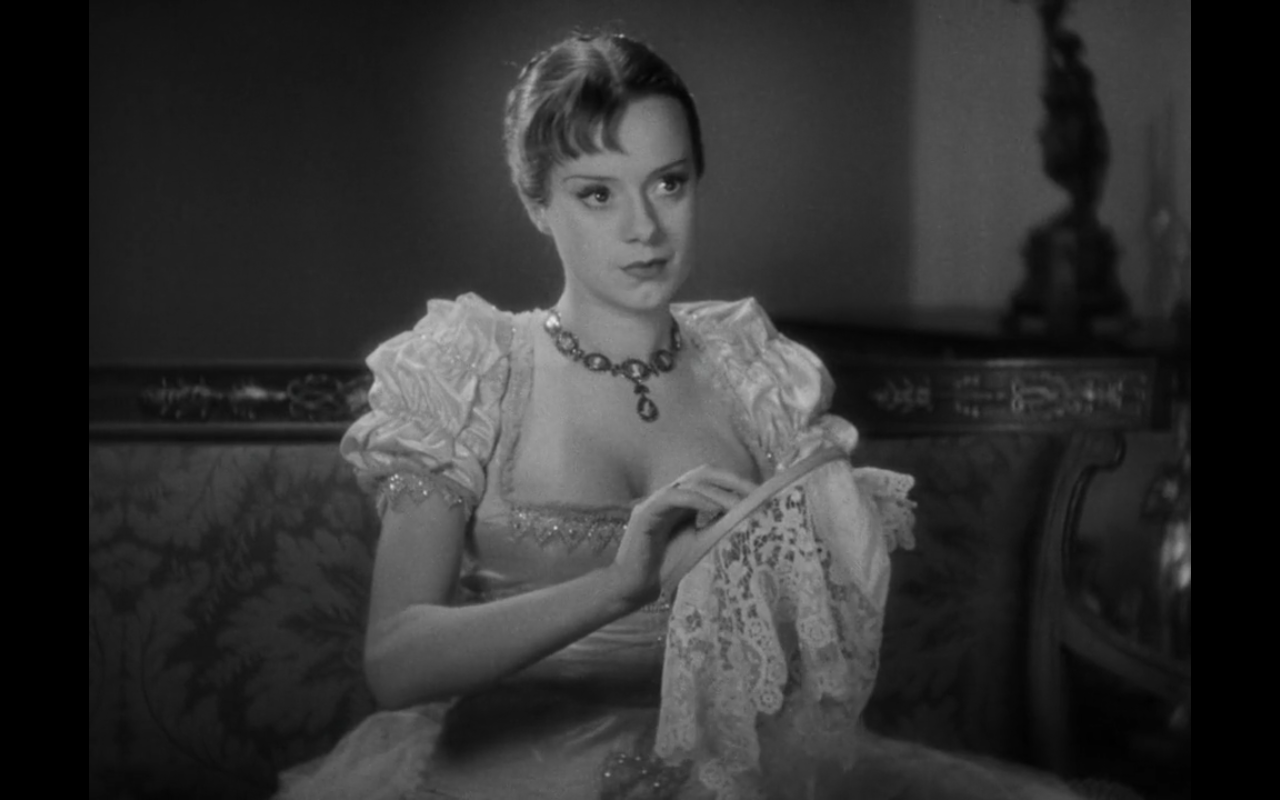
Above Elsa Lanchester as "Mary Shelley" in director James Whale's 1935 "The Bride of Frankenstein". Below Bridgette Fonda as "Mary Shelley" in director Roger Corman's 1990 "Frankenstein Unbound".


Above Elle Fanning as still "Mary Godwin" in director Haifaa al-Mansour's 2017 biographical film "Mary Shelley". Below Lili Miller as "Mary Shelley" in a 2020 episode of the BBC's 13th "Dr. Who"entitled "The Haunting of Villa Diodati".

A Little Background
At the time of the writing of this article I identified 89 "Frankenstein" features. These are made up of either live action or animated motion pictures and three television series. I know there are more movies especially in countries other than the United States, the United Kingdom and Australia. These are hard to identify, as the "Frankenstein" is never mentioned in the films title. Such a variation of Mary Shelley's story is the 1953 Mexican motion picture "El Monstruo resucitado (The Revived Monster)".

I am not going to discuss every film, or television program I have identified between 1910 and 2019. While I may mention some films in passing. I have chosen 21 examples to go into detail to some degree.
However, I would advise my reader not to think that a motion picture with the name "Frankenstein" in the title is actually about either the doctor, or his creation.
An example, is "Frankenstein und die Ungeheuer aus dem Meer (Frankenstein and the Monster from the Sea)". The German's have a love for Mary Shelley's character and re-title many Foreign made Science Fiction and Horror films, when dubbed or subtitled and distributed in Germany, using the name "Frankenstein" in the title.
In this particular case the German's turn "Godzilla" into "Frankenstein's Monster". In the German distributed version of "Gojira, Ebirah, Mosura: Nankai No Dai Ketto (Godzilla, Ebirah, Mothra: Big Duel In The South Sea)" aka: "Ebirah, Horror of the Deep" aka: "Godzilla vs the Sea Monster".

It all began on March 18, 1910, when the first motion picture version of Mary Shelley's novel was released. "FRANKENSTEIN" was produced by Thomas Edison and directed by J. Searle Dawley. The short silent film starred Augustus Phillips as "Dr. Frankenstein", Charles Ogles as "The Monster" and Mary Fueller as "Elizabeth". "The Edison KINETOGRAM" ran 14 minutes.

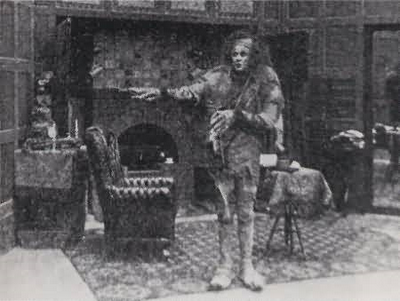
There would be two other silent motion pictures.
"Life Without A Soul" was shot in Georgia and is about "Brute Man", played by Percy Standing. He murders the sister of his creator "Dr. William Frawley", played by William A. Cohill. Next the audience sees "Dr. Frawley" chasing his creation across Europe, still filmed in Georgia, and catching up to "Brute Man". "Frawley" shoots and kills him, but "Dr. Frawley" dies from exhaustion after taking his revenge. The film ends with actor Percy Standing waking up from a dream and it's revealed he has been reading the Shelley novel.

While the second "Il mostro di Frankenstein( The Monster of Frankenstein)" was a 1920 Italian version of the novel. The producer Luciano Albertini also portrayed "Baron Frankenstein" and Umberto Guarracino, seen below, portrayed "The Monster".
Then came the sound era.
His name was Carl Laemmle, Jr. and he had been born in Chicago, Illinois, in 1908. His father founded and owned "Universal Pictures". "Junior", as he was referred too around the studio, convinced "Senior" to let him produce one Horror movie. Which "Senior" thought would be a waste of the studio's funds and forgotten, but gave in to his son.
It would be Laemmle, Jr., that started what became the Universal Studio Horror legacy. He would be stopped, when his father was forced into selling his controlling interest in the studio on April 22, 1936.
"Junior's" First feature, released in 1931, was actually Two. During the day Tod Browning directed the unknown Bela Lugosi as "Dracula". While, at night, the forgotten George Melford directed the far superior Spanish language version of Bram Stoker's novel using the same sets at night.

Both versions of "Dracula" were successes for the young producer and he was able to get his father to authorized an adaption of Mary Wollstonecraft Shelley's novel.
His name was James Whale and he had been born in the town of Dudley, Worcestershire, England, in 1889. Whale would direct three classic Universal Horror films and two were based upon the Shelley novel.
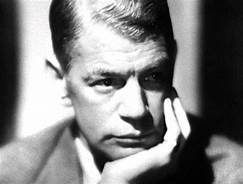
His name was William Henry Pratt and he was born in the town of Camberwell, Surrey, England, in 1887. Pratt would be known by his stage name of Boris Karloff and become a Horror Film Icon starting with his immortal portrayal of Mary Shelley's monster.
His name was Carl Laemmle, Jr. and he had been born in Chicago, Illinois, in 1908. His father founded and owned "Universal Pictures". "Junior", as he was referred too around the studio, convinced "Senior" to let him produce one Horror movie. Which "Senior" thought would be a waste of the studio's funds and forgotten, but gave in to his son.
It would be Laemmle, Jr., that started what became the Universal Studio Horror legacy. He would be stopped, when his father was forced into selling his controlling interest in the studio on April 22, 1936.
"Junior's" First feature, released in 1931, was actually Two. During the day Tod Browning directed the unknown Bela Lugosi as "Dracula". While, at night, the forgotten George Melford directed the far superior Spanish language version of Bram Stoker's novel using the same sets at night.

Both versions of "Dracula" were successes for the young producer and he was able to get his father to authorized an adaption of Mary Wollstonecraft Shelley's novel.
His name was James Whale and he had been born in the town of Dudley, Worcestershire, England, in 1889. Whale would direct three classic Universal Horror films and two were based upon the Shelley novel.
His name was William Henry Pratt and he was born in the town of Camberwell, Surrey, England, in 1887. Pratt would be known by his stage name of Boris Karloff and become a Horror Film Icon starting with his immortal portrayal of Mary Shelley's monster.
His name was Jack P. Pierce and he was born in Valdetsyou, Greece, in 1889. Pierce had been a make-up artist for Universal Pictures since 1925. His first Horror make-up was for actor Conrad Veidt in 1925's "The Man Who Laughs" and his second was the entire cast of Tod Browning's 1931 "Dracula". Except for Bela Lugosi, who demanded to do his own.
Now for Carl Laemmle, Jr's second Horror movie. Jack Pierce was, like Karloff, about to become immortal by creating the monster's make-up.
My article, "Jack P. Pierce the Man Who Created Monsters", can be read at:
http://www.bewaretheblog.com/2015/06/jack-p-pierce-man-who-created-monsters.html
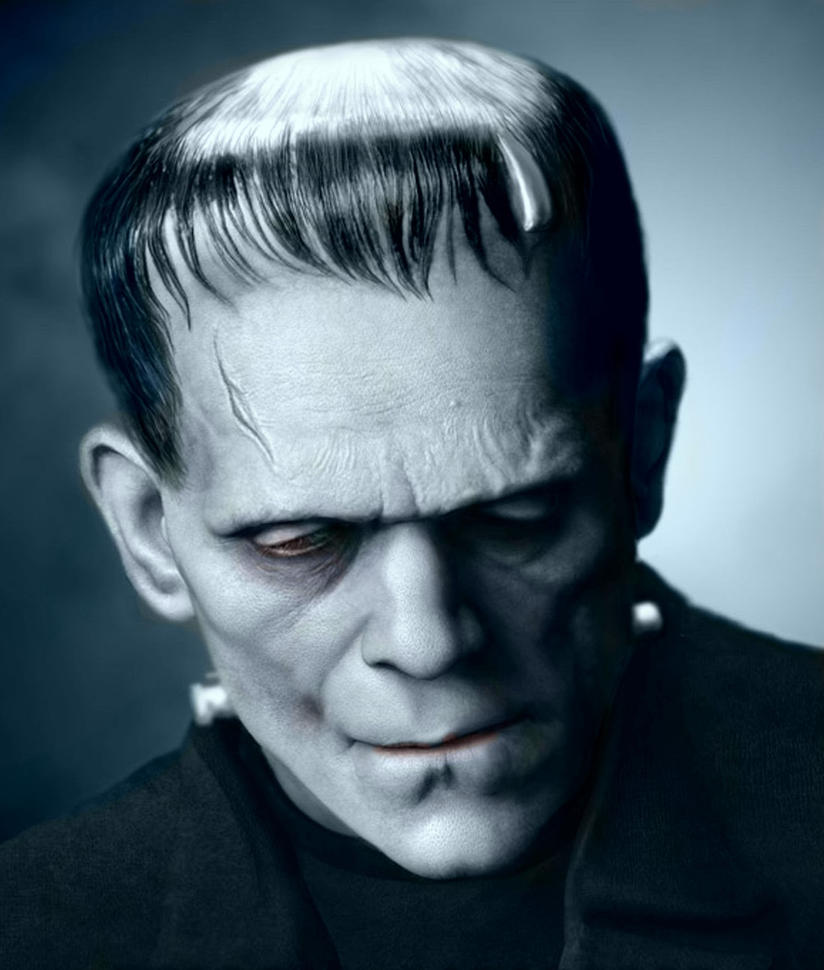
My article of the work of Jack Pierce and his firing from Universal Studio's "Jack P. Pierce the Man Who Created Monsters"can be read at:
http://www.bewaretheblog.com/2015/06/jack-p-pierce-man-who-created-monsters.html
The screenplay was based upon another British play, the 1927 "Frankenstein", by Peggy Webling. It should be noted that her play was the first time the name "FRANKENSTEIN!" was associated with both the doctor and the monster.
Peggy Webling's play "Dracula", had been the basis for the screenplay for the 1931 Universal motion picture. Both her "Dracula" and "Frankenstein" plays had been adapted by John L. Balderston to work as a movie script. Among his other work, Balerston would write the actual screenplay for Karloff's 1932 "The Mummy" and create the story for 1936's "Dracula's Daughter".
The actual "Frankenstein" screenplay was co-written by Garret Fort. Fort had written the 1929 screenplay "The Return of Sherlock Holmes" and the screenplays for both 1936's "Dracula's Daughter" and Tod Browning's "Devil Doll".
Fort's co-writer was Francis Edward Faragoh. Two of Faragoh's major screenplays are the Edward G. Robinson 1931 gangster picture "Little Caesar" and the 1943 children's classic "My Friend Flicka".
As the above poster indicates Boris Karloff was not the star of the picture.
Colin Clive was the film's star. Clive portrayed not "Victor", but "Henry Frankenstein". The name change was a result of Peggy Webling's play. In 1935 Clive would repeat his role of "Henry Frankenstein" in James Whale's "The Bride of Frankenstein" and that same year. Colin Clive would appear as "Stephen Orlac" in the Peter Lorre thriller "Mad Love". The actor was an alcoholic and he died in 1937 at the age of 37 from a combination of alcoholism and tuberculous.
Mae Clarke portrayed "Elizabeth". Clarke would not return for the sequel. Clarke's motion picture career started by co-starring in 1929's "Big Time". However, 1931 was a weird year for her as she dropped to 7th billing in the original movie version of Ben Height's Broadway play, "The Front Page". Then Mae Clarke appeared, without on-screen credit, in James Cagney's "Public Enemy". Still in 1931 she would star in the original "Waterloo Bridge" and co-star in this feature film. In 1942 Clarke's fortunes had begin to drop and she was billed sixth in John Wayne's "Flying Tigers". In 1949 Mae Clarke co-starred in the classic Republic Picture serial "King of the Rocket Man". That was. once more, followed by roles without on-screen credit and finally Mae Clarke started appearing on early television programs.

Above Colin Clive as "Henry Frankenstein" and Mae Clarke as "Elizabeth".
John Boles portrayed "Victor Moritz". Boles was a solid "B" and at times "A" list actor. Among his films are the original 1928 "The Shepherd of the Hills". John Wayne would remake the film in 1941. John Boles co-starred with Irene Dunne in 1932's "Back Street", co-starred with Shirley Temple in 1935's "Curly Top" and with Barbara Stanwyck in 1937's "Stella Dallas".
http://www.bewaretheblog.com/2015/06/jack-p-pierce-man-who-created-monsters.html

My article of the work of Jack Pierce and his firing from Universal Studio's "Jack P. Pierce the Man Who Created Monsters"can be read at:
http://www.bewaretheblog.com/2015/06/jack-p-pierce-man-who-created-monsters.html
The screenplay was based upon another British play, the 1927 "Frankenstein", by Peggy Webling. It should be noted that her play was the first time the name "FRANKENSTEIN!" was associated with both the doctor and the monster.
Peggy Webling's play "Dracula", had been the basis for the screenplay for the 1931 Universal motion picture. Both her "Dracula" and "Frankenstein" plays had been adapted by John L. Balderston to work as a movie script. Among his other work, Balerston would write the actual screenplay for Karloff's 1932 "The Mummy" and create the story for 1936's "Dracula's Daughter".
The actual "Frankenstein" screenplay was co-written by Garret Fort. Fort had written the 1929 screenplay "The Return of Sherlock Holmes" and the screenplays for both 1936's "Dracula's Daughter" and Tod Browning's "Devil Doll".
Fort's co-writer was Francis Edward Faragoh. Two of Faragoh's major screenplays are the Edward G. Robinson 1931 gangster picture "Little Caesar" and the 1943 children's classic "My Friend Flicka".
As the above poster indicates Boris Karloff was not the star of the picture.
Colin Clive was the film's star. Clive portrayed not "Victor", but "Henry Frankenstein". The name change was a result of Peggy Webling's play. In 1935 Clive would repeat his role of "Henry Frankenstein" in James Whale's "The Bride of Frankenstein" and that same year. Colin Clive would appear as "Stephen Orlac" in the Peter Lorre thriller "Mad Love". The actor was an alcoholic and he died in 1937 at the age of 37 from a combination of alcoholism and tuberculous.
Mae Clarke portrayed "Elizabeth". Clarke would not return for the sequel. Clarke's motion picture career started by co-starring in 1929's "Big Time". However, 1931 was a weird year for her as she dropped to 7th billing in the original movie version of Ben Height's Broadway play, "The Front Page". Then Mae Clarke appeared, without on-screen credit, in James Cagney's "Public Enemy". Still in 1931 she would star in the original "Waterloo Bridge" and co-star in this feature film. In 1942 Clarke's fortunes had begin to drop and she was billed sixth in John Wayne's "Flying Tigers". In 1949 Mae Clarke co-starred in the classic Republic Picture serial "King of the Rocket Man". That was. once more, followed by roles without on-screen credit and finally Mae Clarke started appearing on early television programs.

Above Colin Clive as "Henry Frankenstein" and Mae Clarke as "Elizabeth".
John Boles portrayed "Victor Moritz". Boles was a solid "B" and at times "A" list actor. Among his films are the original 1928 "The Shepherd of the Hills". John Wayne would remake the film in 1941. John Boles co-starred with Irene Dunne in 1932's "Back Street", co-starred with Shirley Temple in 1935's "Curly Top" and with Barbara Stanwyck in 1937's "Stella Dallas".
Above John Boles.
Boris Karloff was fourth billed as "The Monster". Karloff had been acting since 1919 and appeared in 76 feature films before "Frankenstein". The direction of his career was about to change with this picture. Often overshadowed by his Horror entries are two outstanding 1934 feature films. The first was a World War One story directed by John Ford entitled "The Lost Patrol". It starred Victor McLaglen, Boris Karloff and Wallace Ford. The second followed immediately, and was "The House of Rothchild". This historical drama about the founding of the London Banking Company starred George Arliss, Boris Karloff, Loretta Young and Robert Young.
To illustrate my point about his Horror films overshadowing his other work is just prior to "The Lost Patrol". Boris Karloff had appeared in the Gaumont British production, for August 1933, "The Ghoul". While "The House of Rothchild" had been followed by Universal's first pairing of Karloff and Lugosi, 1934's "The Black Cat".

Dwight Frye portrayed "Fritz" and on the poster for the feature is listed with 5th billing. However, on the official cast listing Frye is listed 7th. The change was because Frye had just been seen as "Renfield" in Universal's "Dracula" and as "Wilmer Cook" in the original version of "The Maltese Falcon". The Universal Pictures Publicity Department was looking for name recognition to lure in potential audiences. The character of "Fritz" was in the screenplay, again, because of Peggy Webling's play.
Neither Richard Brinsley Peake, or Peggy Webling's plays has "Fritz" as a hunchback. This was something Universal Pictures came up with for a visual.
After Bela Lugosi's portrayal of the Shepard "Ygor" in 1939's "Son of Frankenstein". The doctor's assistant morphed from "Fritz" to "Igor" in future filmed versions of Mary Shelley's novel.
My article "DWIGHT FRYE: Overlooked Horror Icon" can be found at:
http://www.bewaretheblog.com/search?q=dwight+frye
Boris Karloff was fourth billed as "The Monster". Karloff had been acting since 1919 and appeared in 76 feature films before "Frankenstein". The direction of his career was about to change with this picture. Often overshadowed by his Horror entries are two outstanding 1934 feature films. The first was a World War One story directed by John Ford entitled "The Lost Patrol". It starred Victor McLaglen, Boris Karloff and Wallace Ford. The second followed immediately, and was "The House of Rothchild". This historical drama about the founding of the London Banking Company starred George Arliss, Boris Karloff, Loretta Young and Robert Young.
To illustrate my point about his Horror films overshadowing his other work is just prior to "The Lost Patrol". Boris Karloff had appeared in the Gaumont British production, for August 1933, "The Ghoul". While "The House of Rothchild" had been followed by Universal's first pairing of Karloff and Lugosi, 1934's "The Black Cat".

Dwight Frye portrayed "Fritz" and on the poster for the feature is listed with 5th billing. However, on the official cast listing Frye is listed 7th. The change was because Frye had just been seen as "Renfield" in Universal's "Dracula" and as "Wilmer Cook" in the original version of "The Maltese Falcon". The Universal Pictures Publicity Department was looking for name recognition to lure in potential audiences. The character of "Fritz" was in the screenplay, again, because of Peggy Webling's play.
Neither Richard Brinsley Peake, or Peggy Webling's plays has "Fritz" as a hunchback. This was something Universal Pictures came up with for a visual.
After Bela Lugosi's portrayal of the Shepard "Ygor" in 1939's "Son of Frankenstein". The doctor's assistant morphed from "Fritz" to "Igor" in future filmed versions of Mary Shelley's novel.
My article "DWIGHT FRYE: Overlooked Horror Icon" can be found at:
http://www.bewaretheblog.com/search?q=dwight+frye
The real 5th billed actor was Edward Van Sloan portraying "Doctor Waldman". Van Sloan had just been "Professor Van Helsing" in "Dracula". He would repeat that role in 1936's "Dracula's Daughter". In 1932 Van Sloan would again be cast with Boris Karloff in "The Mummy".
On that cast listing between 5th placed Edward Van Sloan and 7th placed Dwight Frye was 6th placed Frederick Kerr portraying "Baron Frankenstein", "Henry's" father. On the above original poster for the picture Kerr is billed 7th. Kerr was considered a very forceful character actor starting in 1916. He would only appear twice more after this feature.

Before the story begins the studio had an interesting way to get around the motion picture censors at the time. Even though this picture was a Pre-Motion Picture Code entry.
Before the opening credits, the movie audience sees a theater curtain and out of it comes Edward Van Sloan.


He then proceeds to deliver the following warning to the theater audience:
The setting is the Bavarian Alps. In an unnamed village young "Henry Frankenstein's" wedding to "Elizabeth" is approaching, but the audience sees "Henry" and the hunchback "Fritz" digging up a body for his experiments. Next the two get another of a man who had just been hanged.





At a nearby medical school "Dr. Waldman" is showing his students two brains. He points out the differences between a "Normal Brain" and a "Dysfunctional Brain" for comparison.



That night "Henry Frankenstein" sends "Fritz" to the school. He is to bring the "Normal Brain" back to "Henry".


"Fritz", famously, drops the "Normal Brain" and substitutes the "Dysfunctional Brain".
Cut to "Elizabeth" speaking to "Victor Moritz", a friend of "Henry" about his odd behavior lately.

Before the story begins the studio had an interesting way to get around the motion picture censors at the time. Even though this picture was a Pre-Motion Picture Code entry.
Before the opening credits, the movie audience sees a theater curtain and out of it comes Edward Van Sloan.


He then proceeds to deliver the following warning to the theater audience:
How do you do? Mr. Carl Laemmle feels it would be a little unkind to present this picture without just a word of friendly warning: We are about to unfold the story of Frankenstein, a man of science who sought to create a man after his own image without reckoning upon God. It is one of the strangest tales ever told. It deals with the two great mysteries of creation; life and death. I think it will thrill you. It may shock you. It might even horrify you. So, if any of you feel that you do not care to subject your nerves to such a strain, now's your chance to uh, well,––we warned you.
The setting is the Bavarian Alps. In an unnamed village young "Henry Frankenstein's" wedding to "Elizabeth" is approaching, but the audience sees "Henry" and the hunchback "Fritz" digging up a body for his experiments. Next the two get another of a man who had just been hanged.





At a nearby medical school "Dr. Waldman" is showing his students two brains. He points out the differences between a "Normal Brain" and a "Dysfunctional Brain" for comparison.



That night "Henry Frankenstein" sends "Fritz" to the school. He is to bring the "Normal Brain" back to "Henry".


"Fritz", famously, drops the "Normal Brain" and substitutes the "Dysfunctional Brain".
Cut to "Elizabeth" speaking to "Victor Moritz", a friend of "Henry" about his odd behavior lately.
The two go to "Dr. Waldman" for help understanding "Henry's" weird actions and the three go to "Frankenstein's" laboratory. Their arrival at his laboratory upsets "Henry" for the moment, but he finally reveals his creation. That is only awaiting the electricity "Henry Frankenstein" believes will bring it to life.
As a storm starts to rage, to the three visitors, "Henry Frankenstein" seems obsessed with his impossible deed of bringing life to a dead body. At one point his rantings seem almost that of an insane man and he needs to be restrained.

Under control once more of his emotions. The three visitors watch as "Henry" and "Fritz" use the storm to bring electricity into the created body.


The body first raised into the storm and then brought back down. "Henry Frankenstein" then goes over to examine it.

After "Henry Frankenstein's" examination, actor Colin Clive delivers two of the most famous words in Horror movie history.
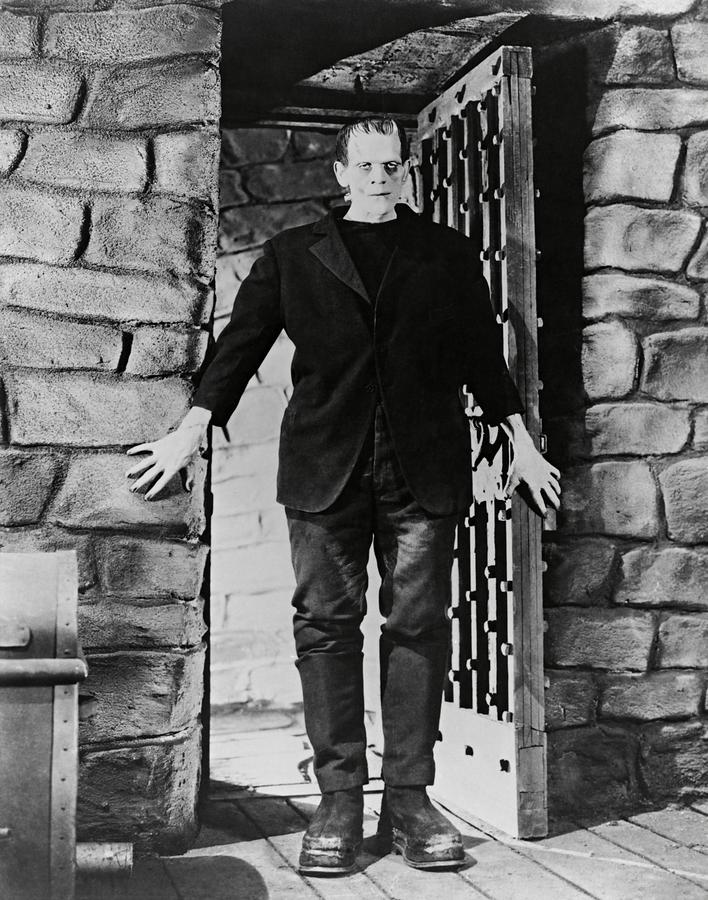
"Henry" and "Dr. Waldon" open the skylight and the monster reaches for it. Boris Karloff''s monster seems a newborn child and so innocent. Full credit goes to the actor for making the "Monster", perhaps more "Human" then its creator.
Suddenly, "Fritz" comes toward the monster with a torch and the fire frightens it. Later with the monster chained to the wall "Fritz" torments it with another flaming torch.

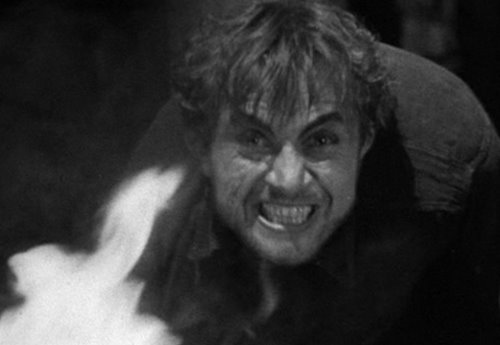
"Henry" and "Dr. Waldon" are discussing what to do with the monster. When a high pitch scream is heard and they find "Fritz" dead from the hands of the monster. Now realizing his creation must be destroyed. "Henry Frankenstein" prepares an injection that will kill it.

The door to its cell is unlocked and the monster comes out and lunges at both "Frankenstein" and "Waldman". As "Henry" fights he is able to inject his creation and the monster falls to the floor. So, also, does "Henry Frankenstein" from exhaustion.

"Elizabeth" and the "Baron" arrive and take his son back to the family home for bed rest. "Henry" is still worried about the monster, but "Dr. Waldman" tells him not to worry. "Dr. Waldman" returns to the monster's cell and makes preparations to cut it into pieces, but is killed instead..
The monster escapes and again Boris Karloff's performance of innocence takes a twist. When he meets the little girl, "Maria", throwing flowers into a lake.
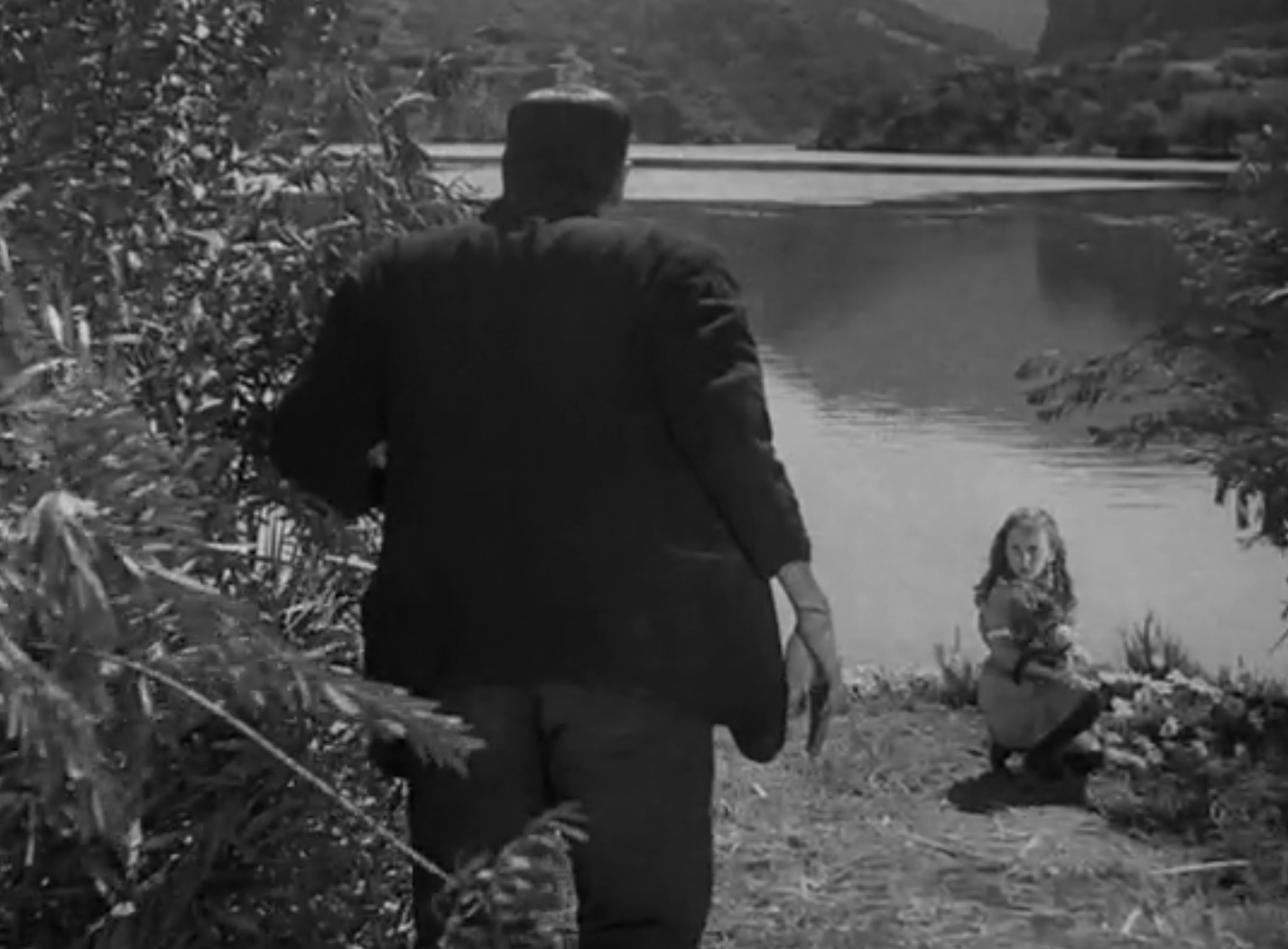
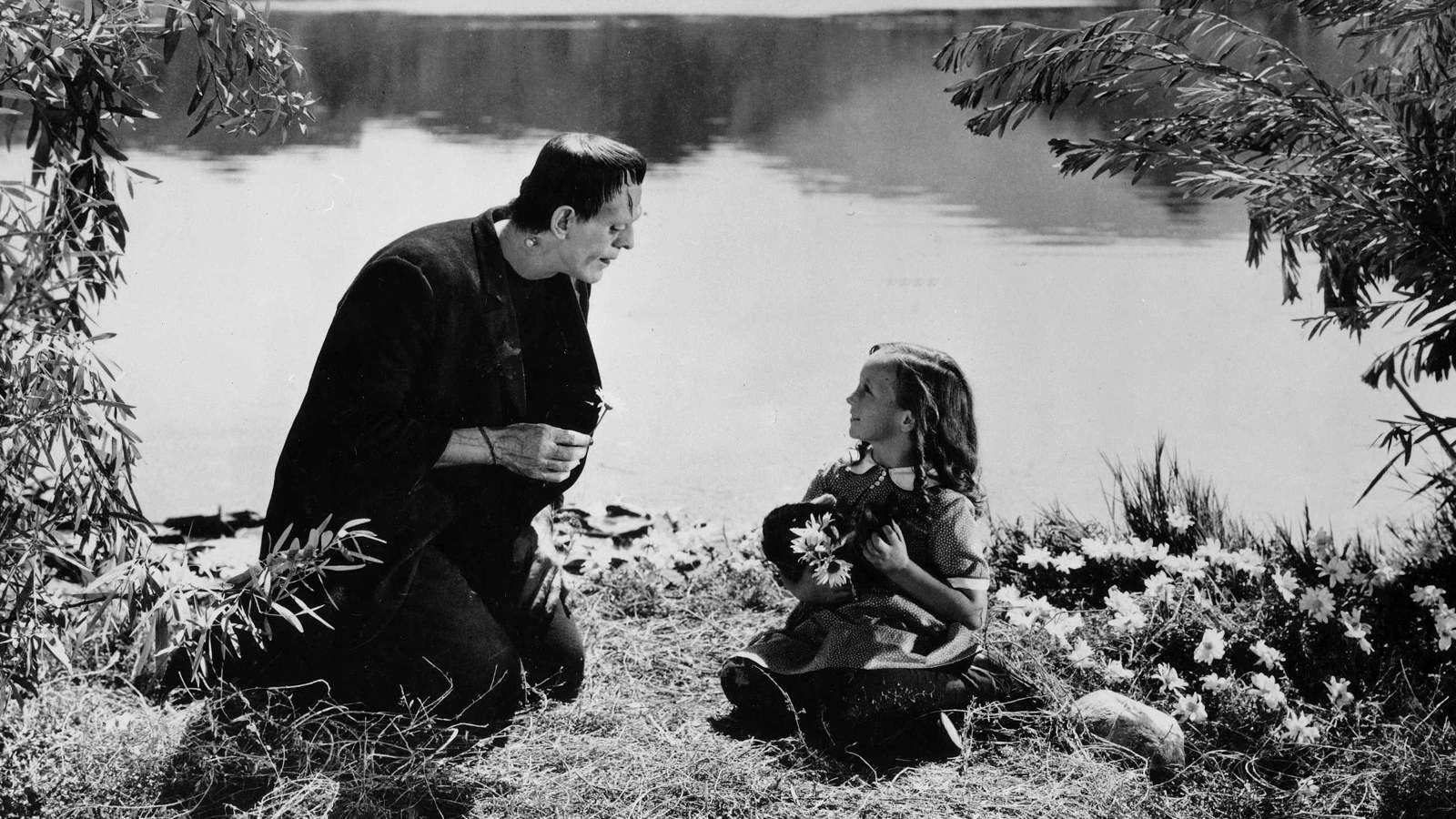

The child-like monster watches the girl's flowers float. He picks up a flower and repeats her actions with the same results. Then in its innocence, he picks up the little girl and shocked the audience. By throwing the girl into the lake to see her float like a flower. "Maria" drowns as the monster innocently confused walks away.
"Henry" and "Elizabeth" are finally happy again as they prepare for their wedding. "Victor" arrives to speak to "Henry". He tells him that "Dr. Waldon" is dead and the monster is now loose. While in her bedroom the monster enters "Elizabeth's" room.


"Elizabeth" lets out a scream---and when the others arrive. They find "Elizabeth" fainted upon her bed and the monster gone.

Back in the village, "Maria's" father arrives carrying her and the villagers go after the killer.

"Henry" joins the villagers to get his creation. They divide into three groups to cover the woods, the mountains and the lake area. "Henry Frankenstein" leads the group into the mountains.

As they search "Henry" gets separated from the others and confronts his creation.
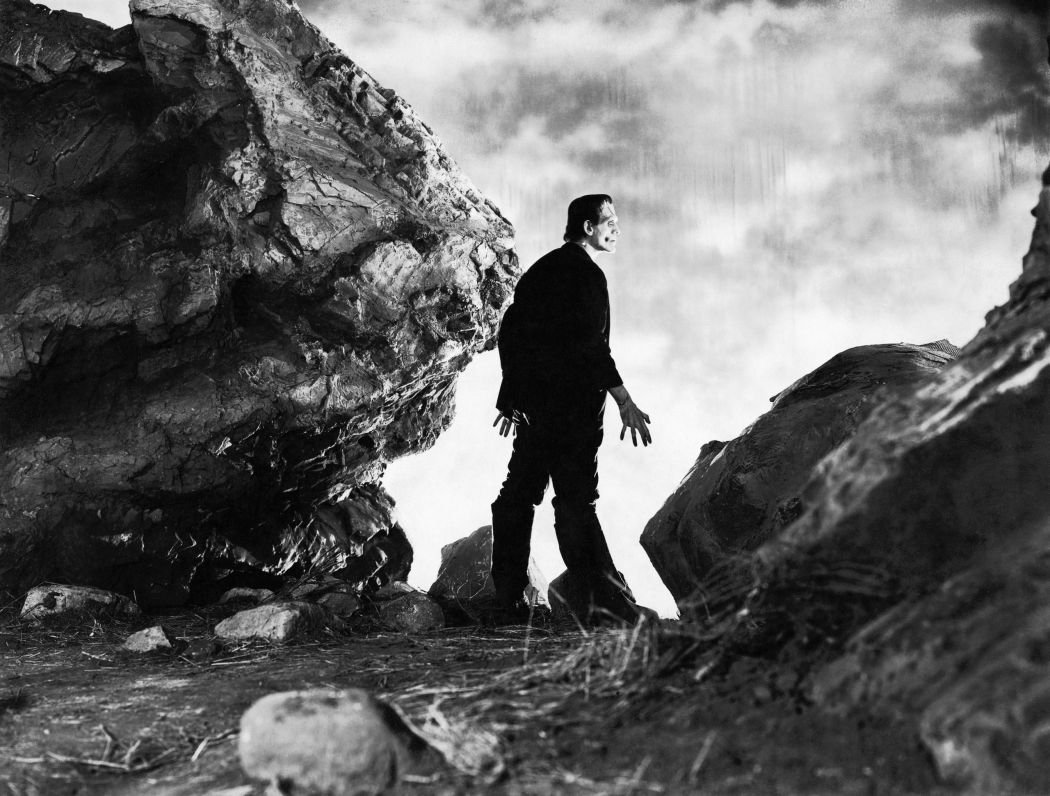
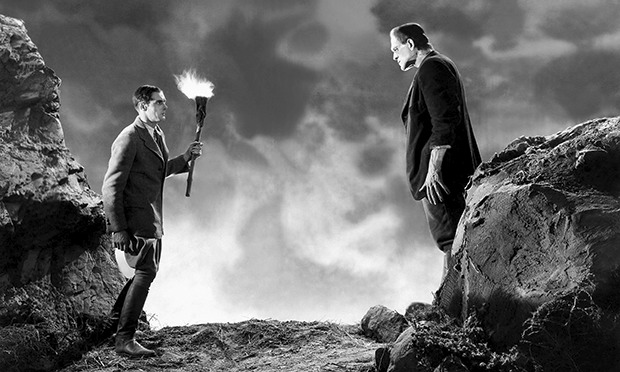
The monster knocks his creator unconscious and carries him to a windmill, dragging him up the stairs to the top, as the villagers arrive.
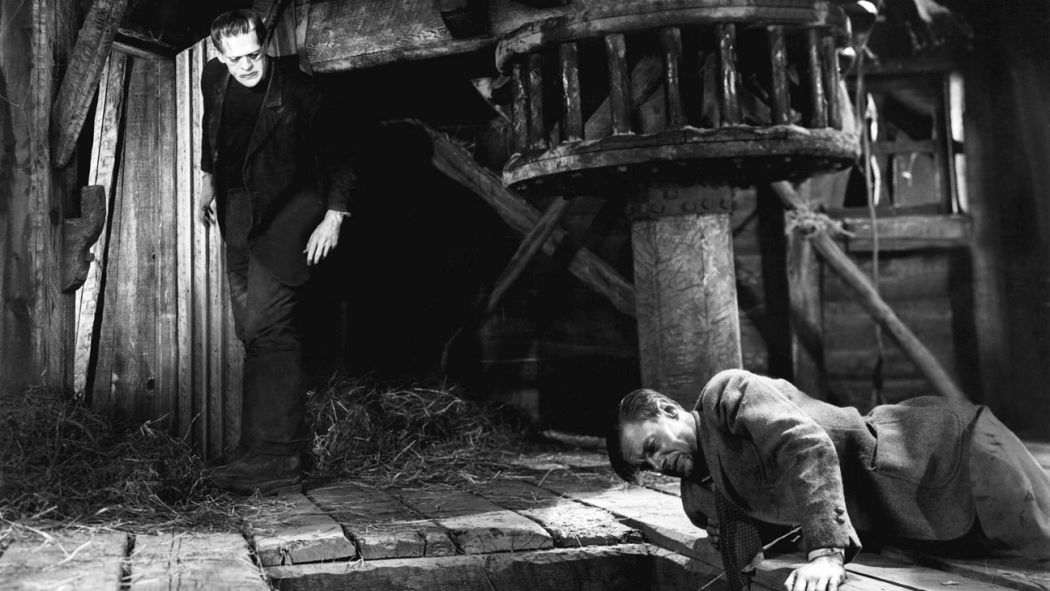

The villagers see the monster with "Henry" in its hands.
_NRFPT_03.jpg)
The monster tosses his creator over the balcony----

---but "Henry" gets caught on the windmill's vane and that saves his life. A group of villagers take "Henry Frankenstein" to his home and the others set fire to the windmill with the monster trapped inside.



Later the wedding is finally celebrated and the movie ends with the "Baron" proposing a toast to his future grandchild.
On April 19, 1935, producer Carl Laemmle, Jr. brought the audience what they wanted, a sequel to the original 1931 motion picture. Laemmle, Jr. wisely kept director James Whale on the project.

There are two points of interest on the above poster.
The first, is that only four years after playing the monster, in the 1931 motion picture, as a basically unknown actor. Boris Karloff was now so popular and recognizable. That the Universal Pictures Publicity Department just billed the actor as "KARLOFF!".
The second, read the added black stamp at the poster's bottom reading:
Since 1931's "Frankenstein", Boris Karloff had appeared in 17 feature films that included the four I had previously mentioned. As far as Horror-Thrillers, the others during the period included in 1932 "The Old Dark House", "The Mask of Fu Manchu" and "The Mummy".
There was another movie worth mentioning produced and directed by Howard Hawks for executive producer Howard Hughes. This was the original 1932 "Scarface" starring Paul Muni. On the official cast listing, Boris Karloff was in 8th position, but Howard Hughes was no dummy when it came to luring in audiences.
The poster for the motion picture moved him up three positions and billed him as:

Mae Clarke, as I mentioned, wasn't back for this film. The role of "Elizabeth" went to the Northern Ireland born actress Valerie Hobson. 1935 was a classic Universal Horror year for Hobson. Besides playing "Henry Frankenstein's" wife in "The Bride of Frankenstein". Valerie Hobson portrayed actor Henry Hull's wife in the first Universal werewolf motion picture "The Werewolf of London".

Above Valerie Hobson as "Elizabeth Frankenstein" and Colin Clive as "Henry Frankenstein".
Ernest Thesiger was the evil and deliciously over the top "Doctor Pretorius". Thesiger started acting in 1916. Prior to this picture he had been seen in director James Whale's 1932 "The Old Dark House" with Boris Karloff, Charles Laughter, Melvyn Douglas and Raymond Massey. Gaumont British's 1933 "The Ghoul" also with Karloff. In 1936 Theisger would co-star with Roland Young and Sir Ralph Richardson in one of only two motion pictures written by H.G. Wells "The Man Who Could Work Miracles".

Above Ernest Thesiger as "Dr. Pretorius" looking at the living shrunken people he created from chemicals.
A minor, but important character in the movie is "The Blind Hermit" portrayed by O.P Heggie. The segment is short, but it once again permitted Boris Karloff to show the humanity buried within "Henry's" creation and a wanting to be accepted.
The segment is important, because the monster learns to speak and understand the words "Friend" and "Good". Also to appreciate music and a good cigar, but the friendship between the "Blind Hermit" and the "Ugly Human" falls apart. When two hunters come across the "Friends". They react to what the monster based upon what he did in the past. Rather than what "The Friend" is now. The monster leaves and wanders around until he comes upon "Dr. Pretorius" in the perfect place an old mausoleum.

Above Karloff and O.P. Heggie enjoying the Hermit's violin playing. Below Ernest Thesiger and Boris Karloff becoming "Friends".
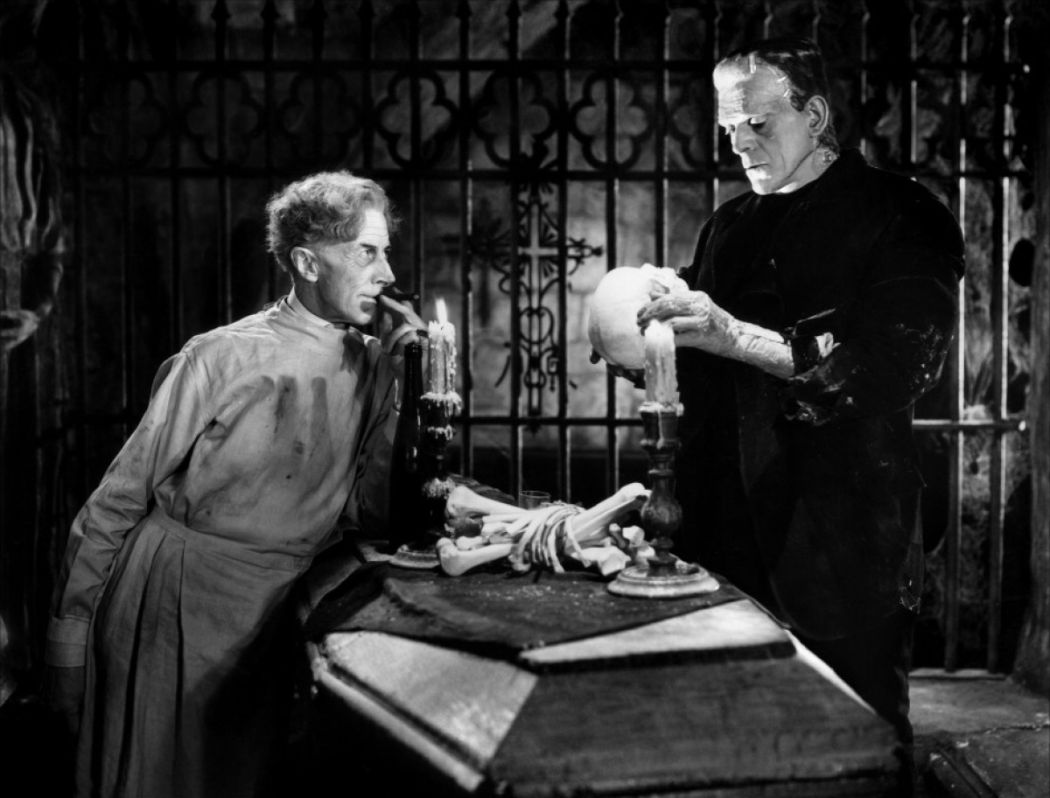
"Pretorius" convinces the monster that he needs his own "Friend" made like himself. Then "Pretorius" leaves the monster and goes to convince "Henry Frankenstein", that with his help, the two can create a women, a Bride for Frankenstein, referencing the monster in this instance.
At the start of this article I had a picture of London, England, born actress Elsa Lanchester as "Mary Wollstonecraft Shelley". In 1933 Lanchester co-starred as "Anne of Cleves" with her husband actor Charles Laughton in "The Private Life of Henry VIII". Besides portraying the authoress at the beginning of "The Bride of Frankenstein". Elsa Lanchester, in another immortal Jack Pierce make-up, was the title character.

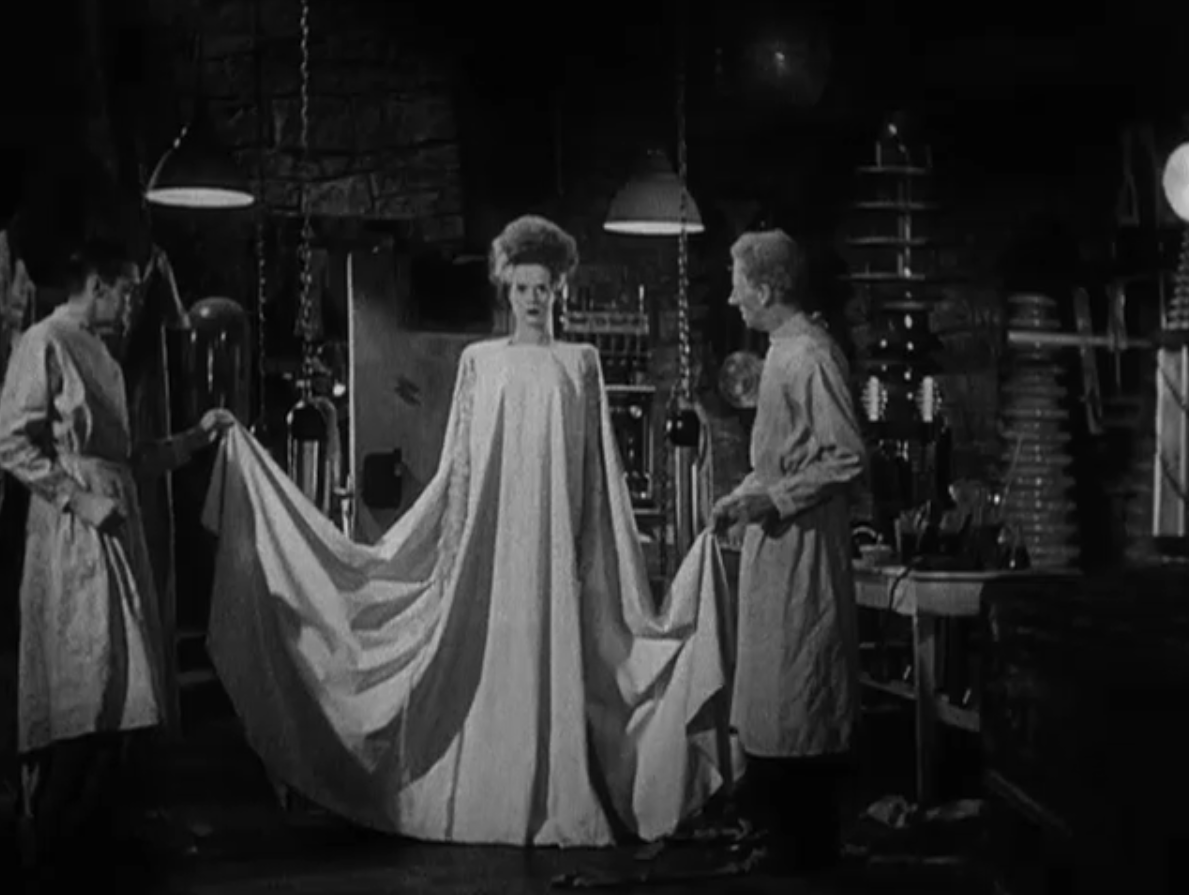
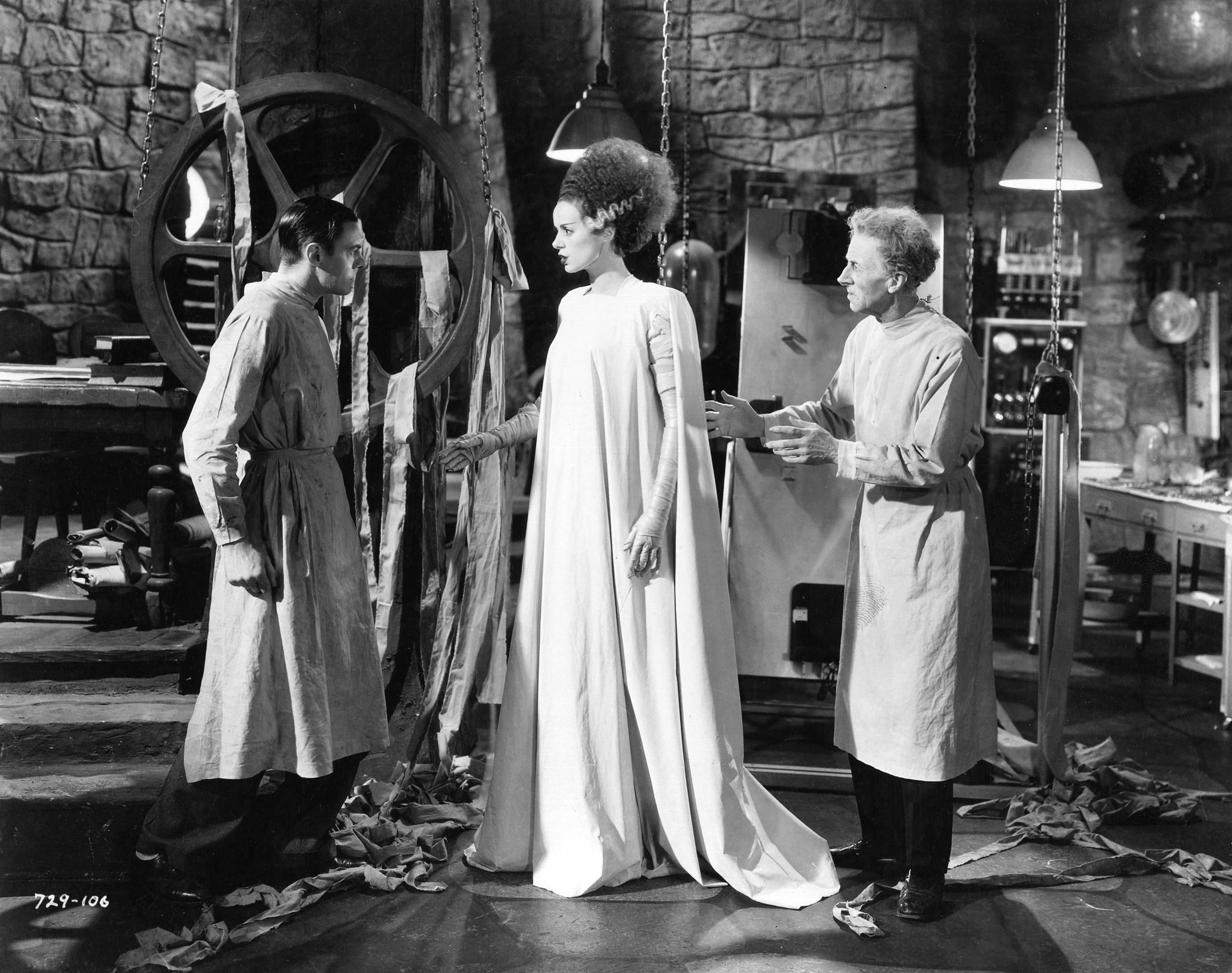
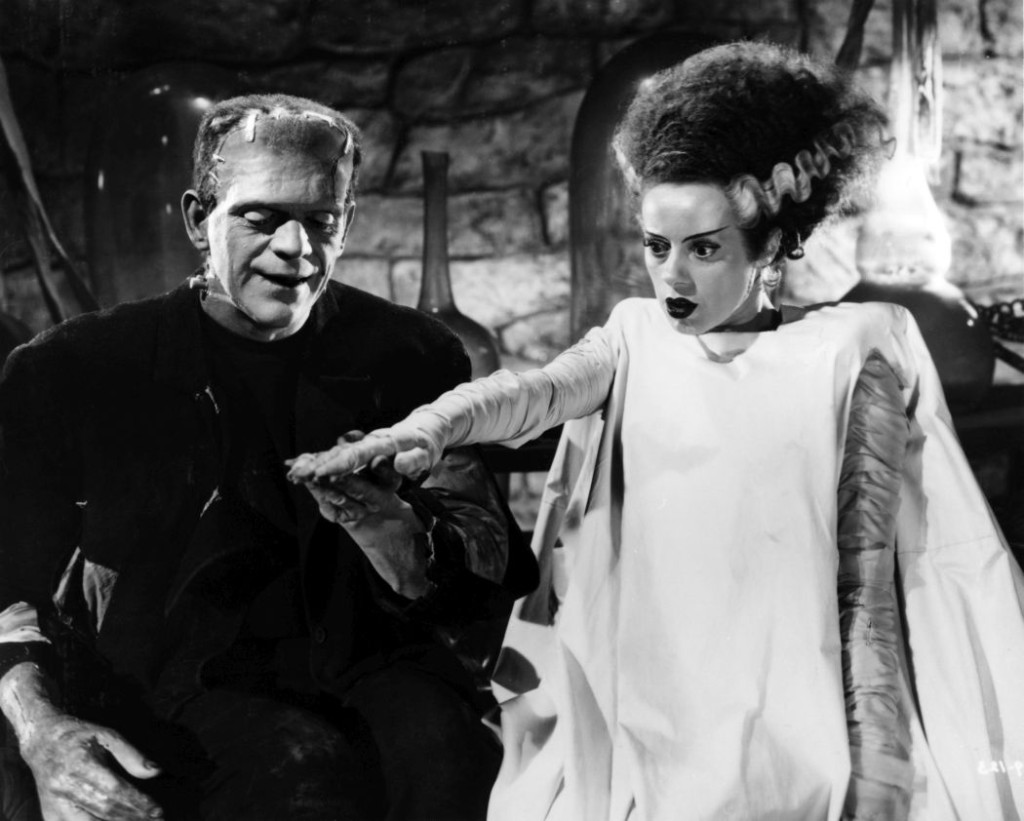

The film's climax takes place in "Henry's" original tower laboratory. Karloff's monster tells "Henry" and "Elizabeth":
On January 13, 1939 Universal Studio's released:

Under control once more of his emotions. The three visitors watch as "Henry" and "Fritz" use the storm to bring electricity into the created body.


The body first raised into the storm and then brought back down. "Henry Frankenstein" then goes over to examine it.

After "Henry Frankenstein's" examination, actor Colin Clive delivers two of the most famous words in Horror movie history.
IT'S ALIVE!Next Boris Karloff makes his entrance in another classic sequence. Karloff walks into the shot backwards, turns around, and James Whale's camera moves in for a close up of the monster's face.

"Henry" and "Dr. Waldon" open the skylight and the monster reaches for it. Boris Karloff''s monster seems a newborn child and so innocent. Full credit goes to the actor for making the "Monster", perhaps more "Human" then its creator.
Suddenly, "Fritz" comes toward the monster with a torch and the fire frightens it. Later with the monster chained to the wall "Fritz" torments it with another flaming torch.


"Henry" and "Dr. Waldon" are discussing what to do with the monster. When a high pitch scream is heard and they find "Fritz" dead from the hands of the monster. Now realizing his creation must be destroyed. "Henry Frankenstein" prepares an injection that will kill it.

The door to its cell is unlocked and the monster comes out and lunges at both "Frankenstein" and "Waldman". As "Henry" fights he is able to inject his creation and the monster falls to the floor. So, also, does "Henry Frankenstein" from exhaustion.

"Elizabeth" and the "Baron" arrive and take his son back to the family home for bed rest. "Henry" is still worried about the monster, but "Dr. Waldman" tells him not to worry. "Dr. Waldman" returns to the monster's cell and makes preparations to cut it into pieces, but is killed instead..
The monster escapes and again Boris Karloff's performance of innocence takes a twist. When he meets the little girl, "Maria", throwing flowers into a lake.



The child-like monster watches the girl's flowers float. He picks up a flower and repeats her actions with the same results. Then in its innocence, he picks up the little girl and shocked the audience. By throwing the girl into the lake to see her float like a flower. "Maria" drowns as the monster innocently confused walks away.
"Henry" and "Elizabeth" are finally happy again as they prepare for their wedding. "Victor" arrives to speak to "Henry". He tells him that "Dr. Waldon" is dead and the monster is now loose. While in her bedroom the monster enters "Elizabeth's" room.


"Elizabeth" lets out a scream---and when the others arrive. They find "Elizabeth" fainted upon her bed and the monster gone.

Back in the village, "Maria's" father arrives carrying her and the villagers go after the killer.

"Henry" joins the villagers to get his creation. They divide into three groups to cover the woods, the mountains and the lake area. "Henry Frankenstein" leads the group into the mountains.

As they search "Henry" gets separated from the others and confronts his creation.


The monster knocks his creator unconscious and carries him to a windmill, dragging him up the stairs to the top, as the villagers arrive.


The villagers see the monster with "Henry" in its hands.
_NRFPT_03.jpg)
The monster tosses his creator over the balcony----

---but "Henry" gets caught on the windmill's vane and that saves his life. A group of villagers take "Henry Frankenstein" to his home and the others set fire to the windmill with the monster trapped inside.



Later the wedding is finally celebrated and the movie ends with the "Baron" proposing a toast to his future grandchild.
On April 19, 1935, producer Carl Laemmle, Jr. brought the audience what they wanted, a sequel to the original 1931 motion picture. Laemmle, Jr. wisely kept director James Whale on the project.

There are two points of interest on the above poster.
The first, is that only four years after playing the monster, in the 1931 motion picture, as a basically unknown actor. Boris Karloff was now so popular and recognizable. That the Universal Pictures Publicity Department just billed the actor as "KARLOFF!".
The second, read the added black stamp at the poster's bottom reading:
Suitable Only For AdultsBringing up the question as to what part of the United States the picture was showing in? It would appear that local State Censors were involved here and not just the "Hayes Office" monitoring the new "Motion Picture Production Code".
Since 1931's "Frankenstein", Boris Karloff had appeared in 17 feature films that included the four I had previously mentioned. As far as Horror-Thrillers, the others during the period included in 1932 "The Old Dark House", "The Mask of Fu Manchu" and "The Mummy".
There was another movie worth mentioning produced and directed by Howard Hawks for executive producer Howard Hughes. This was the original 1932 "Scarface" starring Paul Muni. On the official cast listing, Boris Karloff was in 8th position, but Howard Hughes was no dummy when it came to luring in audiences.
The poster for the motion picture moved him up three positions and billed him as:
BORIS "Frankenstein" KARLOFFA good gimmick for an independently made motion picture distributed by "United Artists".

Mae Clarke, as I mentioned, wasn't back for this film. The role of "Elizabeth" went to the Northern Ireland born actress Valerie Hobson. 1935 was a classic Universal Horror year for Hobson. Besides playing "Henry Frankenstein's" wife in "The Bride of Frankenstein". Valerie Hobson portrayed actor Henry Hull's wife in the first Universal werewolf motion picture "The Werewolf of London".

Above Valerie Hobson as "Elizabeth Frankenstein" and Colin Clive as "Henry Frankenstein".
Ernest Thesiger was the evil and deliciously over the top "Doctor Pretorius". Thesiger started acting in 1916. Prior to this picture he had been seen in director James Whale's 1932 "The Old Dark House" with Boris Karloff, Charles Laughter, Melvyn Douglas and Raymond Massey. Gaumont British's 1933 "The Ghoul" also with Karloff. In 1936 Theisger would co-star with Roland Young and Sir Ralph Richardson in one of only two motion pictures written by H.G. Wells "The Man Who Could Work Miracles".

Above Ernest Thesiger as "Dr. Pretorius" looking at the living shrunken people he created from chemicals.
A minor, but important character in the movie is "The Blind Hermit" portrayed by O.P Heggie. The segment is short, but it once again permitted Boris Karloff to show the humanity buried within "Henry's" creation and a wanting to be accepted.
The segment is important, because the monster learns to speak and understand the words "Friend" and "Good". Also to appreciate music and a good cigar, but the friendship between the "Blind Hermit" and the "Ugly Human" falls apart. When two hunters come across the "Friends". They react to what the monster based upon what he did in the past. Rather than what "The Friend" is now. The monster leaves and wanders around until he comes upon "Dr. Pretorius" in the perfect place an old mausoleum.

Above Karloff and O.P. Heggie enjoying the Hermit's violin playing. Below Ernest Thesiger and Boris Karloff becoming "Friends".

"Pretorius" convinces the monster that he needs his own "Friend" made like himself. Then "Pretorius" leaves the monster and goes to convince "Henry Frankenstein", that with his help, the two can create a women, a Bride for Frankenstein, referencing the monster in this instance.
At the start of this article I had a picture of London, England, born actress Elsa Lanchester as "Mary Wollstonecraft Shelley". In 1933 Lanchester co-starred as "Anne of Cleves" with her husband actor Charles Laughton in "The Private Life of Henry VIII". Besides portraying the authoress at the beginning of "The Bride of Frankenstein". Elsa Lanchester, in another immortal Jack Pierce make-up, was the title character.





The film's climax takes place in "Henry's" original tower laboratory. Karloff's monster tells "Henry" and "Elizabeth":
Go! You Live!Turning to "Dr. Pretorius" and his bride. He tells both:
You stay! We belong dead!As "Henry" and "Elizabeth" run to safety. Karloff's monster shed's a tear and blows up the tower.
On January 13, 1939 Universal Studio's released:
The "Frankenstein Monster" was now immortal. "Son of Frankenstein" was also Boris Karloff's last film as the monster. He would be followed in the role once by Lon Chaney, Jr, and once by Bela Lugosi. For the last three films by Universal Pictures. One time rancher, deputy sheriff, rodeo performer and "B" Western heavy Glenn Strange, became the face used to make Halloween masks, artists interpretations of the monster and even the cover of Forrest J. Ackerman's "Famous Monsters of Filmland".
The last Glenn Strange appearance was in 1949 and for the next 8 years Mary Wollstonecraft Shelley's monster lay dormant on the motion picture screen until "The British Invasion".

The "House of Hammer" released "The Curse of Frankenstein" May 2, 1957 in the United Kingdom and on June 25, 1957 in the United States. That date was when 10 years old Lloyd first saw the film. I was sitting on the roof of our Van Nuys, California, home looking across another row of houses at the screen of the Sepulveda Drive-In theater without sound of course. When the creatures face was revealed, it just scared the ---- out of me. The following Saturday I was at the Van Nuys Movie Theater seeing the film with sound on a double bill with Hammer's "X-the Unknown".
In the U.K. the picture received an "Cert X". At the time that meant no one under 16 could see the movie, but no such age restriction was placed in the United States.
This was the first "Frankenstein" picture in Colour, or Color and the bright red blood flowed.
It was directed by Terrence Fisher. Fisher's name was about to be associated with Hammer Horror. Among Fisher's films, after this one, are 1958's "Dracula (Horror of Dracula)" and "Revenge of Frankenstein". In 1959 it was the "Sherlock Holmes" adventure "The Hound of the Baskervilles". Along with "The Man Who Could Cheat Death" and "The Mummy". In 1960 Fisher directed "The Brides of Dracula" and "The Two Faces of Dr. Jekyll (House of Fright)" and in 1961 he directed a favorite of mine "The Curse of the Werewolf". The was loosely based upon Guy Endore's classic "The Werewolf of Paris".
The screenplay was by Jimmy Sangster. Another name associated with the "Hammer Horror" of the period. His screenplays included 1956's "X-the Unknown", all the previously mentioned films except "Hound of the Baskervilles" and "Curse of the Werewolf.". Plus 1958's "Blood of the Vampire" and the motion picture screen version of the BBC mini-series "The Trollenberg Terror" aka in the United States as "The Crawling Eye". Next it was 1959's "Jack the Ripper" and 1961's "The Hellfire Club" (check out Marvel comics "The Dark Phoenix Saga").
The make-up for actor Christopher Lee was by Hammer Studio's Phillip Leakey. Among Leakey's work for "The House of Hammer" are 1955's "The Quartermass X-periment (The Creeping Unknown)", 1956's "X-the Unknown", 1957's "Quartermass 2 (Enemy from Space)" and "The Abominable Snowman (The Abominable Snowman of the Himalayas", "Cat Girl" which is Hammer's take-off on Val Lewton's classic 1942 "The Cat People".

My article on Phillip Leakey, Terrence Fisher, the "Quatermass" series and Hammer character actor Michael Ripper entitled:
"HAMMER FILMS: A Look at the 'House of Hammer' By an American Fan" can be discovered at:
http://www.bewaretheblog.com/2015/02/hammer-films-look-at-house-of-hammer.html
Peter Cushing portrayed "Victor Frankenstein". He had been acting since 1939 and was seen as "Osric" in Sir Lawrence Olivier's 1948 "Hamlet", director John Huston's 1952 "Moulin Rouge", and did battle in 1954 with Alan Ladd's "The Black Knight". Cushing portrayed "Winston Smith" in a live BBC Broadcast of George Orwell's "1984". That production is part of my article:
"GEORGE ORWELL'S '1984' and 'Animal Farm' in Motion Pictures and on Television" at:
http://www.bewaretheblog.com/2019/01/george-orwells-1984-and-animal-farm-in.html

Hazel Court portrayed "Elizabeth". She had been acting since 1944. Two of her motion pictures prior to this film are the 1953 Haunted House at sea "Ghost Ship" and the 1954 British Cult Science Fiction film "Devil Girl from Mars". In 1963 Hazel Court was in the Rodger Corman, Edgar Allan Poe movie "The Premature Burial" co-starring Ray Milland. Her next Corman film was 1963's "The Raven" with Vincent Price, Boris Karloff, Peter Lorre and an unknown Jack Nicholson. Court's final Poe appearance was in 1964's "The Masque of the Red Death".
My article:
"HAZEL COURT: Frankenstein's Bride and Roger Corman's Evil Lady" can be read at:
http://www.bewaretheblog.com/2017/06/hazel-court-frankensteins-bride-and.html

Robert Urquhart portrayed "Paul Krempe". Urquhart was a Scottish born character actor. Among his work was "Sir Gawaine" in the Robert Taylor, Ava Gardner and Mel Ferrer 1953 "Knights of the Round Table", "Sir Phillip" in the Errol Flynn and Joanne Dru 1955 "The Dark Avenger", but after this picture Robert Urquhart was primarily seen in period and historical BBC and ITV dramas.
Above Robert Urquhart and Peter Cushing.
Christopher Lee portrayed "The Creature". Among Lee's early work was as a "Palace Guard" in Sir Lawrence Olivier's 1948 "Hamlet". Making the film, technically, the first that Cushing and Lee appeared together. In 1952 Christopher Lee had a small supporting role in Burt Lancaster's "The Crimson Pirate". Most fans of Hammer Horror are very familiar with the teaming of Peter Cushing and Christopher Lee, but Lee spoke several languages fluently and appeared in several foreign language Horror and Thriller films as a result. My article:
"CHRISTOPHER LEE: Foreign Language Motion Pictures 1959 to 1970" can be found at:
http://www.bewaretheblog.com/2016/08/christopher-lee-foreign-language-motion.html
The motion picture opens in 19th Century Switzerland as "Baron Victor Frankenstein" awaits his execution. He tells a Priest his story.



His father was already dead and at the age of 15. "Victor's" mother dies and he becomes "Baron Frankenstein". His Aunt arrives with his cousin "Elizabeth" to ask if her monthly stipend will still come to her? "Victor" tells his aunt not to worry and the two leave.

"Victor" next posts an Employment Ad in several papers for a knowledgeable tutor. "Paul Krempe" becomes both and the young boy's only friend.

The story now advances an unspecified amount of years and Peter Cushing takes over the role of "Victor". The audience sees "Paul" and "Victor" working on a scientific experiment by bringing a dead puppy back to life.



After this success, "Victor" suggests that the two create a human body and bring it back to life. "Paul" is initially taken back, but agrees to assist.

The two men start to assemble a body from corpses.


Then, because her aunt has died, "Cousin Elizabeth" arrives, and "Paul" discovers she's "Victor's" fiancee. Tired with robbing graves and now with "Elizabeth's" arrival, "Paul" leaves.

"Victor" adds to his creation hands and eyes he purchased from a Charnel House.

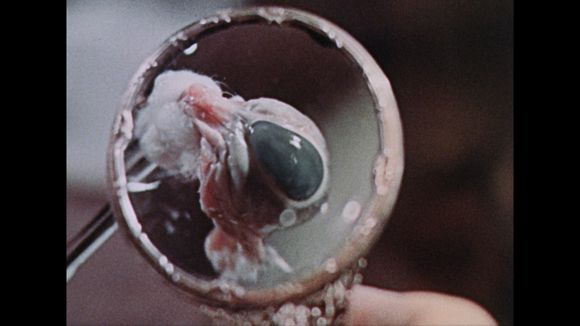
Now "Victor Frankenstein" needs a brain and invites a learned professor to his home for diner. To his surprise "Elizabeth" has invited "Paul". Causing "Victor" and to rethink his plan, but in the end the professor is pushed down a staircase as if by accident.

"Victor" goes to the crypt containing the dead professor to remove the brain, but was followed by "Paul". They struggle and the brain is damaged.

Returning to the house "Paul" attempts to convince "Elizabeth", for her safety, to leave the house. Meanwhile, up in his laboratory "Victor" puts the damaged brain into his creature and attempts to bring it to life.

It appears he has failed and "Victor" goes downstairs to speak to "Paul" and "Elizabeth". Suddenly, there is a noise from the laboratory and "Victor" runs upstairs to a great revealing sequence of what the creature looks like.
The sequence has Peter Cushing running into the laboratory to find Christopher Lee standing there looking like a "Mummy" and little knowing two years later he would play one.


Above Lee reaches to one end of the bandage covering his face and pulls it off, cut immediately to an extreme close-up for the creature's face.

Then the following takes place between "Victor Frankenstein" and "The Creature".

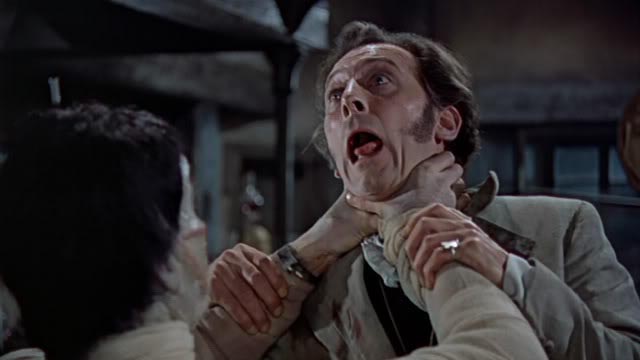
"Victor" gets control of the creature after it collapses. It's still too weak from being brought to life and "Victor" locks it up. However, the creature escapes into the woods and kills a blind man. "Victor" takes "Paul" with him and they go after his creation. As it attack the creature is shot by "Paul" and both men bury it. To "Paul" the nightmare is over.


"Paul" leaves again and "Victor" digs up the creature and returns to his laboratory.
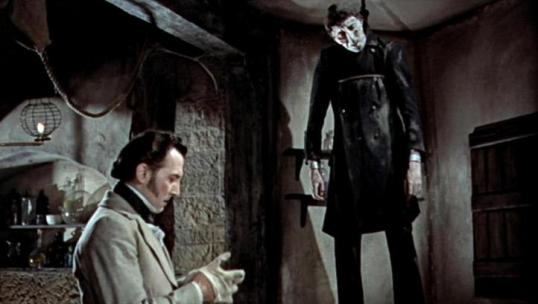
"Victor" initially revives the creature and chains him up. He leaves the house and upon his return is met by the servant girl, "Justine", who claims she's pregnant from "Victor" and demands to be his wife.
"Justine's" has been curious about what's going on in the laboratory. "Victor" tell her she can assist him in the laboratory and to come upstairs. Unlocking the door "Justine" enters and "Victor" immediately closes and locks it back up. Inside the creature appears and kills the girl.
"Victor" puts "Justine's" body into a vat of acid. Again at the invitation of "Elizabeth", "Paul" returns on the eve of her marriage to "Victor". "Victor" shows "Paul" the revived creature and explains he has performed surgery on its brain.
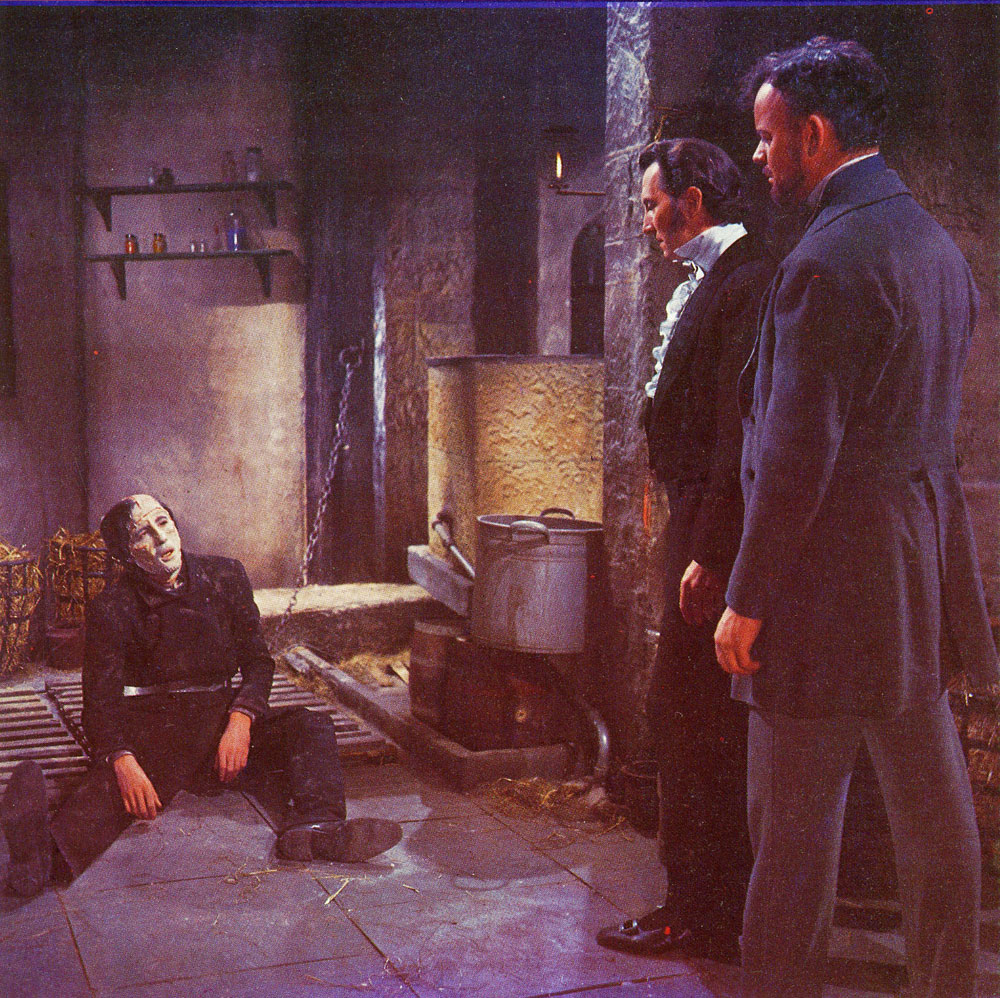

"Paul" threatens to tell the authorities unless "Victor" destroys the creature and the two leave the laboratory in discussion. Meanwhile, the curiosity of "Elizabeth" finally overtakes her and she enters the laboratory looking around.
The creature is able to escape from its chains, captures "Elizabeth", and takes her to the roof. "Victor" and "Paul" rush there.

On the roof "Elizabeth" gets away from the creature as "Victor" fires his gun, but misses.

Next "Victor" tosses an oil lamp at the creature and it catches fire, falling through the skylight into the vat of acid. Cut back to the Priest speaking to "Victor" and it is obvious he does not believe the story. The Priest leaves and the jailer gets "Paul" and "Elizabeth" to visit "Victor". Who is to be guillotined for the murder of "Justine" shortly.

"Victor" pleads with "Elizabeth" and "Paul" to tell the jailer that it was the creature that murdered "Justine. "Paul" reacts by telling "Victor" that he created the creature and is therefore responsible for the murder. The two leave and the film ends with "Victory Frankenstein" being escorted to the guillotine.

The following year Hammer Films released its second "Frankenstein" motion picture. The film opened without age restrictions on June 1, 1958 in the United States and then opened with an "X Cert" in the United Kingdom on August 27, 1958.

Terence Fisher was back in the director's chair and the screenplay was again by Jimmy Sangster. The screenplay was a direct sequel to "The Curse of Frankenstein" and "The Revenge of Frankenstein" opens with "Victor Frankenstein" being led to the guillotine. What the audience discovers later is that he wasn't executed, but with the help of "Karl the Dwarf", the hunchback assistant and a little payoff, it was the Priest who was beheaded in "Victor's" clothing.
Peter Cushing is back as the very popular "Dr. Stein".

Eunice Grayson portrayed "Margaret". Although her name may not be that familiar even in the U.K. Eunice Grayson portrayed "Sylvia Trench", whose character's name is never mentioned, as the real initial Bond Girl, in a red dress, at the baccarat table. "Sylvia" ends up in Sean Connery's bed in 1962's "Dr. No" and reappears for a picnic and boat outing in 1963's "From Russia with Love".
Francis Matthews portrays "Doctor Hans Kleve". Matthews was primarily a BBC and ITV actor and this film is one of his very few.

Above Francis Matthews and Eunice Grayson.
There are two "Karl's" in this picture. The first is the aforementioned dwarf portrayed by Oscar Quitak. Who like Matthews was primarily a BBC and ITV actor.
The second was portrayed by Michael Gwynn. Among Gwynn's films are the original 1960 "Village of the Damned" and Ray Harryhausen's 1963 "Jason and the Argonauts", as the Greek God "Hermes", and the same years "Cleopatra" starring Elizabeth Taylor, Richard Burton and Rex Harrison.
The events in this film occur three years after "Dr. Victor Frankenstein" has been executed. Kind "Dr. Stein" not only cares for the upper classes in 1860 "Carlsbruck", but runs a charity hospital for the poor.

That hospital is a front for a means of "Stein" getting spare parts for his experiments with unnecessary operations on the poor. A local doctor, "Dr. Kleve", recognizes "Victor" and blackmails him into letting him be his assistant.

"Dr. Stein" promised the dwarf "Karl" a new body and has created more than one perfectly looking human bodies. The plan is to transfer "Karl's" brain into one of those bodies.

The plan works and the new "Karl" is born.

However, the unexpected occurs and the old "Karl's" brain takes over its new body. It starts to transform the new body into the old one.

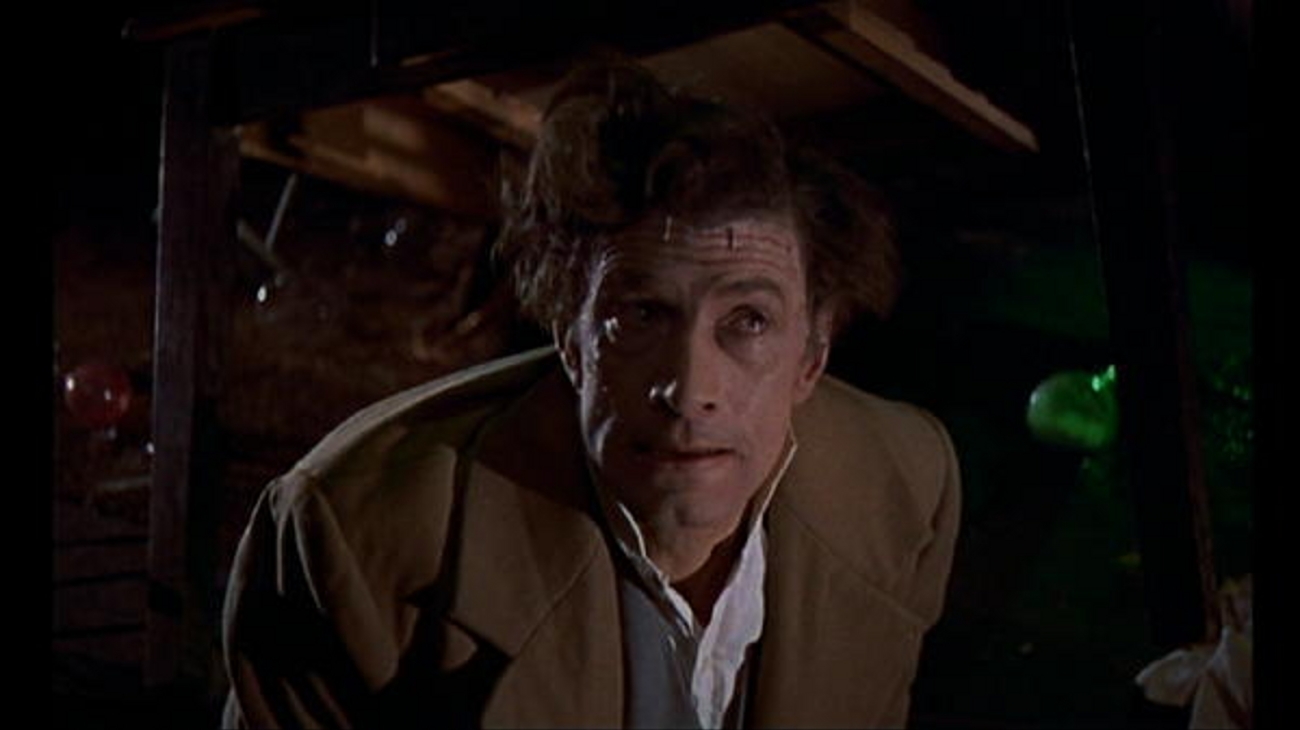

At a party "Karl" breaks in and goes up to "Dr. Stein" and asks "Frankenstein" for help.

"Dr. Stein" goes in front of the medical council and denies being "Baron Victor Frankenstein". The Baron's grave is opened revealing the beheaded Priest. "Hans" suggests that "Stein" leave, but he refuses.
"Stein" goes back to his charity hospital to care as if nothing happened.
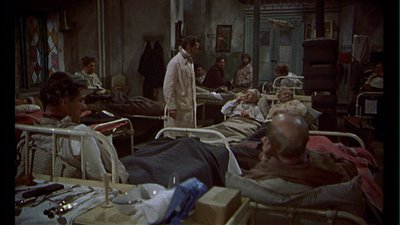
However, the patients having been talking among themselves about "Dr. Stein" being "Frankenstein" and the operations he's always doing on them.
.jpg)
They attack him and almost kill the doctor, but at his direction "Dr. Kleve" transplants "Dr. Stein's" brain into another of the bodies. The film ends with the audience meeting the kindly, London, England, "Dr. Franck".

Hammer films flipped Universal's "Frankenstein". Instead of the monster being immortal as in the American franchise. It is now the doctor whose immortal for the British franchise.
Universal Pictures made 8 feature films and Hammer Studios made 7 features. However, Hammer's 1971 "Horror of Frankenstein", the sixth, had Ralph Bates and not Peter Cushing as "Dr. Frankenstein".
My article "Universal's 'Frankenstein' vs 'Hammer's 'Frankenstein". In which I go into detail about each of these motion pictures can be studied at:
http://www.bewaretheblog.com/2015/02/universals-frankenstein-vs-hammers.html
In the United States during the 1950's the new medium of television was eating into the motion picture industry. Small Independent Studios appeared aiming their film at teenagers and pre-teens for the weekend movie theaters and Drive-in movie crowd, because parents were more then willingly to get the kids out of the house for awhile.
A group of teenage Horror and Science Fiction movies came out of American International Pictures. Released on November 23, 1957 was:

Before I go into this film's details. I mentioned how the two Hammer ""Frankenstein" films were treated by British Censors compared to the same pictures in American release. The reverse happened for the American feature "I Was A Teenage Frankenstein". Above is the main advertisement in the United States without any restrictions, I was 11 at the time, and below is a "Cert X", lobby card, for the United Kingdom of exactly the same motion picture frame by frame.
The picture was directed by Herbert L. Stock. Who, when not directing television series, had directed Ivan Tors 1954 3-D Science Fiction "GOG". Along with another Teen Horror film, 1957's "Blood of Dracula", that had a working script title of "I Was A Teenage Dracula".
The screenplay was credited to a Kenneth Langtry which was in reality producer Herman Cohen.
The four leads are very interesting:
Whit Bissell portrayed "Professor Frankenstein". Among Bissell's motion pictures are the 1951 Science Fiction "The Lost Continent". Two 1954 Science Fiction films, the 3-D "The Creature from the Black Lagoon" and "Target Earth" both with Richard Denning. Then the same years Mickey Rooney comedy "The Atomic Kid". Bissell was non on-screen credited for a role in 1956's "Invasion of the Body Snatchers" and turned Michael Landon in the title character of 1957's "I Was A Teenage Werewolf". Which is often compared too, believe it or not, the James Dean, Natalie Wood and Sal Mineo 1955 "Rebel Without A Cause".
Phylliss Coates was "Maragret" the doctor's secretary. Coates was "Lois Lane" for the pilot and the first season of television's "The Adventures of Superman". She would be replaced for the remainder of the show with the original serial "Lois Lane" Noel Neill. Both "Lois's" were in the 1952 Cold War thriller "Invasion U.S.A.".

Above Whit Bissell and Phylliss Coates.
Robert Burton portrayed "Dr. Karlton". Burton was primarily a television actor, but had small roles in films such as 1952's "Above and Beyond" starring Robert Taylor and Eleanor Parker, 1953's 3-D "Inferno" starring Robert Ryan and Rhonda Fleming, the Rock Hudson 1954 3-D "Tarza, Son of Cochise" and the Glenn Ford, Donna Reed and Leslie Nielson 1956 "Ransom".

Above Bissell and Robert Burton working on the future "Teenage Frankenstein".
Gary Conway portrayed both "Bob" and the title character. He would recreate this role as the actor playing the role in a movie in 1958's "How To Make A Monster". An American International Picture infamously known for burning up many of creature maker Paul Blaisdell's work. So that AIP could make room in storage. Gary Conway co-starred with Gene Barry on television's "Burke's Law" and was a regular on Irwin Allen's "Land of the Giants".

The story is simple and starts in London, England, with "Professor Frankenstein" as a guest lecturer. After the lecture concludes he talks "Dr. Karlton" in accompanying him back the United States to assemble a body and bring it back to life.
There's a car crash and a teenage boy's body is partly mutilated, but "Professor Frankenstein" gets the body and uses it to create his own monster like great grand dad did. The doctor has spare parts of different bodies in drawers within his basement laboratory. While this is going on he makes a play for "Margret" and gets her to be his secretary. Thus keeping unwanted people away from the basement.
The body, complete with smashed face, is brought back to life and the doctor starts it on an exercise program. While promising his creation a new handsome face.




One night the monster gets out of the laboratory and is walking the streets. He spots a young girl and she starts to scream. So of course he ends up killing her.
The police get a lead and go visit "Professor Frankenstein" and then leave. "Margaret" is now suspicious of him.
"Professor Frankenstein" has his creation kill "Margaret" and feeds her down a shaft, in his laboratory, that has his pet garbage disposal an alligator at the bottom in water.
Next "Professor Frankenstein" takes his creation to lover's lane to pick out a new head. They spot a boy and he kills him. The head is taken back to the lab and attached to the teenage body.


"Professor Frankenstein" tells "Karlton" he plans to cut up the teenager and take him back to London and reassemble the body there. When they start to strap the boy down he realizes what going to happen and grabs the "Professor". "Dr. Karlton" runs for the police.
The teen kills the Professor and tosses his body to the alligator. The police arrive and the boy doesn't want them to touch him. Up until this point the motion picture is in black and white. However, the boy backs into the electrical panel and the movie turns into color as he is electrocuted.
.jpg)
The movie ends with "Dr. Karlton" telling the police he will never forget that face and the audience sees it in color.

For those of my readers interested in these late 2950's Teenage Science Fiction and Horror movies with some surprising actors. My article:
"I Was A Teenage Werewolf: 1950's Teenage Horror Movies" may be read at:
http://www.bewaretheblog.com/2016/06/i-was-teenage-werewolf-i-was-teenage.html
Boris Karloff finally got to play "Dr. Frankenstein", but I'm sure some of my readers would say he already did in 1944's "House of Frankenstein", but that was as "Doctor Niemann".
The 1950's Science Fiction and Horror films had the habit of throwing future years in the titles. For example there was "1,000 Years from Now", released in 1952, or "The Terror from the Year 5000", released in 1958. Which was the year, in the month of July, that the motion picture:

This forgotten and overlooked motion picture is a solid "B" Horror film.
"Frankenstein 1970" was directed by Howard W. Koch. Koch primarily directed television programs such as "The Untouchables" and "Hawaiian Eye". After this movie Koch would switch to being a full time producer. He became executive producer for both Frank Sinatra's 1962 "Sergeants 3" and "The Manchurian Candidate", Sinatra's 1963 "Come Blow Your Horn" and "4 for Texas", Sinatra's 1964 "Robin and the 7 Hoods" and Frank Sinatra's 1965 "None But the Brave". Additionally, Howard Koch would produce "The 44th", "45th", "47th", "48th", "50th", "52nd", "54th" and "55th Academy Awards". Among his other films such are both 1980's "Airplane" and 1982's "Airplane II: the Sequel".
The screenplay was co-written by television writer Richard H. Landau. Landau had been a "B" movie writer since 1942, but switched to television in 1955. His films included 1951's "The Lost Continent", the British Science Fiction film from 1953 "Space Ways" and he wrote the screenplay for 1955's "The Quatermass X-periment" with director Val Guest. Among Landau's television work are "Wanted Dead, or Alive", "The Rat Patrol" and "The Wild, Wild West", but he also created the story for Walt Disney's "The Black Hole".
The other screenplay writer was George Worthing Yates. Yates wrote the 1954 Science Fiction classic "THEM!", adapted Chesley Bonestall and Willy Ley's non-fiction work "The Conquest of Space" for the 1955 George Pal feature film. That same year he wrote the screenplay for Ray Harryhausen's "It Came from Beneath the Sea" and in 1956 wrote Harryhausen's "Earth vs the Flying Saucers". In 1957 George Worthing Yates wrote "The Amazing Colossal Man" and besides the 1958 screenplay for this feature film. He wrote 1958's sequel to the "Amazing Colossal Man", "The War of the Colossal Beast" "Attack of the Puppet People", "The Earth vs the Spider" and finished 1958 out with the screenplay for the excellent, but also forgotten "Space Master X-7"
The Four Main Characters:
Boris Karloff was "Baron Victor von Frankenstein". Karloff had just be seen in the British thriller 1958's "The Haunted Strangler". he followed this picture with "Corridors of Blood" co-starring with Christopher Lee. The film was released in the United Kingdom in 1958, but then pulled and not re-released in the UK until 1962 and the United States until 1963.

Tom Dugan portrayed "Mike Shaw". Dugan was a television actor that Koch used in two other pictures he directed in 1958. The two films were "Born Reckless" starring Mamie van Doren, a Marilyn Monroe wanna be, and "Andy Hardy Comes Homes". Which starred Mickey Rooney as the grown up version of his character from a series of 1930's movies he made with Judy Garland.
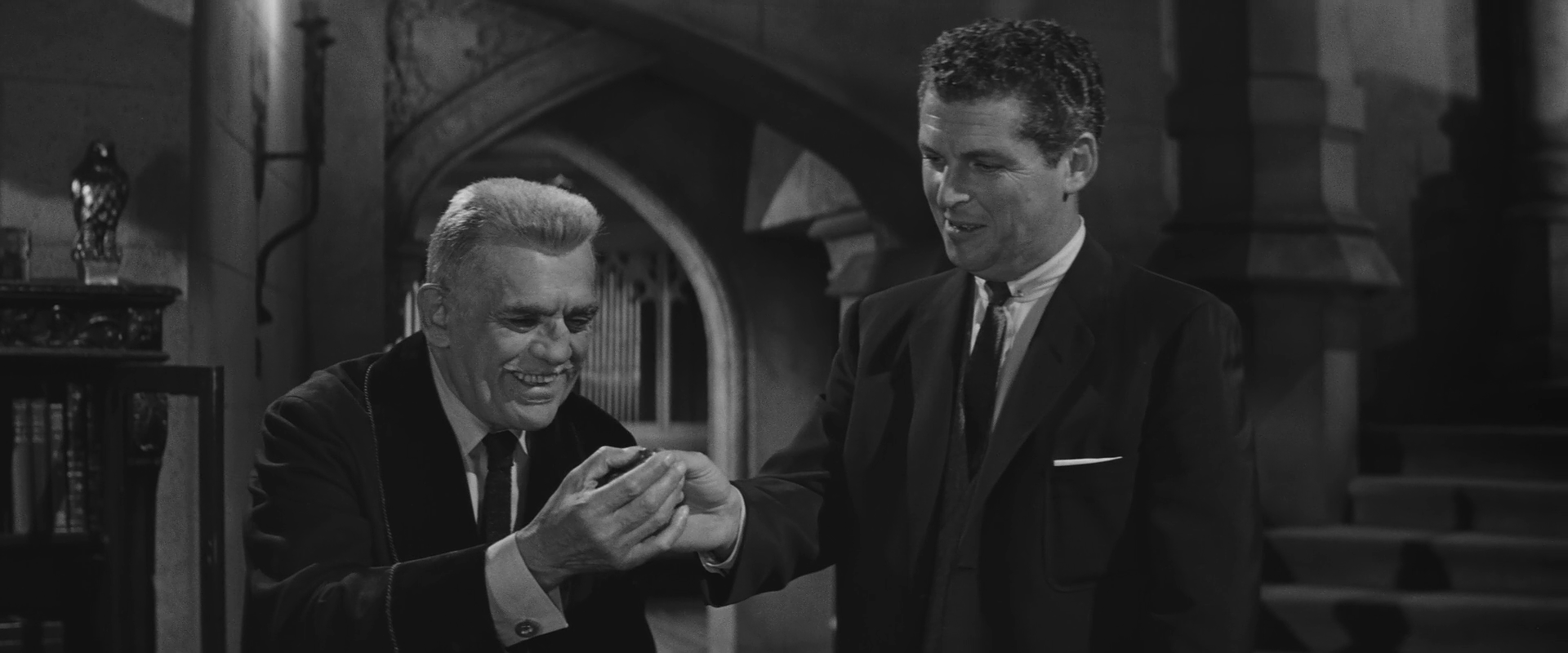
Above Boris Karloff and Tom Dugan
Jana Lund portrayed "Carolyn Hayes". Lund only has 17 roles to her credit and these were mostly on television. Her one "A" list motion picture had the actress with eighth billing in the Elvis Presley and Lizabeth Scott 1957 movie "Loving You".

Above something has got a hold of Jana Lund.
Don "Red" Barry portrayed "Douglas Row". Barry's nickname of "Red" came from appearing in the 1940 "B" Western "The Adventures of Red Rider". In 1939 he had third billing behind Roy Rodgers and Gabby Hayes in "Saga of Death Valley" and became a major 1940's and early 1950's
"B" Western Cowboy star portraying both "Billy the Kid" and "Jesse James".

Don "Red' Barry is second from the left in the above still talking to actor Irwin Berke as "Inspector Raab". Between Boris Karlof and Tom Dugan is actor Rudolph Anders as "Wilhelm Gottfried".
Mike Lane portrayed the dual role of "Hans Himmler" and the monster. Lane's first motion was the Humphrey Bogart, Rod Steiger and Jan Sterling 1956 "The Harder They Fall" with fourth billing behind Sterling. He mainly appeared as a heavy on television shows, but in 1962 starred in the Italian film "Ulysses Against Hercules" as "Hercules". In 1967 Mike Lane was a villain, "Daddy Long Legs", on the Adam West and Burt Ward television series "Batman". Lane also played "Frank N. Stein" on televisions 1976 one season "Monster Squad".
The movie opens with an obvious tribute to the Universal Pictures series. As the audience sees a young women being pursued by the "Frankenstein Monster" in a swampy area of woods.

The she falls and the monster is right in front of the terrified girl.

When the audience hears "CUT!" and discovers what they had just seen is part of a made a television feature. Being filmed at the actual "Castle Frankenstein" as a documentary of the family. The current "Baron Frankenstein" is letting the crew work on site and is providing living quarters from them.

At one point in the picture Boris Karloff is walking by a wall within the family burial vault narrating the Frankenstein history for the documentary. George Worthing Yates wrote a great monologue to say, but unfortunately Karloff's story is not completed in the scene.
What the audience finds out is that this "Baron Victor von Frankenstein" was captured and tortured by the Nazi's during the Second World War to obtain the families secret of creating life. He never revealed it and that torture is the reason his face looks like it is. What is unknown to the film crew is that the "Baron" is carrying out that work in a hidden laboratory. He needed the money the motion picture company would provide to complete his work with the purchase of a "Atomic Reactor". Additionally, the television movie crew is about to provide spare parts.



One mistake happens when the monster kills the director's secretary/script girl for her eyes. She has bad eyesight and uses strong glasses. So her eyes are useless.
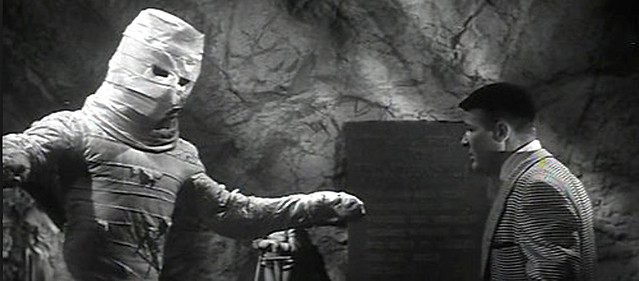
The murders bring the police out, but nothing can be proven. Now the monster re-enacts the opening sequence for real as actress "Carolyn Hayes" is captured and taken to the laboratory.

The monster turns on the "Baron" and the "Atomic Reactor" explodes killing both of them. When the the level of radiation goes down to safe levels. A recording tape is found and "Baron Victor von Frankenstein" tells the listeners he intended the monster to carry on the name "Frankenstein", because the "Baron" was the last living "Frankenstein".
When the bandages are cleared from the monster face. It is a younger face of "Baron Victor von Frankenstein" as Boris Karloff plays both the creator and the creation.

In September 1964 Universal Pictures premiered a new family sitcom on CBS. The head of this typical American suburban family was "Fred Munster". Whose job was coffin tester.

Above left to right are Al Lewis as "Grandpa Munster", Pat Priest as the ugly cousin "Marilyn Munster", Butch Patrick as "Eddie Munster", Yvonne DeCarlo as "Lily Munster" and head of the household Fred Gwynne as "Herman Munster".
My article on "THE ADDAMS FAMILY and THE MUNSTERS" can be found at:
http://www.bewaretheblog.com/2017/09/the-addams-family-and-munsters.html
Stop Motion Animator Willis O'Brien, 1925's "The Lost World" and 1933's "King Kong", wrote a 1961 screenplay entitled "King Kong vs Frankenstein". In this story "Dr. Frankenstein" now lived in the African Jungle and was assembling a giant gorilla instead of a human. The two come in contact with "King Kong" the protector of the jungle apes. O'Brien had several sketches to accompany his screenplay.

The "Frankenstein Gorilla" is on the left and "King Kong" is on the right in the above Willis O'Brien sketch. Between them is a normal human for size comparison.
In Japan Toho Studio's head and executive producer Tomoyuki Tanaka had always wanted to do a "Frankenstein" story. His latest plan was to make a sequel to the successful 1960 "Gasu Ningen Dai 1 Go (Gas Human Being No. 1)" aka: "The Human Vapor". Tanaka's idea was to be calleed "Frankenstein vs the Human Vapor". The idea was to have "Mizuno", the human vapor, finding the "Frankenstein Monster", can you say 1943's "Frankenstein Meets the Wolfman", see my link under the Universal and Hammer Frankenstein films. "Mizuno" wants the "Frankenstein" formula to bring back to life his girlfriend that died at the end of the 1960 motion picture.
Enter American producer John Beck who tricked Willis O'Brien into giving him control of his screenplay. Lawsuits from both O'Brien's and producer Merian C. Cooper's estates would be filed against John Beck and Toho Studios in 1962.
Beck hired George Worthing Yates to rewrite O'Brien's screenplay and it became "King Kong vs Prometheus". Not finding an American company to make the movie. Producer John Beck met with Tomoyuki Tanaka and the screenplay was turned into 1962's "Kingu Kongu tai Gojira (King Kong vs Godzilla)".
Now Tomoyuki Tanaka decided to use the O'Brien/Yates screenplay and taking an idea not used in the previous motion picture. He would make "Furankenshutain tai Gojira (Frankenstein vs Godzilla)". However, money became a problem for such a large project for the studio. Now entered financial American backer and producer Henry G. Saperstein and Tanaka's idea morphed into 1965's "Furankenshutain tai Baragon (Frankenstein vs Baragon)". Which would also be released with some slight alterations into Saperstein's 1966 English language version "Frankenstein Conquerors the World".

The motion picture was directed by Ishiro Honda. Among Honda's work were 1954's "Gojira (Godzilla)", 1955's "Ju Jin Yuki Otoko (Mountain Snowman)", 1956 "Sora No Daikaiju Radon (Flying Monster Radon aka: Rodan)". Among Honda's other films were the aforementioned "The Human Vapor" and "King Kong vs Godzilla".
That original O'Brien/Yates story was reworked by Reuben Bercovitch. An American writer living in Japan. Who wrote the story excellent, under rated, Lee Marvin and Toshiro Mifune 1968 World War Two feature "Hell in the Pacific" and who creating the story for the sequel to this motion picture.
The final screenplay was by Takeshi Kimura. Among his other screenplays were 1957's "Chikyu Boeigun (Earth Defense Force aka: "The Mysterians)", 1958's "Bijo To Ekitai Ningen (Beauty and the Liquid People aka: "The H-Man)" and 1968's "Kaiju Soshingeki (Kaiju Total Attack aka: Destroy All Monsters)".
On-screen credit went to writer Shin'ichi Sekizawa. The writer of the original, but unused Toho screenplay for "Furankenshutain tai Gojira".
The Three Leading Actors
Tadao Takashikma portrayed "Dr. Yuzo Kawaji" aka: "Dr. Ken'ichiro Kawaji". Jazz Musician and Actor Takashikma's first motion picture was a 1952 musical. He appeared as "Professor Henry Higgins" in a Japanese stage production of "My Fair Lady" , but is known for his Toho Science Fiction films such as 1962's "Kingu Kongu tai Gojira", 1963's "Kaitei Gunkan (Undersea Warship aka: Atragon)" and 1967's Kaiju -To No Kessen: Gojira No Musuko (Monster Island Decisive Battle: Son of Godzilla)".
Nick Adams (as Nikku Adamusu) portrayed "Dr. James Bowen". American Adams was known to 1959 through 1961 television fans as "Johnny Yuma" on the series "The Rebel". Earlier, he had appeared in 1955's "Rebel Without A Cause" starring James Dean and Natalie Wood and after Dean was killed in a vehicle accident. Nick Adams doubled for him in some scenes as "Jett Rink" shot from the back and provided a dubbed voice in the big speech scene for the late actor. This picture was his first for Toho films.
Kumi Mizuno portrayed "Dr. Sueko Togami". Mizuno and Adams became very close during the filming of this picture off set. Mizuno had appeared in films since 1957 and some of these were 1963's Horror film "Matango", 1963's adventure film "Dai Tozoku (The Great Bandit aka: The Lost World of Sinbad)" with Tohsiro Mifune and Mie Hama. Again with Nick Adams in 1965's "Kaiju Daisenso (The Giant Monster War aka: Invasion of the Astro-Monster)" portraying "Miss Namikawa". Adams was supposed to co-star with Kumi Mizuno in a third feature film "Furankshutain No Kaiju: Sanda tai Gaira (Frankenstein's Monsters: Sanda vs Gaira)", but Adams left Japan to return to the United States to divorce his wife and come back to start filming and marry, so he thought, Mizuno. Only to find her engaged to another man, Nick Adams broke his contract with Toho, and American Actor Russ Tamblyn replaced him on the picture as "Dr. Paul Stewart". While Kumi Mizuno still played "Dr. Akemi Togami".

Above on the left are Nick Adams, Tadao Takashima and Kumi Mizuno. On the right is Yoshio Tsuchiya portraying ex-Japanese Naval Officer "Mr. Kawai".
The story starts with Nazi's breaking into the laboratory of German Scientist "Dr. Riesendorf", played by Peter Mann, and taking from him the original "Frankenstein Monster's" still beating heart. The Nazi's meet a Japanese submarine that "Mr. Kawai" is on board and transfer the heart to the Japanese Imperial Navy. They take the heart to scientists working in Hiroshima. However, before they can truly conduct their experimentation on it. The date is August 6, 1945 and the Atomic Bomb is dropped from the "Enola Gay".
The film cuts to the present and the audience sees "Mr.Kawai" working in an Oil Refinery as an earthquake takes place. During the quake he sees what appears to be some giant underground monster, "Baragon".
_021.jpg)
The three doctor's hear of a strange boy appearing in a local town and go to investigate. They research, meet with "Mr. Kawai", and conclude the boy had the heart of the "Frankenstein Monster" placed inside of him
Japanese "Frankenstein". Make-up artist Riki Konna had to create a make-up for two actors. The first was Kenichiro Kawaji as the young boy "Frankenstein" and then actor Koji Furuhata as the adult.
The screenplay was credited to a Kenneth Langtry which was in reality producer Herman Cohen.
The four leads are very interesting:
Whit Bissell portrayed "Professor Frankenstein". Among Bissell's motion pictures are the 1951 Science Fiction "The Lost Continent". Two 1954 Science Fiction films, the 3-D "The Creature from the Black Lagoon" and "Target Earth" both with Richard Denning. Then the same years Mickey Rooney comedy "The Atomic Kid". Bissell was non on-screen credited for a role in 1956's "Invasion of the Body Snatchers" and turned Michael Landon in the title character of 1957's "I Was A Teenage Werewolf". Which is often compared too, believe it or not, the James Dean, Natalie Wood and Sal Mineo 1955 "Rebel Without A Cause".
Phylliss Coates was "Maragret" the doctor's secretary. Coates was "Lois Lane" for the pilot and the first season of television's "The Adventures of Superman". She would be replaced for the remainder of the show with the original serial "Lois Lane" Noel Neill. Both "Lois's" were in the 1952 Cold War thriller "Invasion U.S.A.".

Above Whit Bissell and Phylliss Coates.
Robert Burton portrayed "Dr. Karlton". Burton was primarily a television actor, but had small roles in films such as 1952's "Above and Beyond" starring Robert Taylor and Eleanor Parker, 1953's 3-D "Inferno" starring Robert Ryan and Rhonda Fleming, the Rock Hudson 1954 3-D "Tarza, Son of Cochise" and the Glenn Ford, Donna Reed and Leslie Nielson 1956 "Ransom".

Above Bissell and Robert Burton working on the future "Teenage Frankenstein".
Gary Conway portrayed both "Bob" and the title character. He would recreate this role as the actor playing the role in a movie in 1958's "How To Make A Monster". An American International Picture infamously known for burning up many of creature maker Paul Blaisdell's work. So that AIP could make room in storage. Gary Conway co-starred with Gene Barry on television's "Burke's Law" and was a regular on Irwin Allen's "Land of the Giants".

The story is simple and starts in London, England, with "Professor Frankenstein" as a guest lecturer. After the lecture concludes he talks "Dr. Karlton" in accompanying him back the United States to assemble a body and bring it back to life.
There's a car crash and a teenage boy's body is partly mutilated, but "Professor Frankenstein" gets the body and uses it to create his own monster like great grand dad did. The doctor has spare parts of different bodies in drawers within his basement laboratory. While this is going on he makes a play for "Margret" and gets her to be his secretary. Thus keeping unwanted people away from the basement.
The body, complete with smashed face, is brought back to life and the doctor starts it on an exercise program. While promising his creation a new handsome face.




One night the monster gets out of the laboratory and is walking the streets. He spots a young girl and she starts to scream. So of course he ends up killing her.
The police get a lead and go visit "Professor Frankenstein" and then leave. "Margaret" is now suspicious of him.
"Professor Frankenstein" has his creation kill "Margaret" and feeds her down a shaft, in his laboratory, that has his pet garbage disposal an alligator at the bottom in water.
Next "Professor Frankenstein" takes his creation to lover's lane to pick out a new head. They spot a boy and he kills him. The head is taken back to the lab and attached to the teenage body.


"Professor Frankenstein" tells "Karlton" he plans to cut up the teenager and take him back to London and reassemble the body there. When they start to strap the boy down he realizes what going to happen and grabs the "Professor". "Dr. Karlton" runs for the police.
The teen kills the Professor and tosses his body to the alligator. The police arrive and the boy doesn't want them to touch him. Up until this point the motion picture is in black and white. However, the boy backs into the electrical panel and the movie turns into color as he is electrocuted.
.jpg)
The movie ends with "Dr. Karlton" telling the police he will never forget that face and the audience sees it in color.

For those of my readers interested in these late 2950's Teenage Science Fiction and Horror movies with some surprising actors. My article:
"I Was A Teenage Werewolf: 1950's Teenage Horror Movies" may be read at:
http://www.bewaretheblog.com/2016/06/i-was-teenage-werewolf-i-was-teenage.html
Boris Karloff finally got to play "Dr. Frankenstein", but I'm sure some of my readers would say he already did in 1944's "House of Frankenstein", but that was as "Doctor Niemann".
The 1950's Science Fiction and Horror films had the habit of throwing future years in the titles. For example there was "1,000 Years from Now", released in 1952, or "The Terror from the Year 5000", released in 1958. Which was the year, in the month of July, that the motion picture:

This forgotten and overlooked motion picture is a solid "B" Horror film.
"Frankenstein 1970" was directed by Howard W. Koch. Koch primarily directed television programs such as "The Untouchables" and "Hawaiian Eye". After this movie Koch would switch to being a full time producer. He became executive producer for both Frank Sinatra's 1962 "Sergeants 3" and "The Manchurian Candidate", Sinatra's 1963 "Come Blow Your Horn" and "4 for Texas", Sinatra's 1964 "Robin and the 7 Hoods" and Frank Sinatra's 1965 "None But the Brave". Additionally, Howard Koch would produce "The 44th", "45th", "47th", "48th", "50th", "52nd", "54th" and "55th Academy Awards". Among his other films such are both 1980's "Airplane" and 1982's "Airplane II: the Sequel".
The screenplay was co-written by television writer Richard H. Landau. Landau had been a "B" movie writer since 1942, but switched to television in 1955. His films included 1951's "The Lost Continent", the British Science Fiction film from 1953 "Space Ways" and he wrote the screenplay for 1955's "The Quatermass X-periment" with director Val Guest. Among Landau's television work are "Wanted Dead, or Alive", "The Rat Patrol" and "The Wild, Wild West", but he also created the story for Walt Disney's "The Black Hole".
The other screenplay writer was George Worthing Yates. Yates wrote the 1954 Science Fiction classic "THEM!", adapted Chesley Bonestall and Willy Ley's non-fiction work "The Conquest of Space" for the 1955 George Pal feature film. That same year he wrote the screenplay for Ray Harryhausen's "It Came from Beneath the Sea" and in 1956 wrote Harryhausen's "Earth vs the Flying Saucers". In 1957 George Worthing Yates wrote "The Amazing Colossal Man" and besides the 1958 screenplay for this feature film. He wrote 1958's sequel to the "Amazing Colossal Man", "The War of the Colossal Beast" "Attack of the Puppet People", "The Earth vs the Spider" and finished 1958 out with the screenplay for the excellent, but also forgotten "Space Master X-7"
The Four Main Characters:
Boris Karloff was "Baron Victor von Frankenstein". Karloff had just be seen in the British thriller 1958's "The Haunted Strangler". he followed this picture with "Corridors of Blood" co-starring with Christopher Lee. The film was released in the United Kingdom in 1958, but then pulled and not re-released in the UK until 1962 and the United States until 1963.

Tom Dugan portrayed "Mike Shaw". Dugan was a television actor that Koch used in two other pictures he directed in 1958. The two films were "Born Reckless" starring Mamie van Doren, a Marilyn Monroe wanna be, and "Andy Hardy Comes Homes". Which starred Mickey Rooney as the grown up version of his character from a series of 1930's movies he made with Judy Garland.

Above Boris Karloff and Tom Dugan
Jana Lund portrayed "Carolyn Hayes". Lund only has 17 roles to her credit and these were mostly on television. Her one "A" list motion picture had the actress with eighth billing in the Elvis Presley and Lizabeth Scott 1957 movie "Loving You".

Above something has got a hold of Jana Lund.
Don "Red" Barry portrayed "Douglas Row". Barry's nickname of "Red" came from appearing in the 1940 "B" Western "The Adventures of Red Rider". In 1939 he had third billing behind Roy Rodgers and Gabby Hayes in "Saga of Death Valley" and became a major 1940's and early 1950's
"B" Western Cowboy star portraying both "Billy the Kid" and "Jesse James".

Don "Red' Barry is second from the left in the above still talking to actor Irwin Berke as "Inspector Raab". Between Boris Karlof and Tom Dugan is actor Rudolph Anders as "Wilhelm Gottfried".
Mike Lane portrayed the dual role of "Hans Himmler" and the monster. Lane's first motion was the Humphrey Bogart, Rod Steiger and Jan Sterling 1956 "The Harder They Fall" with fourth billing behind Sterling. He mainly appeared as a heavy on television shows, but in 1962 starred in the Italian film "Ulysses Against Hercules" as "Hercules". In 1967 Mike Lane was a villain, "Daddy Long Legs", on the Adam West and Burt Ward television series "Batman". Lane also played "Frank N. Stein" on televisions 1976 one season "Monster Squad".
The movie opens with an obvious tribute to the Universal Pictures series. As the audience sees a young women being pursued by the "Frankenstein Monster" in a swampy area of woods.

The she falls and the monster is right in front of the terrified girl.

When the audience hears "CUT!" and discovers what they had just seen is part of a made a television feature. Being filmed at the actual "Castle Frankenstein" as a documentary of the family. The current "Baron Frankenstein" is letting the crew work on site and is providing living quarters from them.

At one point in the picture Boris Karloff is walking by a wall within the family burial vault narrating the Frankenstein history for the documentary. George Worthing Yates wrote a great monologue to say, but unfortunately Karloff's story is not completed in the scene.
What the audience finds out is that this "Baron Victor von Frankenstein" was captured and tortured by the Nazi's during the Second World War to obtain the families secret of creating life. He never revealed it and that torture is the reason his face looks like it is. What is unknown to the film crew is that the "Baron" is carrying out that work in a hidden laboratory. He needed the money the motion picture company would provide to complete his work with the purchase of a "Atomic Reactor". Additionally, the television movie crew is about to provide spare parts.



One mistake happens when the monster kills the director's secretary/script girl for her eyes. She has bad eyesight and uses strong glasses. So her eyes are useless.

The murders bring the police out, but nothing can be proven. Now the monster re-enacts the opening sequence for real as actress "Carolyn Hayes" is captured and taken to the laboratory.

The monster turns on the "Baron" and the "Atomic Reactor" explodes killing both of them. When the the level of radiation goes down to safe levels. A recording tape is found and "Baron Victor von Frankenstein" tells the listeners he intended the monster to carry on the name "Frankenstein", because the "Baron" was the last living "Frankenstein".
When the bandages are cleared from the monster face. It is a younger face of "Baron Victor von Frankenstein" as Boris Karloff plays both the creator and the creation.

In September 1964 Universal Pictures premiered a new family sitcom on CBS. The head of this typical American suburban family was "Fred Munster". Whose job was coffin tester.

Above left to right are Al Lewis as "Grandpa Munster", Pat Priest as the ugly cousin "Marilyn Munster", Butch Patrick as "Eddie Munster", Yvonne DeCarlo as "Lily Munster" and head of the household Fred Gwynne as "Herman Munster".
My article on "THE ADDAMS FAMILY and THE MUNSTERS" can be found at:
http://www.bewaretheblog.com/2017/09/the-addams-family-and-munsters.html
Stop Motion Animator Willis O'Brien, 1925's "The Lost World" and 1933's "King Kong", wrote a 1961 screenplay entitled "King Kong vs Frankenstein". In this story "Dr. Frankenstein" now lived in the African Jungle and was assembling a giant gorilla instead of a human. The two come in contact with "King Kong" the protector of the jungle apes. O'Brien had several sketches to accompany his screenplay.

The "Frankenstein Gorilla" is on the left and "King Kong" is on the right in the above Willis O'Brien sketch. Between them is a normal human for size comparison.
In Japan Toho Studio's head and executive producer Tomoyuki Tanaka had always wanted to do a "Frankenstein" story. His latest plan was to make a sequel to the successful 1960 "Gasu Ningen Dai 1 Go (Gas Human Being No. 1)" aka: "The Human Vapor". Tanaka's idea was to be calleed "Frankenstein vs the Human Vapor". The idea was to have "Mizuno", the human vapor, finding the "Frankenstein Monster", can you say 1943's "Frankenstein Meets the Wolfman", see my link under the Universal and Hammer Frankenstein films. "Mizuno" wants the "Frankenstein" formula to bring back to life his girlfriend that died at the end of the 1960 motion picture.
Enter American producer John Beck who tricked Willis O'Brien into giving him control of his screenplay. Lawsuits from both O'Brien's and producer Merian C. Cooper's estates would be filed against John Beck and Toho Studios in 1962.
Beck hired George Worthing Yates to rewrite O'Brien's screenplay and it became "King Kong vs Prometheus". Not finding an American company to make the movie. Producer John Beck met with Tomoyuki Tanaka and the screenplay was turned into 1962's "Kingu Kongu tai Gojira (King Kong vs Godzilla)".
Now Tomoyuki Tanaka decided to use the O'Brien/Yates screenplay and taking an idea not used in the previous motion picture. He would make "Furankenshutain tai Gojira (Frankenstein vs Godzilla)". However, money became a problem for such a large project for the studio. Now entered financial American backer and producer Henry G. Saperstein and Tanaka's idea morphed into 1965's "Furankenshutain tai Baragon (Frankenstein vs Baragon)". Which would also be released with some slight alterations into Saperstein's 1966 English language version "Frankenstein Conquerors the World".

The motion picture was directed by Ishiro Honda. Among Honda's work were 1954's "Gojira (Godzilla)", 1955's "Ju Jin Yuki Otoko (Mountain Snowman)", 1956 "Sora No Daikaiju Radon (Flying Monster Radon aka: Rodan)". Among Honda's other films were the aforementioned "The Human Vapor" and "King Kong vs Godzilla".
That original O'Brien/Yates story was reworked by Reuben Bercovitch. An American writer living in Japan. Who wrote the story excellent, under rated, Lee Marvin and Toshiro Mifune 1968 World War Two feature "Hell in the Pacific" and who creating the story for the sequel to this motion picture.
The final screenplay was by Takeshi Kimura. Among his other screenplays were 1957's "Chikyu Boeigun (Earth Defense Force aka: "The Mysterians)", 1958's "Bijo To Ekitai Ningen (Beauty and the Liquid People aka: "The H-Man)" and 1968's "Kaiju Soshingeki (Kaiju Total Attack aka: Destroy All Monsters)".
On-screen credit went to writer Shin'ichi Sekizawa. The writer of the original, but unused Toho screenplay for "Furankenshutain tai Gojira".
The Three Leading Actors
Tadao Takashikma portrayed "Dr. Yuzo Kawaji" aka: "Dr. Ken'ichiro Kawaji". Jazz Musician and Actor Takashikma's first motion picture was a 1952 musical. He appeared as "Professor Henry Higgins" in a Japanese stage production of "My Fair Lady" , but is known for his Toho Science Fiction films such as 1962's "Kingu Kongu tai Gojira", 1963's "Kaitei Gunkan (Undersea Warship aka: Atragon)" and 1967's Kaiju -To No Kessen: Gojira No Musuko (Monster Island Decisive Battle: Son of Godzilla)".
Nick Adams (as Nikku Adamusu) portrayed "Dr. James Bowen". American Adams was known to 1959 through 1961 television fans as "Johnny Yuma" on the series "The Rebel". Earlier, he had appeared in 1955's "Rebel Without A Cause" starring James Dean and Natalie Wood and after Dean was killed in a vehicle accident. Nick Adams doubled for him in some scenes as "Jett Rink" shot from the back and provided a dubbed voice in the big speech scene for the late actor. This picture was his first for Toho films.
Kumi Mizuno portrayed "Dr. Sueko Togami". Mizuno and Adams became very close during the filming of this picture off set. Mizuno had appeared in films since 1957 and some of these were 1963's Horror film "Matango", 1963's adventure film "Dai Tozoku (The Great Bandit aka: The Lost World of Sinbad)" with Tohsiro Mifune and Mie Hama. Again with Nick Adams in 1965's "Kaiju Daisenso (The Giant Monster War aka: Invasion of the Astro-Monster)" portraying "Miss Namikawa". Adams was supposed to co-star with Kumi Mizuno in a third feature film "Furankshutain No Kaiju: Sanda tai Gaira (Frankenstein's Monsters: Sanda vs Gaira)", but Adams left Japan to return to the United States to divorce his wife and come back to start filming and marry, so he thought, Mizuno. Only to find her engaged to another man, Nick Adams broke his contract with Toho, and American Actor Russ Tamblyn replaced him on the picture as "Dr. Paul Stewart". While Kumi Mizuno still played "Dr. Akemi Togami".

Above on the left are Nick Adams, Tadao Takashima and Kumi Mizuno. On the right is Yoshio Tsuchiya portraying ex-Japanese Naval Officer "Mr. Kawai".
The story starts with Nazi's breaking into the laboratory of German Scientist "Dr. Riesendorf", played by Peter Mann, and taking from him the original "Frankenstein Monster's" still beating heart. The Nazi's meet a Japanese submarine that "Mr. Kawai" is on board and transfer the heart to the Japanese Imperial Navy. They take the heart to scientists working in Hiroshima. However, before they can truly conduct their experimentation on it. The date is August 6, 1945 and the Atomic Bomb is dropped from the "Enola Gay".
The film cuts to the present and the audience sees "Mr.Kawai" working in an Oil Refinery as an earthquake takes place. During the quake he sees what appears to be some giant underground monster, "Baragon".
_021.jpg)
The three doctor's hear of a strange boy appearing in a local town and go to investigate. They research, meet with "Mr. Kawai", and conclude the boy had the heart of the "Frankenstein Monster" placed inside of him
Japanese "Frankenstein". Make-up artist Riki Konna had to create a make-up for two actors. The first was Kenichiro Kawaji as the young boy "Frankenstein" and then actor Koji Furuhata as the adult.
As the story progress "Baragon" starts attacking villages and small towns and "Frankenstein" escapes captivity.

"Frankenstein" and "Baragon" meet and fight each other, but the "Subterranean Monster", as he is called in some titles, escapes.

The two will meet in a final battle as a forest fire is started and then the earth splits open and after killing "Baragon". "Frankenstein" sinks into the earth to be buried, but it is believed the heart will keep him alive.



There is one major difference between the Japanese and English language version from Henry G. Saperstein.

At the hospital that the three doctors run is a young women dying slowly from radiation poisoning, because she was a baby when the Atomic Bomb was dropped on Hiroshima. "Dr. Bowen" and "Dr. Togami" try to lift her spirits up.
In one sequence the two Doctors visit the Hiroshima memorial. The girl will die, but all references to the Atomic Bomb and the Hiroshima Memorial visit and most of the girl's story line are dropped by Saperstein. American's still didn't want to be reminded of what happened to the populations of Hiroshima and Nagasaki to end World War Two.
Also, Saperstein requested a different ending for the English language version. In it the "Frankenstein" monster battles a giant Octopus. The ending was shot, but never released in the United States and most countries. Although the picture with that ending did get release in Europe through Toho International.

On April 6, 1966, a "B"
Western Horror double bill was released that had been shot in a total of eight days at the Corriganville Movie Ranch in Simi Valley, California. "Billy
the Kid vs Dracula" isn't of interest here, but the other film
is:


Both films were directed by William
Beaudine. Beaudine started directing in 1915 and would co-direct his last and
372nd motion picture in 1976. Both so called Horror "B" Westerns were written by Carl K. Hittleman. Hittleman's total film writing career involved 18 movies between 1947 and 1989. Most of which only
required the writer to come up for the idea for the story.
There are some interesting
"B" actors involved in "Jesse James Meets Frankensteins
Daughter".
John Lupton portrayed "Jesse James". His work included the 1953 film version of Shakespeare's "Julius Caesar" starring Marlon Brando and James Mason and director Raul Walsh's 1955 version of Leon Uris' World War Two drama "Battle Cry". He was featured in Walt Disney's 1956 "The Great Locomotive Chase". That was based upon the real life experiences of "Union Corporal William Piitenger", Lupton, who wrote the non-fiction account of "Andrews Raiders". The first men to receive the "Congressional Medal of Honor". John Lupton starred on the television series "Broken Arrow" in the role of real life Indian Agent "Tom Jeffords" played by James Stewart in the feature film.
John Lupton is wearing black as
"Jesse James" in the above photo.
Narda Onyx portrayed "Dr.
Maria Frankenstein". This was Russian born and Soviet Union
escapes Onyx's last on-screen appearance. She mainly had small roles on
television in parts requiring a woman with an accent starting in 1956.
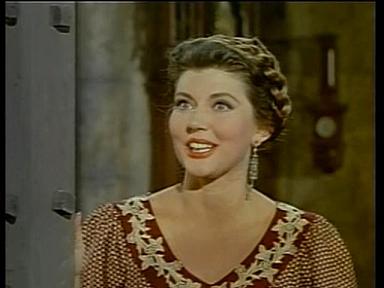

Carl Bolder portrayed "Hank
Tracy" and "Igor". Bolder's 18
on-screen appearances. except for this one, were on television programs.
Jim Davis portrayed "Marshall MacPhee". Davis had been acting since 1942 in War films and "B" Westerns. On television he starred in several early shows such as 1952's "Dangerous Assignment" the same years "Cowboy G-Men", 1954's Western "Tales of the Century" and became a regular in many other Western shows and movies.

Nester Paiva portrayed the "Saloon
Owner". Paiva was "Lucas" in
1953's "The Creature from the Black Lagoon", the
sheriff in 1955's "Tarantula" and a
scientist in 1956's "The Mole People".


Above Nester Paiva and John
Lupton.
My article "NESTER
PAIVA: The Skipper of the 'Rita' vs the Creature from the Black
Lagoon" is available to be read at:
On the run from "Marshall
MacPhee", "Jesse James" and his friend "Hank Tracy" go
into hiding at the Western Castle of "Frankenstein's Daughter".
.jpg)
However, she sends "Jesse" into the local Mexican village for medicines. While he's in town "Dr. Maria Frankenstein" turns wounded "Hank" into "Igor" a mindless slave.


.jpg)
However, she sends "Jesse" into the local Mexican village for medicines. While he's in town "Dr. Maria Frankenstein" turns wounded "Hank" into "Igor" a mindless slave.


Meanwhile, a young girl named
"Juanita Lopez", played by Estelita Rodriquez. is falling for "Jesse".
"Juanita" goes to "Marshall
MacPhee" for help and when he arrives "Igor" is ordered to kill
him.
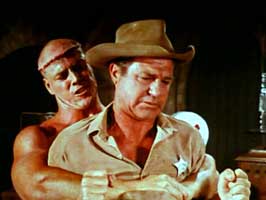
Next, "Igor" is ordered to
kill "Jesse", but instead will kill "Frankenstein's
Daughter".
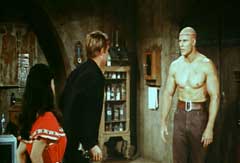
"Juanita" is able to get
"Jesse's" gun and kills "Igor".
In 1967 there was a stop motion
animated feature film "Mad Monster Party" from
Arthur Rankin, Jr. and Jules Bass. The feature included both
the "Frankenstein Monster" and a take off on Boris Karloff voiced by
Karloff. It also featured the voice of comedian Phyllis Diller.


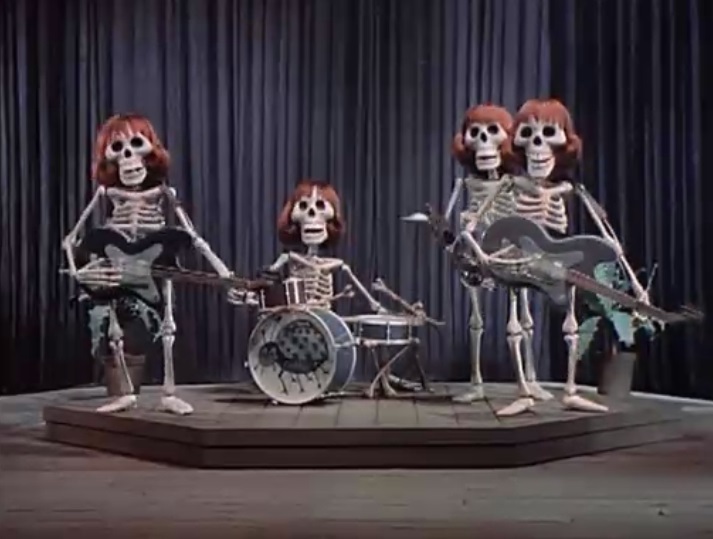

During the 1970's young Black
filmmakers were attempting to make motion pictures aimed at the
African-American audience. Although films like 1971's "Shaft", starring
Richard Roundtree, or 1973's "Coffy", starring Pam
Grier, crossed racial lines.
These film makers started remaking classic Horror films in a "Black Image". Probably the most successful were 1972's "Blacula" and 1973's "Scream Blacula Scream". Both starred Shakespearean actor William Marshall in the title role.
These film makers started remaking classic Horror films in a "Black Image". Probably the most successful were 1972's "Blacula" and 1973's "Scream Blacula Scream". Both starred Shakespearean actor William Marshall in the title role.
One of these "Blaxploitation" Horror
films was "Blackenstein" aka: "Black
Frankenstein" released on August 3, 1973.


The film made by Frank R. Saletri the screenplay writer and producer. "Blackensten" was directed by
William A. Levy. Who went on to direct such classics (?) as 1975's "Wham
Bam Thank You Spaceman" and 1977's "The Happy Hooker
Goes to Washington".
John Hart portrayed "Dr.
Stein". Hart is best remembered for replacing Clayton Moore for
54 episodes of the television Western "The Long Ranger". This
was when Moore and the producers were having their first fight over money.
Otherwise Hart appeared on several different television series between 1952 and
1982.


Ivory Stone portrayed "Dr.
Winifred Walker". Like Frank R. Saletri, this was her only
motion picture.


Joe De Sue portrayed "Eddie Turner--Blackenstein". As with most of the cast this was his one and only role.
The screenplay for "Blackenstein" has "Eddie", a Vietnam Veteran, this was one year before President Richard Nixon pulled the United States out, having stepped on a land mine and lost his arms and legs.
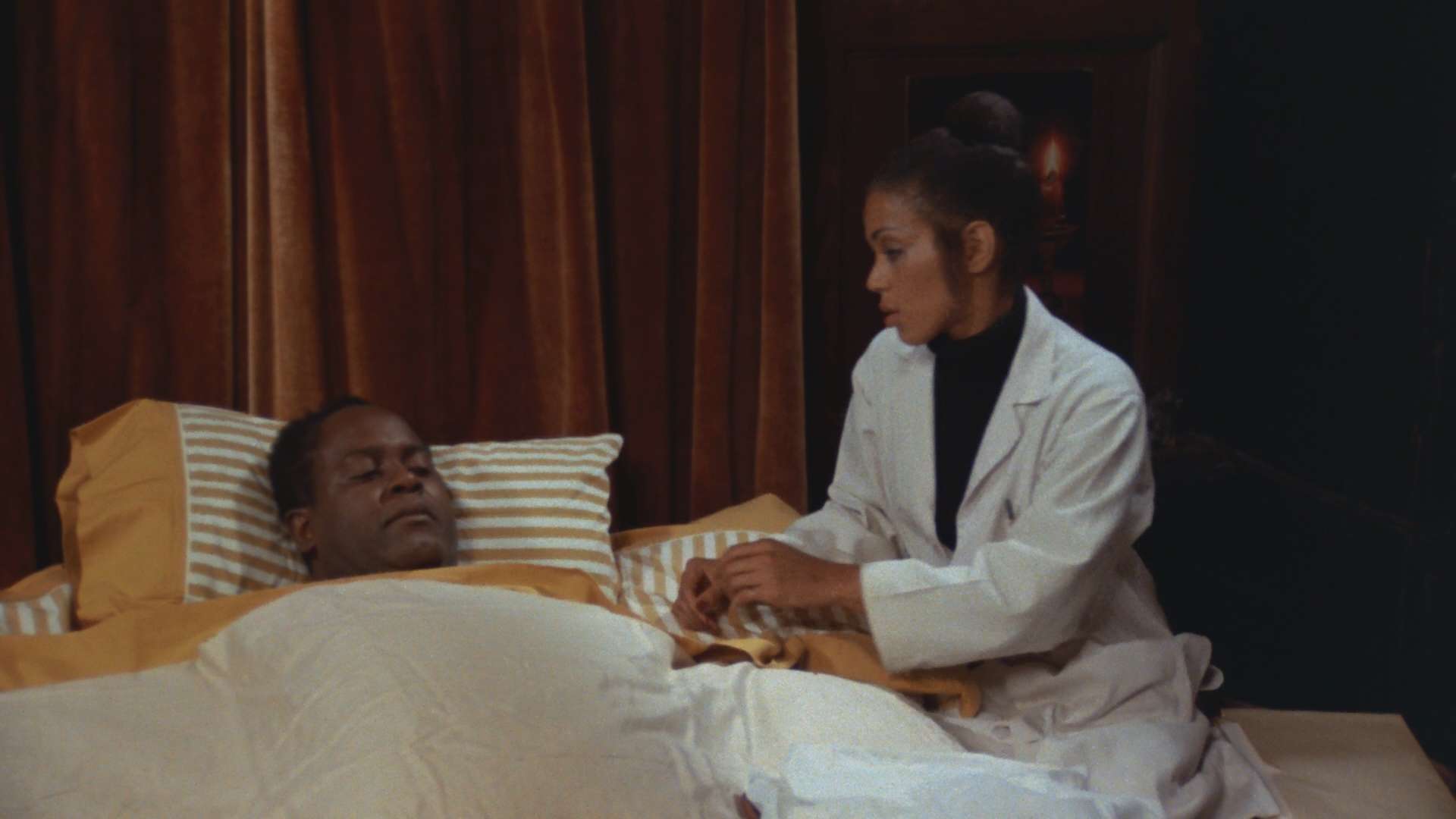
"Dr. Stein" is a brilliant surgeon who attaches new arms and legs on "Eddie" and will be able to give them life through a special DNA serum. That serum has made one women look fifty when she's really ninety, but "Dr. Stein's" evil assistant, "Malcomb" wants "Dr. Walker". To make "Dr. Stein" look bad to her. "Malcomb" switches the DNA serum and "Eddie" has become a monster.
"Eddie" will kill "Dr. Stein" and "Malcomb", played by Roosevelt Jackson, and get torn to pieces, his arms and legs pulled off, by Police Doberman's at the film's conclusion


My article "BLAXPLOITATION
(BLACKSPOTITATION) Motion Pictures from a White Guy's Perspective" can
be read at:
Then there was a West German
and French co-production filmed in Italy by producer by actress Sophia Loren's then husband producer Carlo Ponti called "Flesh
for Frankenstein".
The film was released in West Germany on November 30, 1973, in France on October 7, 1974, skipped Italy until March 14, 1975 and had been shown in the United States, Rated "X", on March 17, 1974 as "Andy Warhol's Frankenstein". Even though the artist wasn't involved with the production, but the director Paul Morrisey was a friend. The picture actually opened in 3-D in the United Kingdom sometime during 1975. On re-release the picture would be downgraded to "R" in the United States also in 3-D.
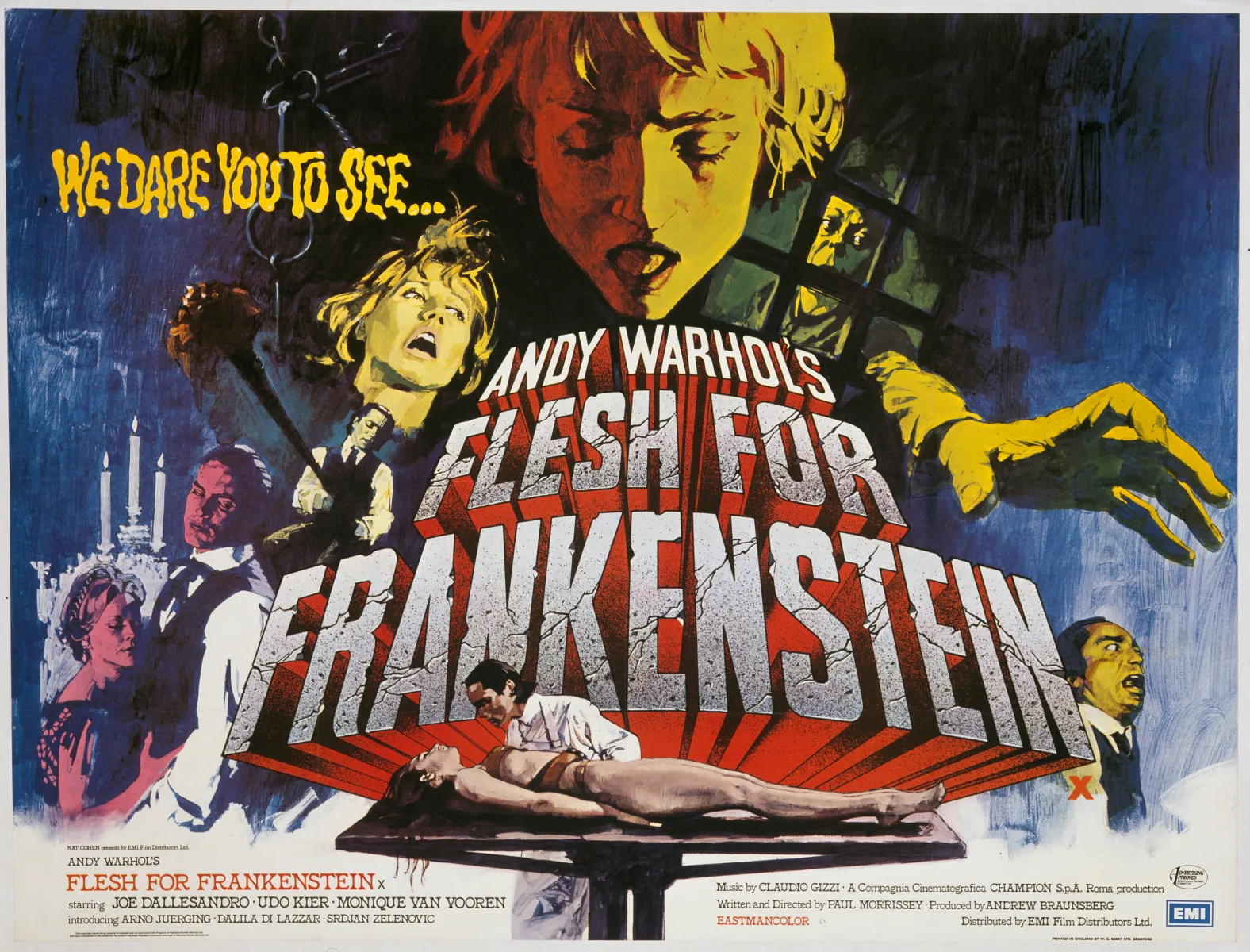

The film was full of blood that made the Hammer series tame and lots of nudity. The 3-D versions had body parts flying out into the auidence. As "Baron von Frankenstein", played by Udo Kier, and his wife Baroness Katrin Frankenstein", played by Monique van Vooren, create a male and female monster to mate and create a master race.
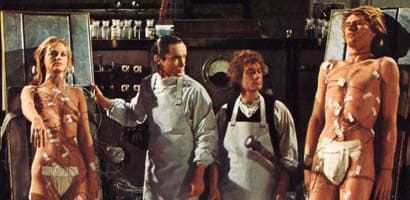

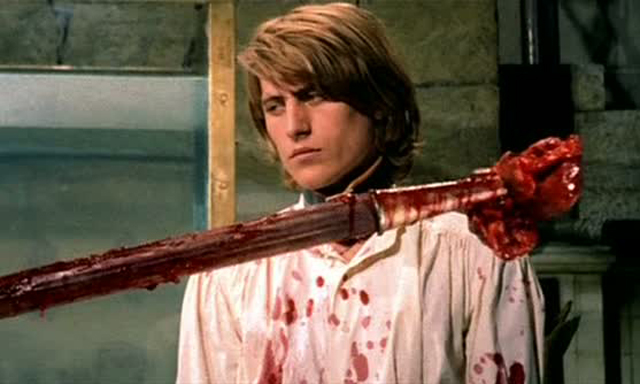
The film was released in West Germany on November 30, 1973, in France on October 7, 1974, skipped Italy until March 14, 1975 and had been shown in the United States, Rated "X", on March 17, 1974 as "Andy Warhol's Frankenstein". Even though the artist wasn't involved with the production, but the director Paul Morrisey was a friend. The picture actually opened in 3-D in the United Kingdom sometime during 1975. On re-release the picture would be downgraded to "R" in the United States also in 3-D.


The film was full of blood that made the Hammer series tame and lots of nudity. The 3-D versions had body parts flying out into the auidence. As "Baron von Frankenstein", played by Udo Kier, and his wife Baroness Katrin Frankenstein", played by Monique van Vooren, create a male and female monster to mate and create a master race.



Although the critics
such as Nora Sayre of the New York Times, May 16, 1974, panned the
picture.
In a muddy way, the movie attempts to instruct us about the universal insensitivity, living-deadness and the inability to be turned on by anything short of the grotesque. However, this 'Frankenstein' drags as much as it camps; despite a few amusing moments, it fails as a spoof, and the result is only a coy binge in degradation.
In 2018 it still held a 92% fresh
rating on "Rotten Tomatoes".
http://www.bewaretheblog.com/2015/04/abbott-and-costello-meet-universal.html
On December 15, 1974 the great Comic Producer Mel Brooks released:

The motion picture was a "Homage" to the 1931 "Frankenstein", 1935 "Bride of Frankenstein" and 1939 "Son of Frankenstein". The picture was directed and co-written by Mel Brooks.
Gene Wilder
portrayed "Dr. Frederick Frankenstein (Pronounced
"Fronkensteen"). Wilder was also Mel Brook's co-screenplay
writer. Wilder was a hit in the Mel Brooks 1967 movie "The Producers" and his musical talent had been heard in 1971's "Willy
Wonka and the Chocolate Factory". Also, in 1974 Gene Wilder had portrayed Cleavon Little's "Sheriff Bart's" gunfighter sidekick "Jim" in
Mel Brooks' attack on "B" Westerns "Blazing
Saddles".
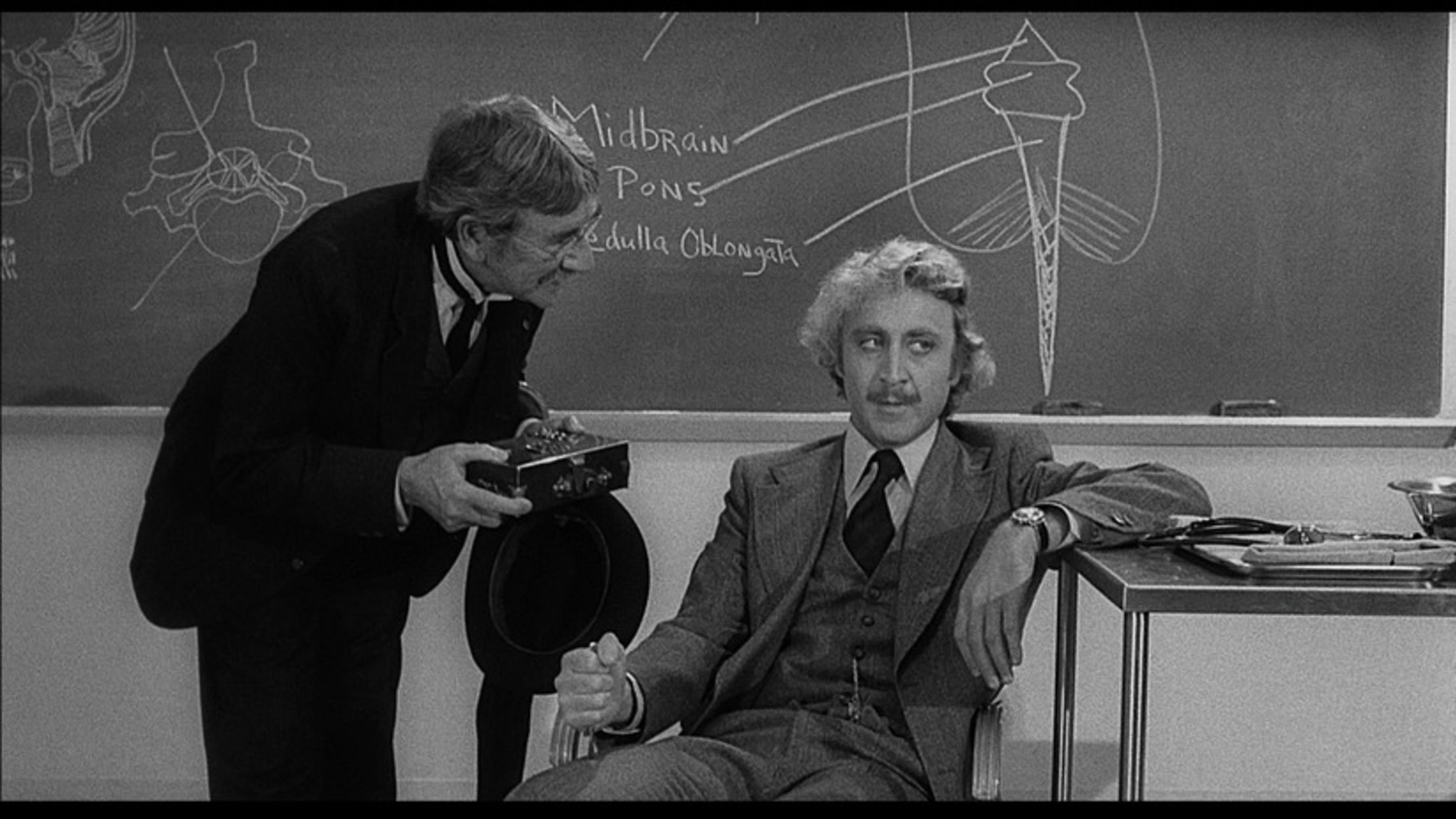
Above Wilder with Richard Haydn as the lawyer "Herr Gerhardt Falkstein".

Above Wilder with Richard Haydn as the lawyer "Herr Gerhardt Falkstein".
Peter Boyle portrayed "The Monster" and I’m sure Boris Karloff never thought of the monster singing and tap dancing. Character actor Boyle played a bigoted factory worker in 1970's "Joe" and a snitch who owns a local bar in Robert Mitchum's 1973 "The Friends of Eddie Coyle". Just before this picture Peter Boyle portrayed gangster "Joey Gallo" in 1974's "Crazy Joe". From 1996 through 2005, Peter Boyle portrayed "Frank Barone" on 210 episodes of the television comedy "Everybody Love Raymond".

Marty Feldman portrayed "Igor" pronounced "I-gor". Unlike Dwight Frye's hunchback, A running gag has Marty Feldman's hump move changes sides on his back depending upon the scene. British comedian Feldman, with those egg like eyes, was heard on BBC Radio and many programs on both Granada TV and ITV. In 1976 the comedian appeared in another Mel Brooks film the silent "Silent Movie".
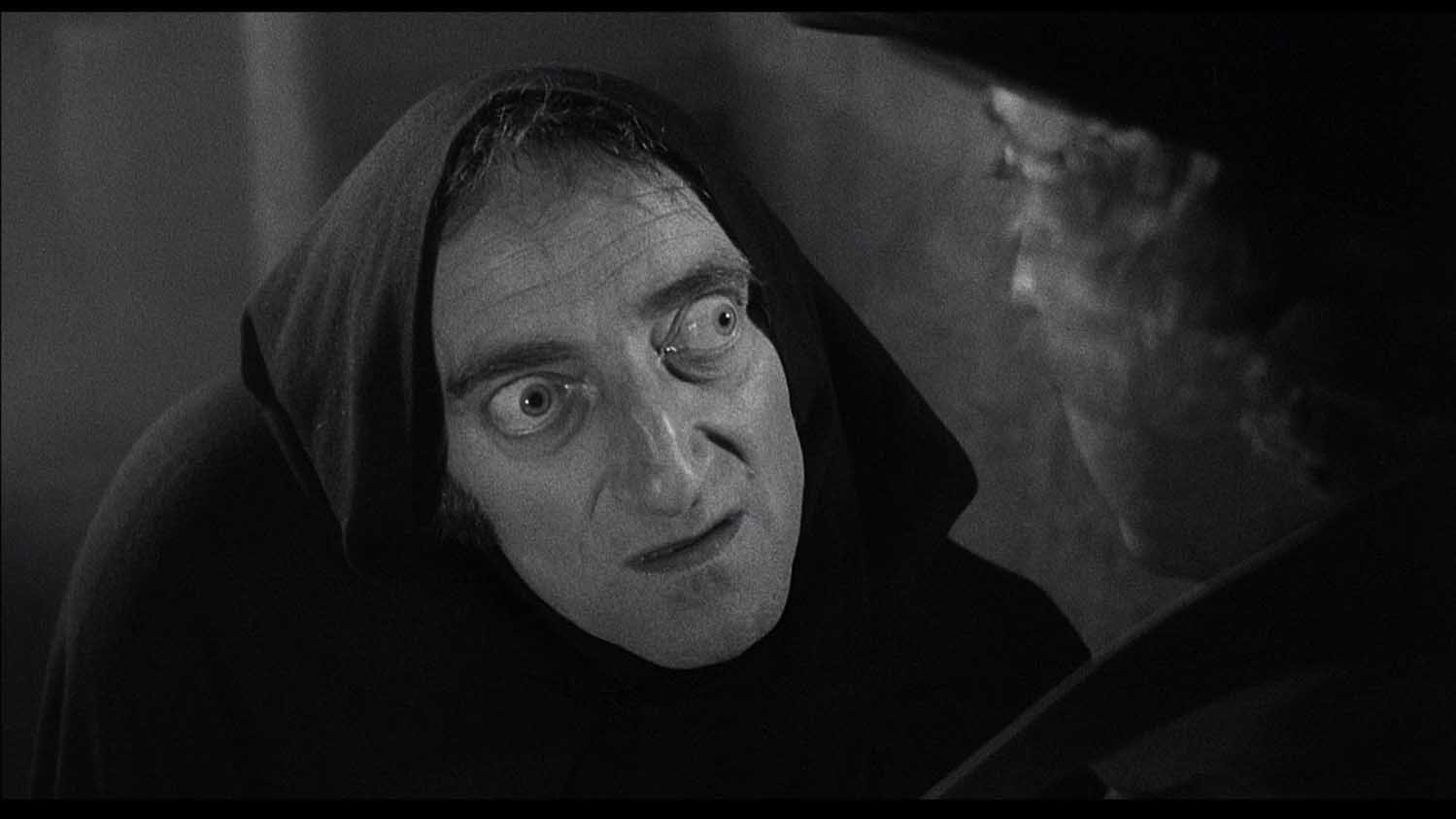
Madeline Kahn portrayed the very rich "Elizabeth". By the film's end she is married to the monster and becomes his bride. Comedian Kahn had appeared in director Peter Bogdanovich's 1973 "Paper Moon" starring Ryan O'Neal and his daughter Tatum. In 1974, like Gene Wilder, Madeline Kahn had appeared in Mel Brooks' "Blazing Saddles" and after this picture she appeared with both Wilder and Marty Feldman in the Gene Wilder directed 1975 "The Adventure of Sherlock Holmes' Smarter Brother". For Sherlockian's that is not "Mycroft". In 1977 the comedian was back in another film by Mel Brooks, "High Anxiety", with Cloris Leachman.


Teri Garr portrayed "Inga". Garr started acting, mostly without on-screen credit, in 1963. She appeared as a "Dancer" in five Elvis Presley movies: 1963's "Fun in Acapulco", 1964's "Viva Las Vegas", "Kissin' Cousins" and "Roustabout" and also 1967's "Clambake". Blink and you'll miss her in the February 2, 1966 episode of television's "Batman" entitled "Instant Freeze" and the same goes for the March 29, 1968 episode of the original "Star Trek" entitled "Assignment: Earth". In 1972 Teri Garr played various comic characters in 12 episodes of "The Sonny and Cher Comedy Hour" and you get the idea of her career until this motion picture.

Kenneth Mars portrayed "Inspector Kemp". A parody of Lionel Atwill's "Inspector Krough" in 1939's "Son of Frankenstein". Mars co-starred with Gene Wilder and Zero Mostel in 1967's "The Producers" and although he appeared in several television shows and movies. Between 1980 and 2008 Mars did animation voice work. For example Mars voiced "King Triton" in Walt Disney's "Little Mermaid", voiced characters on "The Fonz and the Happy Days Gang", the animated "Laverne and Shirley in the Army", both the original "Duck Tales" and "Dark Wing Duck", "The New Scooby-Doo Mysteries" and "The Flintstone Kids".

Above Kenneth Mars in "Young Frankenstein" with Gene Wilder and below Lionel Atwill with Basil Rathbone in "Son of Frankenstein".

At the time of filming "Young Frankenstein". It was discovered that Universal Studios still had some of the original laboratory equipment made by electrician and set designer Kenneth Strickfaden for the original 1931 "Frankenstein". Mel Brooks incorporated the find into his picture.

Gene Hackman portrayed "The Blind Man" from "The Bride of Frankenstein". Two years earlier Hackman led people to safety in Irwin Allen's 1972 "The Poseidon Adventure" and a year after this picture. Hackman was again "Popeye Doyle" in 1975's "The French Connection II".

For the scene between the blind man and the monster. Brooks turned Hackman loose in a classic comedy sequence. Blind Hackman pours soup on Boyle's monster.

When they do the cigar smoking scene. Brooks has Hackman light Boyle's finger instead of the cigar.
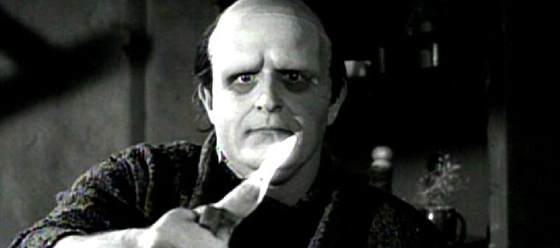
Another classic scene in the 1931 motion picture got the Brooks and Wilder treatment. "I-gor" goes to get the brain for the monster, drops the one he was supposed to bring, and returns with the "Abnormal Brain". When questioned by Wilder as to what brain he placed in the monster? Fieldman replies "Abby Something" that leads to the name on the brain as "Abby Normal".

Of course there's that tap dancing routine to "Putin' On the Ritz".
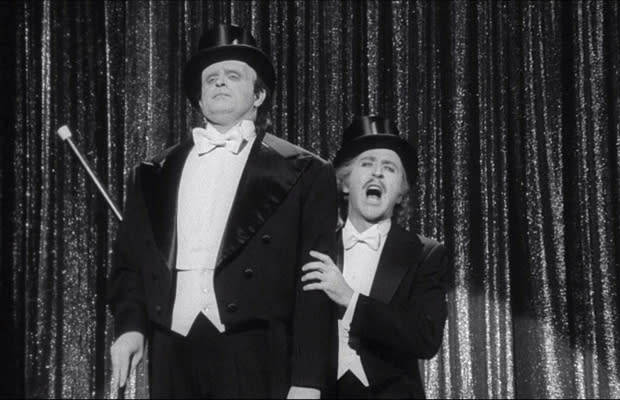
As I mentioned at the end of the picture "Elizabeth" ended up not murdered by the monster, but married to him. After he had a brain transference with "Frederick Frankenstein" to save him from the villagers.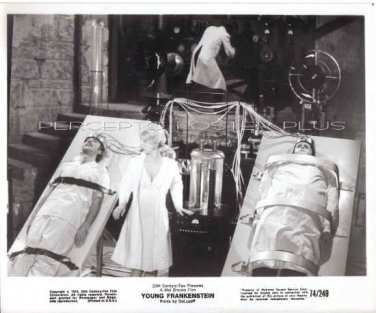
Below Boyle and Kahn as "Mr. and Mrs. Monster".
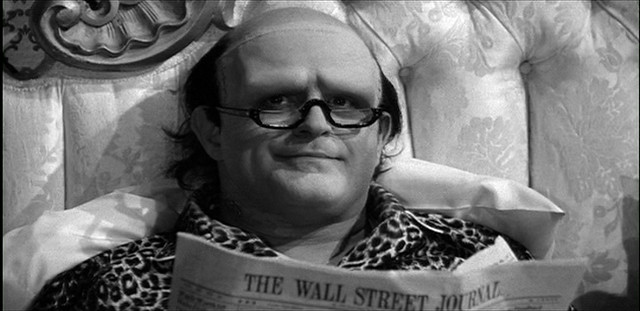

Below Boyle and Kahn as "Mr. and Mrs. Monster".

While Garr and Wilder end up together with "Frederick" picking up an enlargement from his monster after the brain transference.
Produced by Executive Producer Francis Ford Coppola, 1972's "The Godfather" and 1979's "Apocalypse Now", and released on November 4, 1994 was:

The motion picture was originally released as "Frankenstein", but a decision was made to rename the finished feature as "Mary Shelley's Frankenstein". So that potential audiences would know this was her story and not some Hollywood made-up "Frankenstein" film. Such as 1965's "Frankenstein Meets the Space Monster". Francis Ford Coppola had done the same trick with 1992's "Bram Stoker's Dracula".
The motion picture was directed by Kenneth Branagh. Branagh has been compared to Sir Lawrence Olivier, because both men would act and direct many of their own feature films and loved Shakespeare. Among Kenneth Branagh Shakespearean acting roles has been 1989's "Henry V", 1995's "Othello" and 1996's "Hamlet". While most audiences know Kenneth Branagh as "Professor Gilderoy Lockehart" in 2002's "Harry Potter and the Chamber of Secrets".
For this picture Kenneth Branagh was doing double duty. As he also portrayed "Victor Frankenstein". The actor would be nominated for a "Saturn Award" from the "Academy of Science Fiction, Horror and Fantasy Films" for Best Actor.
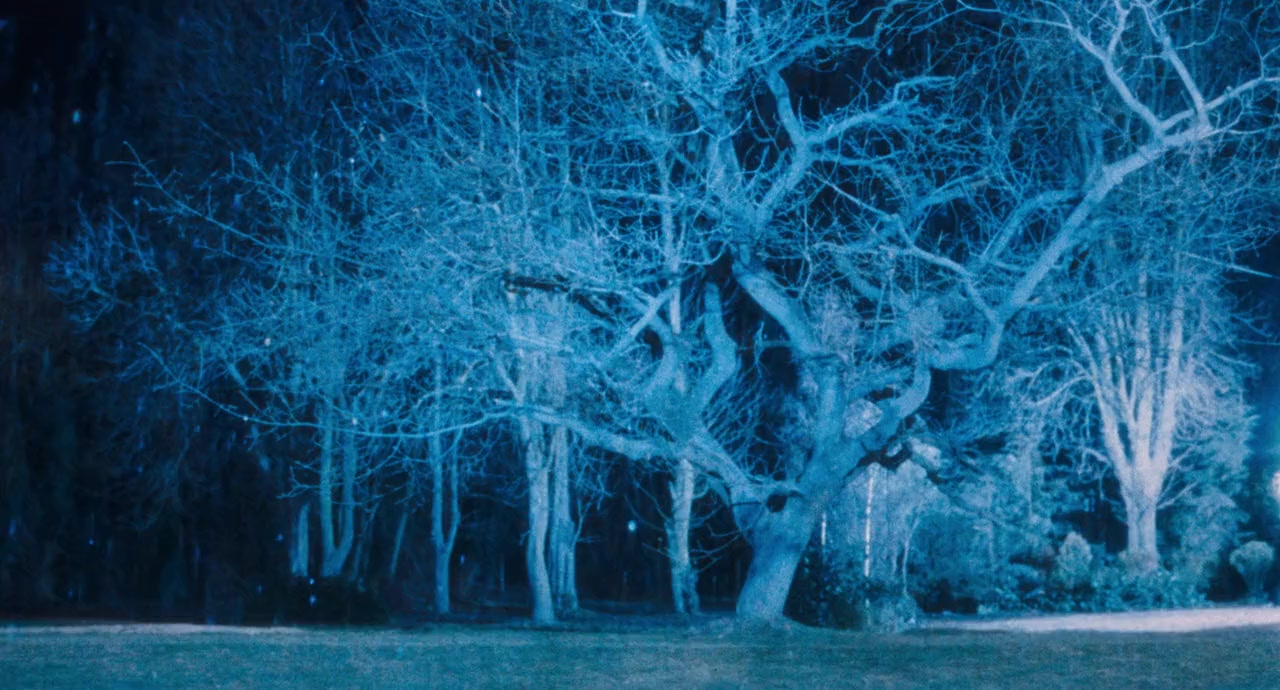
The screenplay was written by Frank Darabont. His screenplays include 1987's "A Nightmare on Elm Street 3: The Dream Warriors" and in 1988 Darabont updated the classic 1958 "The Blob". The following year he wrote the screenplay for "The Fly II" and, the same year as this motion picture, Frank Darabont wrote the screenplay for "The Shawshank Redemption".
However, he wasn't completely pleased with the movie as finally released by Kenneth Branagh. In an April 27, 2016 interview with Erik Bauer. Darabont said:
There's a weird doppleganger effect when I watch the movie. It's kind of like the movie I wrote, but not at all like the movie I wrote. It has no patience for subtlety. It has no patience for the quiet moments. It has no patience period. It's big and loud and blunt and rephrased by the director at every possible turn. Cumulatively, the effect was a totally different movie. I don't know why Branagh needed to make this big, loud film ... the material was subtle. Shelley's book was way out there in a lot of ways, but it's also very subtle. I don't know why it had to be this operatic attempt at filmmaking. Shelley's book is not operatic, it whispers at you a lot. The movie was a bad one. That was my Waterloo. That's where I really got my ass kicked most as a screenwriter ... [Branagh] really took the brunt of the blame for that film, which was appropriate. That movie was his vision entirely. If you love that movie you can throw all your roses at Ken Branagh's feet. If you hated it, throw your spears there too, because that was his movie.
I could not locate any information on the listed co-writer Steph Lady. He has only this film as a writer and shows up as a co-producer, out of six, of the 1998 "Dr. Doolittle". When speaking of the screenplay for "Mary Shelley's Frankenstein". Reviewers only mention Frank Dabont and I wonder, if Steph Lady was brought in to make some last minute changes to the screenplay which Dabont objected too.
Robert De Niro portrayed "The Creature". De Niro's 7th on-screen appearance was for producer/director Roger Corman as "Lloyd Barker" in 1970's "Blood Mama". That film starred Shelley Winters as 1930's gangster "Ma Barker". In 1973 the actor made an impact with two feature films: "Bang the Drum Slowly" and "Mean Streets". The following year De Niro portrayed the young "Vito Corleone"in Francis Ford Coppola's "The Godfather II" and followed that with his harrowing performance as "Travis Bickle" in 1976's "Taxi Driver".
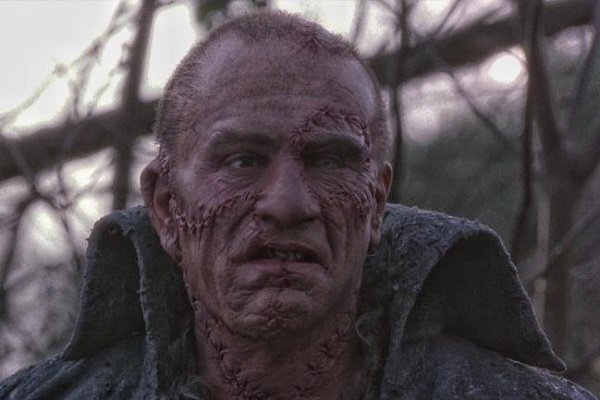
Robert De Niro was nominated for the Best Supporting Actor "Saturn Award".
Tom Hulce portrayed "Henry Clerval". Mention "National Lampoon's Animal House" and 8th billed John Belushi's name immediately comes up, but Tom Hulce was actually the lead actor. Hulce is remembered for portraying the title role in 1984's "Amadeus" and is known, to Disney fans, as the voice of "Quasimodo" in the two animated "The Hunchback of Notre Dame" features.

Tom Hulce on the left and Kenneth Branagh.
Helena Bonham Carter portrayed "Elizabeth Lavenza Frankenstein". Her third feature film was also Bonham Carter's first starring role in the historical biography "Lady Jane" in 1986. However, it was a series of motion pictures made by her, then, husband director Tim Burton that she is more known. These include the 2001 remake of "Planet of the Apes", 2005's "Charlie and the Chocolate Factory", 2005's "The Corpse Bride", 2007's "Sweeney Todd: the Demon Barker of Fleet Street" and 2010's "Alice in Wonderland". Not to forget her role as the purely evil "Beatrix Lestrange" in the "Harry Potter" movies, or playing "Queen Elizabeth" in 2010's "The King's Speech". For which she was nominated as "Best Supporting Actress" for the "British Academy Film Television Award (BAFTA)", or portraying "Ophelia" to Mel Gibson's "Hamlet" in 1990.

Above Helena Bonham Carter and Kenneth Branagh.
John Cleese portrayed "Professor Shmael Augustus Waldman". Cleese was one of the creators of the BBC's "Monty Python" and appeared in their flipping of the "King Arthur Legend". The hilarious 1975 "Monty Python and the Holy Grail" and the groups biblical epic, from 1979, "The Life of Brian". In 1981 John Cleese was "Robin Hood" in co-Monty Python's Terry Gilliam's "The Time Bandits".

Above John Cleese as "Professor Waldmann".
The film opens in 1794 with a sailing ship stuck in the Arctic ice flow and the crew spotting a man walking on the ice. He comes on board and "Victor Frankenstein" starts to relate his story to "Captain Walton".
"Victor" grew up in Geneva with his adopted sister "Elizabeth Lavenza" and the two fell in love. Before leaving for the University, in Igolstadt, his mother dies giving birth to "Victor's" brother "William". At the University "Victor" meets "Henry Clerval" and the two have "Professor Waldman" as a science teacher. "Waldman" has been working on a way to create life. He warns "Victor" abd :Henry" to never use his notes on the subject, because they may create an abomination of nature.
While giving vaccines for a cholera epidemic, that is spreading across Europe, a patient goes wild and kills the professor. "Victor" decides to use the Professor's notes to create life. "Elizabeth" arrives to take "Victor" back to Geneva, before Igolstadt goes under quarantine for cholera, but she finds an obsessed man and this forces her to leave him.

"Victor" uses parts of other bodies to create a new one and then places "Professor Waldman's" brain inside his creation. Then the obsessed "Frankenstein" brings it to life.



Realizing the mistake he has made by not listening to the "Professor Waldman's" warning. "Victor Frankenstein" attempts to kill his creation with an axe. This fails and the creature escapes into the countryside wearing "Victor's" coat. While looking for food the townspeople drive him away, because of their fright. The creature finds refuge in a farmer's barn without the family knowing he's there.
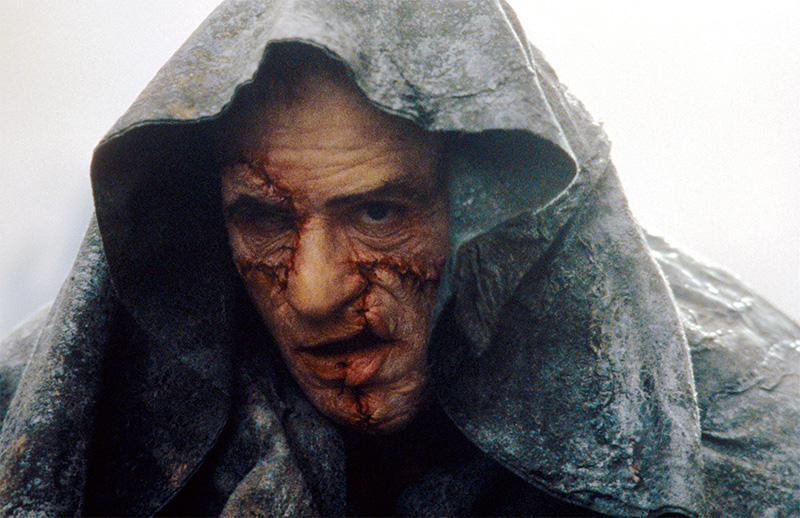
In the barn the brain of "Professor Waldman" starts to teach the creature how to speak and read. The creature has found "Victor Frankenstein's" journal in a coat pocket and now learns of his own creation. While all of this is happening the creature is anonymously helping with the farm, but when he kills a blind man. The farm family leaves afraid they will also be killed. Next the creature burns the farm down and vows revenge on his creator. Married to "Elizabeth", "Victor" believes the creature died in the cholera epidemic.
The creature starts his revenge by murdering "William Frankenstein". This causes a lynch mob to be formed that believes the "Frankenstein" maid, "Justine", murdered "William". Before a defense can be made the mob hangs her.

The creature now abducts "Victor" and promises to leave the other alone, IF he makes a mate for him. "Victor" agrees, but then changes his mind. The creature now murders "Elizabeth" by reaching into her body and pulling out her heart.

"Victor" now takes the body of "Justine", attaches the head of "Elizabeth", and brings her to life again.


The new "Elizabeth" seems happy with "Victor" until the creature arrives and the two start to fight over her.

Realizing what she is, "Elizabeth" sets herself on fire and commits suicide. Now the pursuit to the Arctic begins between "Victor" and the creature. The film returns to "Victor Frankenstein" ending his story to "Captain Walton" and dying from pneumonia. As the crew prepares to burn his body the creature appears. "Captain Walton" offers to take the creature with his ship out of the Arctic. Instead the creature decides to stay. The ship is now freed from the ice flow and as it the sails away the creature sets "Victor" and himself on fire,
In 1984, the previously mentioned Tim Burton, directed a 30 minute short for the Walt Disney Company that he had written with Lenny Ripps. This was a homage to James Whales 1931 "Frankenstein" and was about a young boy named "Victor Frankenstein" played by Barrett Oliver. Who was "Bastian" in 1984's "The NeverEnding Story".
"Victor's" dog "Sparky" is hit by a car and dies.


Now "Victor" brings "Sparky" back to life using electricity.
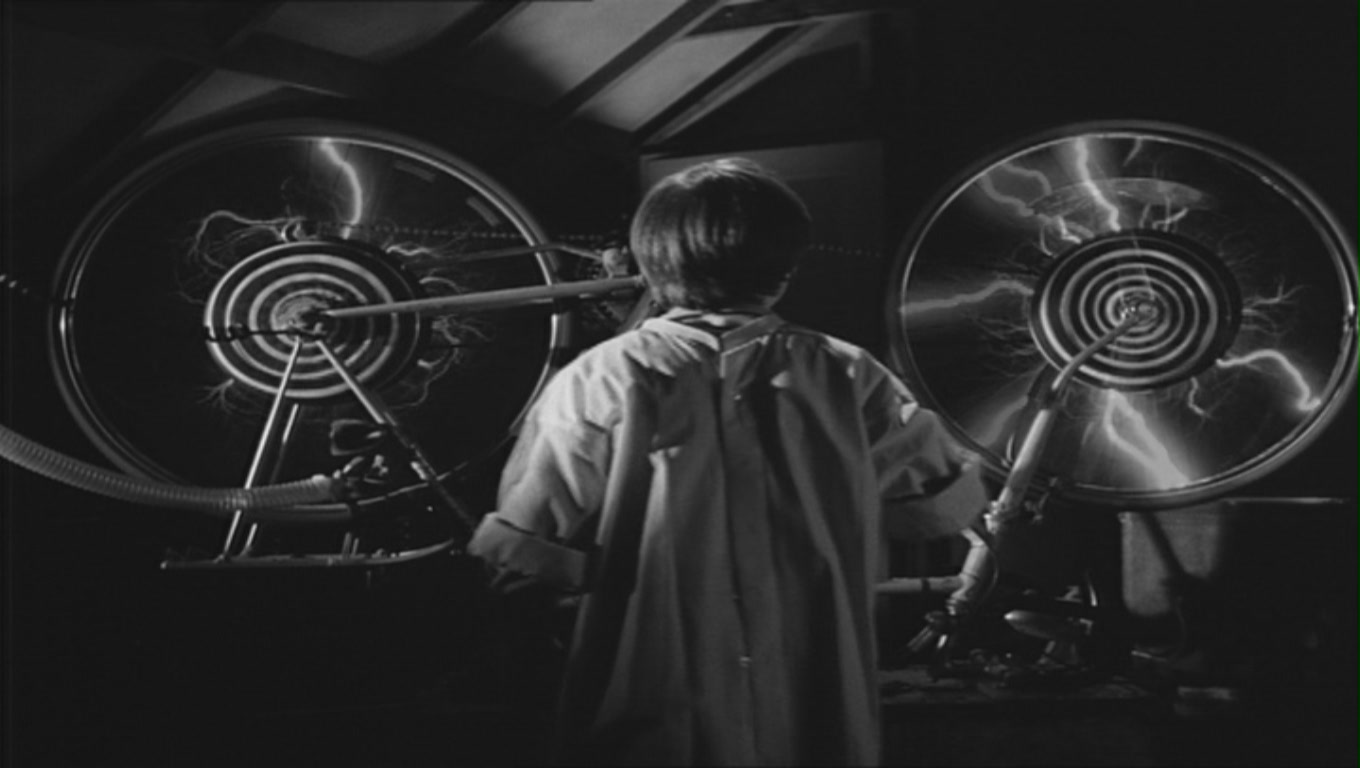

The neighbors are frightened of "Sparky" and he runs away with "Victor" in pursuit. The two end up at a miniature golf course with a "Windmill" hole. The angry neighbors show up and the windmill is set on fire.
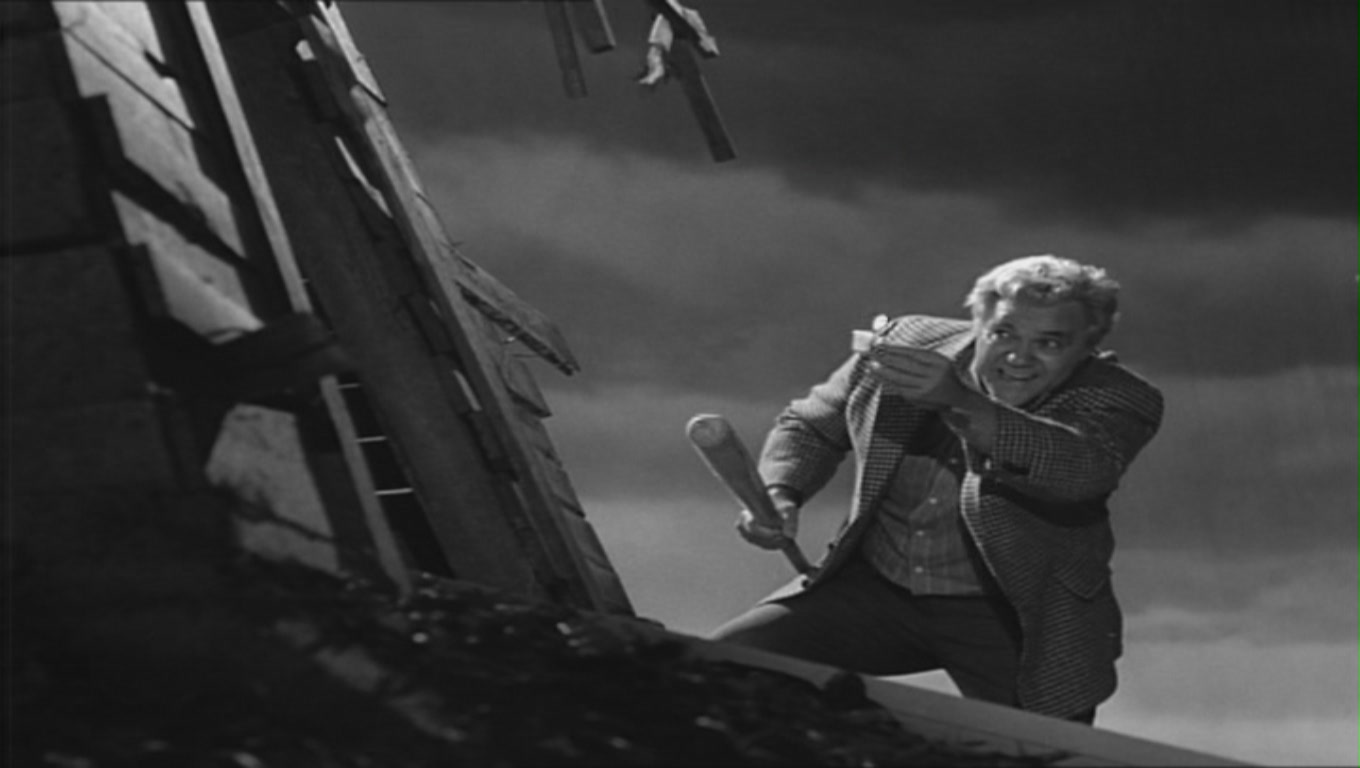
"Victor" is accidentally knocked out and the flames come close to him as the neighbors look on. "Sparky" springs into action and pulls "Victor" to safety.
/_derived_jpg_q90_600x800_m0/Frankenweenie-1.jpg?partner=allmovie_soap)
The neighbors realize their mistakes about the dog and he is accepted.
On September 20, 2012 Tim Burton brought back "Frankenweenie" as an 87 minute long stop motion animated film.
The screenplay was expanded by Burton and John August. August had written three other screenplays for Tim Burton. In 2005 they was "Charlie and the Chocolate Factory" and the "Corpse Bride". While in 2012 John August wrote "Dark Shadows".
The main voice cast included:
Catherine O'Hara was "Susan Frankenstein", "Weird Girl" and the "Gym Teacher".Martin Short was "Mr. Frankenstein", "Mr. Burgemeister" and "Nassor".
Martin Landau voiced Science Teach "Mr. Rzykruski".
Charlie Tahan was "Victor Frankenstein".
Atticus Shaffer was "Edgar 'E' Gore".Winona Ryder was "Elsa Van Helsing".

Above left to right are students "Elsa Van Helsing", "Victor Frankenstein" in the back and "Edgar 'E' Gore".
The main story line has "Victor's" pet dog "Sparky" being killed by a car and being brought back to life. The main villain in that story line is now the evil psychic cat "Mr. Whiskers".
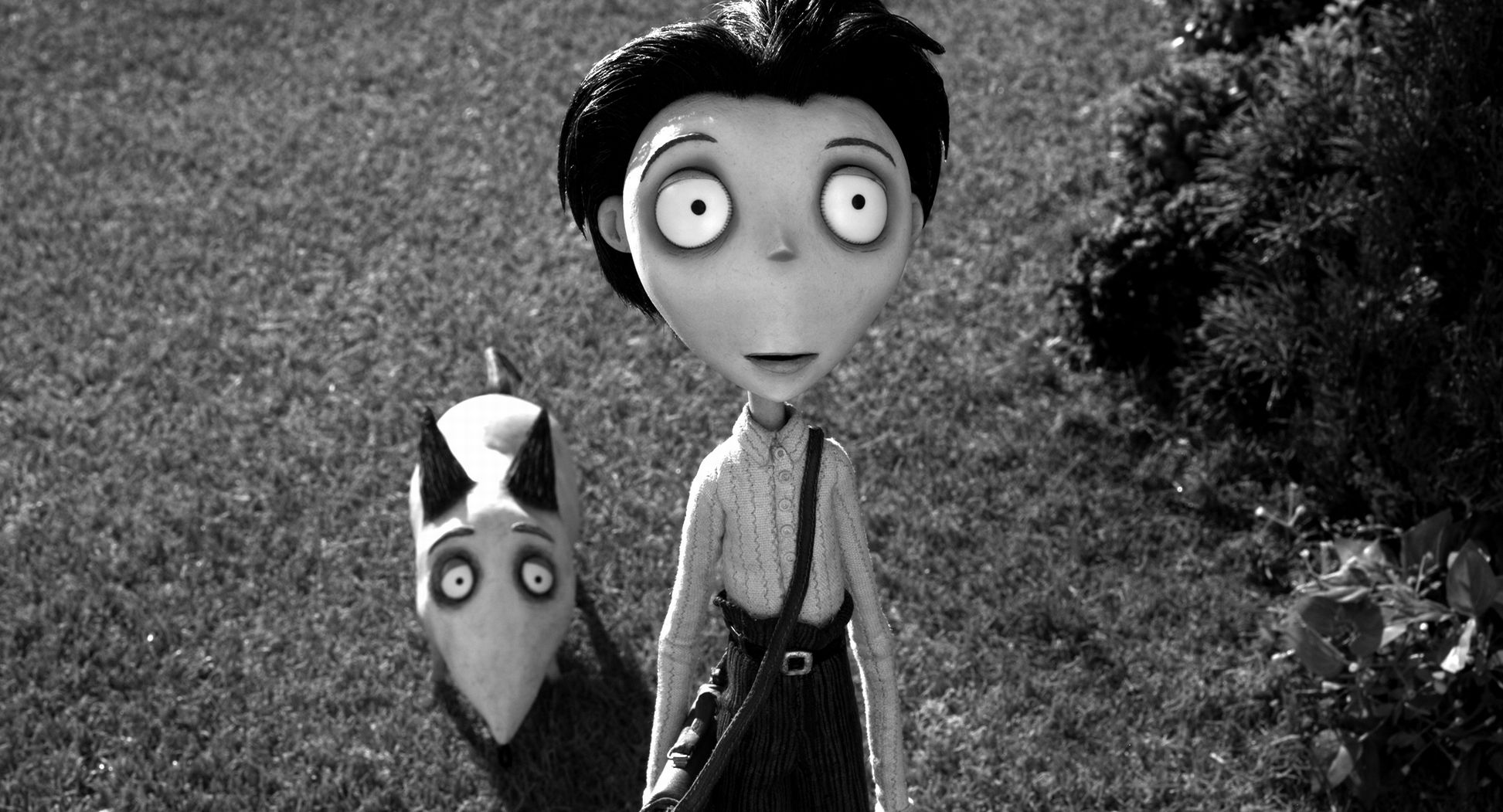
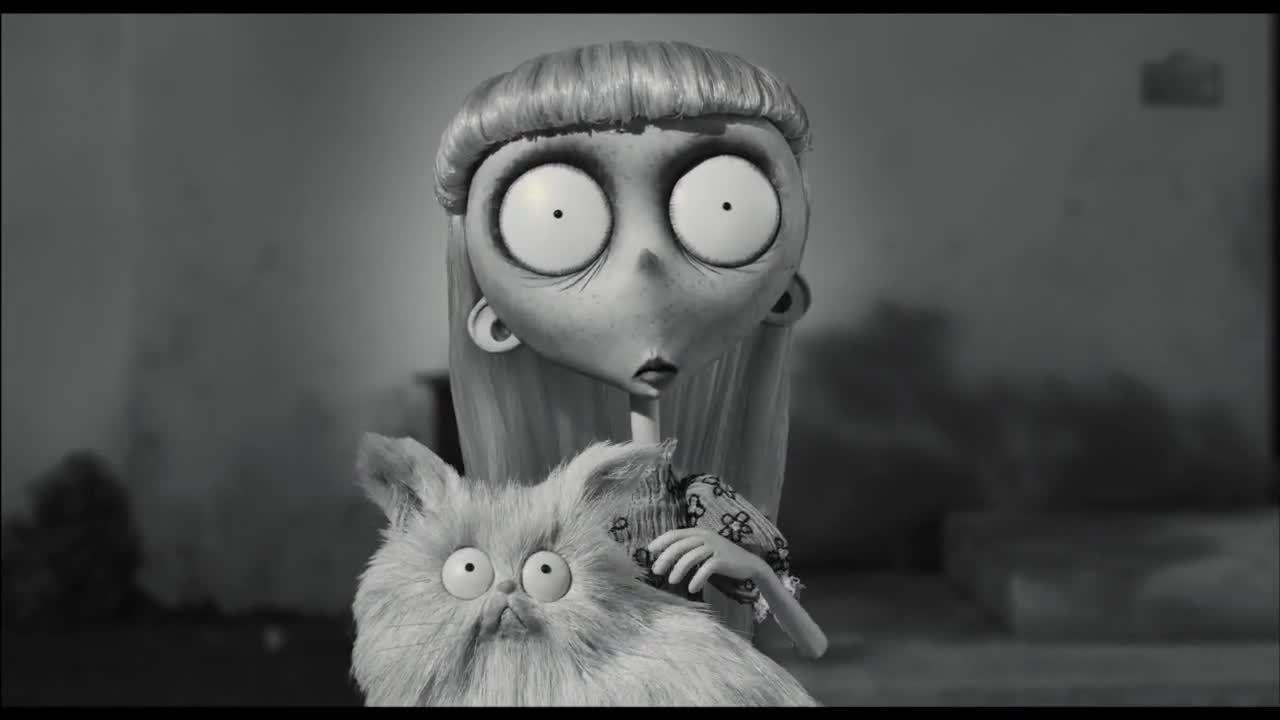


At the end of the picture "Sparky" and "Victor" rescue "Elsa" and "Persephone" from a burning "Windmill". As a result "Persephone" becomes the dog version of 1935's "The Bride of Frankenstein".

But Tim Burton doesn't stop with redoing the original 1984 short and with John August go after other classic Horror movies.
Here are some of the obvious references to classic Horror Films and maybe one you may not have gotten.
The obvious reference to "Dracula" is "Elsa" last name, but what about her French Poodle "Persephone"? In 1959 William Castle released "The Tingler" in "Percepto".
When the other students get involved there are some great bits. Take the Japanese student "Toshiaki's" pet turtle "Shelley", as in "Mary Shelley", that is turned into Daiei Studios "Gamera".
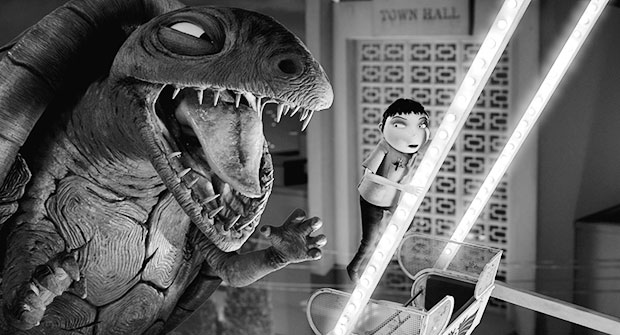
Then you have "Edgar 'E' Gore" turning a dead rat into a "Wererat".
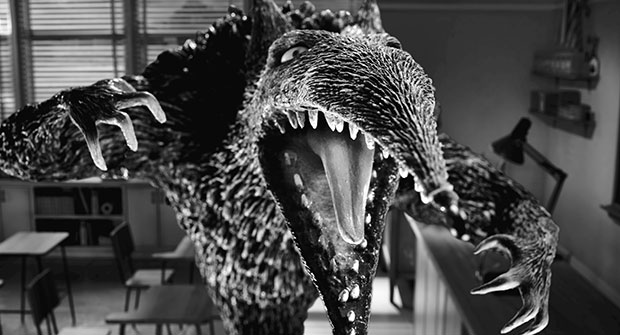
Or, Egyptian "Nassor", creating a "Mummy Hamster".
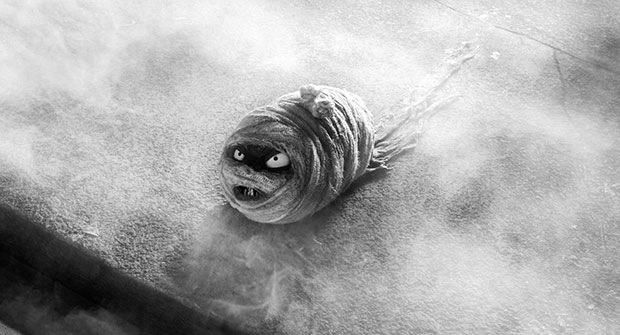
I will not go into the many subtle references as in "Persephone's" name, but take another look at "Frankenweenie".

The film was directed and written by Australian Stuart Beattie. Beatte had only directed one other motion picture, 2012's, "Tomorrow, When the War Began", an Australian/New Zealand futuristic story based upon a Australian series of books. Stuart Beatte wrote the screen stories for the Disney "Pirates of the Caribbean" motion picture series. In 2009 he had written the screenplay for "G.I. Joe: the Rise of Cobra".
The co-writer and the creator of the digital-graphic novel was Kevin Grevioux. Chicago born Grevioux was also an actor and had starting his screen career portraying a "Star Fleet Security Officer" in an episode of "Star Trek: the Next Generation". He would repeat that kind of role in 12 episodes of "Star Trek: Deep Space Nine". In 1995 Grevioux portrayed a "Roadblock Officer" in the feature film "Congo" and was one of "Harvey Dents Thugs" in the same years "Batman Forever", but he is probably better known for playing "Raze" in 2003's "Underworld" and 2009's "Underworld: Rise of the Lycans". In "I, Frankenstein" Kevin Grevioux had 14th billing as "Dekar".
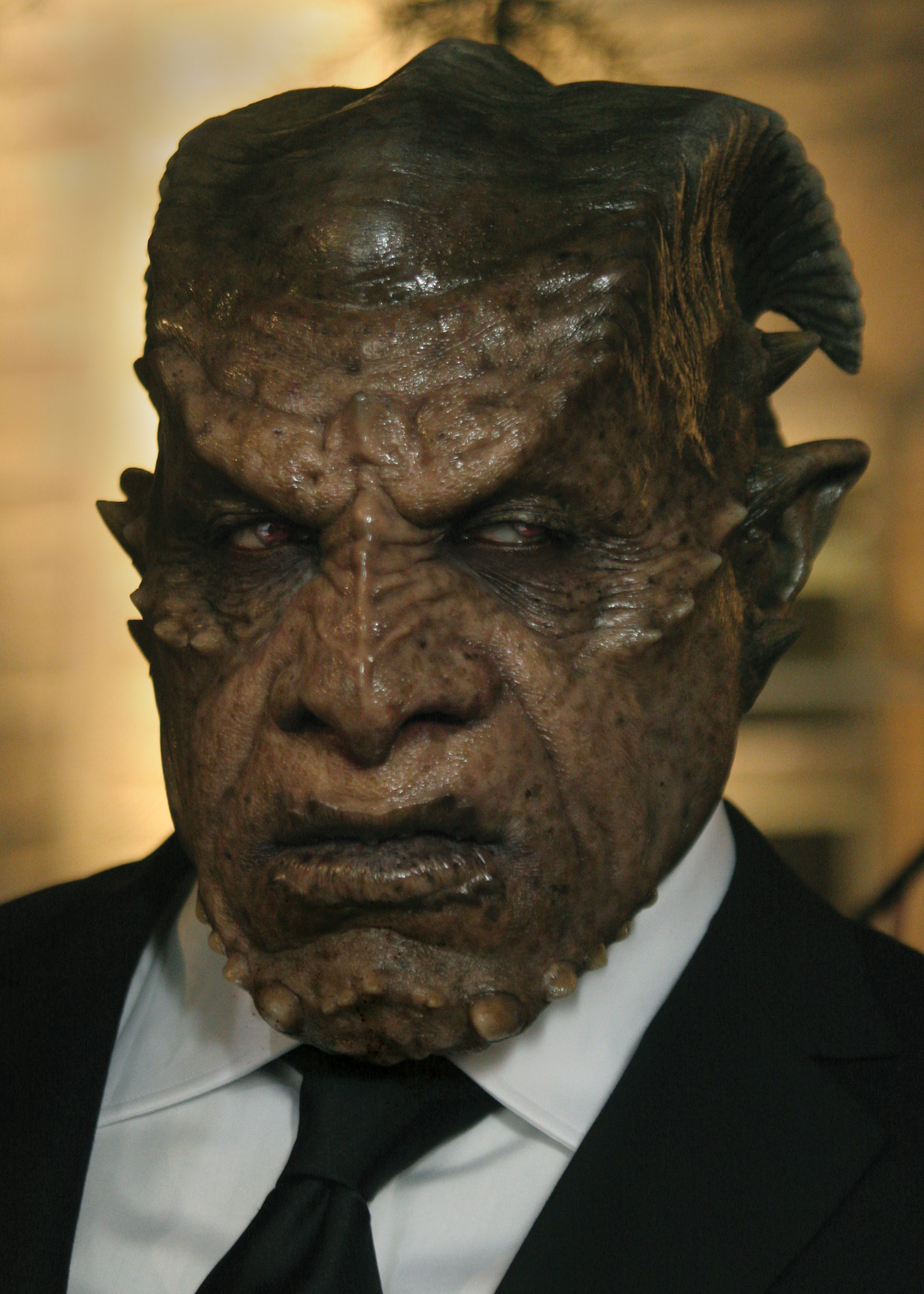
Above Kevin Grevioux as "Dekar".
Aaron Eckhart portrayed "Adam" aka: "Frankenstein's Monster". Eckhart co-starred in the 2003 Science Fiction feature "The Core". Three years later he co-starred with Scarlett Johansson and his "Core co-star" Hilary Swank in the excellent modern film-noir "The Black Dahlia". In 2008 Aaron Eckhart portrayed "Harvey Dent" aka: "Two-Face" in director Christopher Nolan's "The Dark Knight".
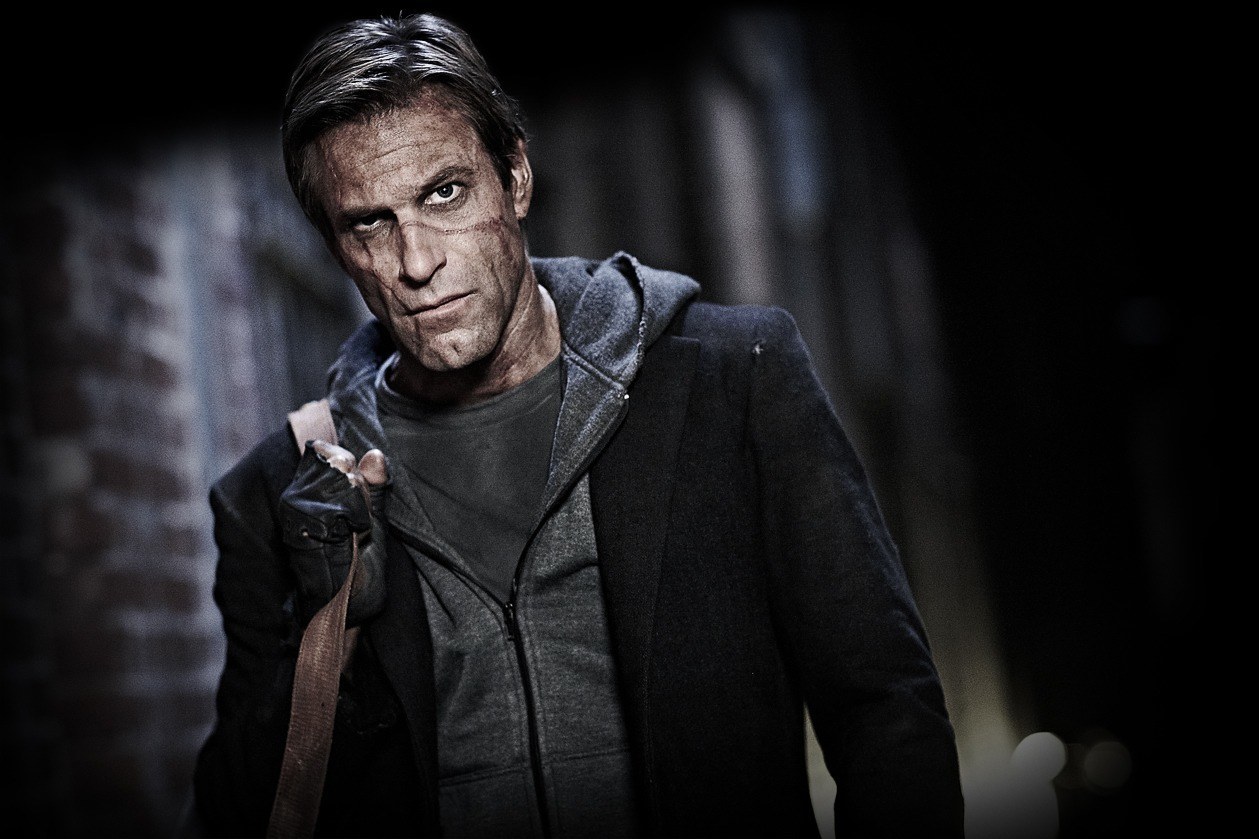
Yvonne Strahovski portrayed "Dr. Terra Wade". The Australian actress was "Hannah McKay" in 17 episodes of television's "Dexter", was "Helen Morgan" in 12 episodes of "24: Live Another Day" and "Serena Joy Waterford" in 39 episodes of "The Handmaid's Tale".

Mirando Otto portrayed "Gargoyle Queen Leonore". The Australian actress portrayed "Eowyn" in directer Peter Jackson's 2002 "The Lord of the Rings: The Two Towers" and 2003's "The Lord of the Rings: The Return of the King". The actress portrayed Tom Cruise's wife in director Steven Spielberg's 2005 version of H.G. Wells' "War of the Worlds" and she played Allison Carr" in 12 episodes of televisions "Homeland".


Above "Queen Leonore" in both her human appearance and her true gargoyle appearance.
Bill Nighy portrayed "Niberius". Outside of British television, character actor Nighy has been seen in the Robert Englund 1989 "The Phantom of the Opera", portrayed the Vampire "Viktor" in the "Underworld" series, was "Slartibartfast" in 2005's "The Hitchhiker's Guide to the Galaxy" and "Davy Jones" in "Pirates of the Caribbean: Dead Man's Chest".

The story starts in 1795 as "Dr. Victor Frankenstein", played by Aden Young, creates a soulless monster and then rejects it. Then monster in a rage kills "Victor's" wife "Elizabeth", played by Virginie Le Baun. "Victor" chases his creature to the Arctic, but dies there. The creature takes "Victor's" body and buries it within the "Frankenstein" family cemetery. Where he is then attacked by demons, but is rescued by the gargoyles "Ophir", played by Mahesh Jadu, and "Keziah", played by Caitlin Strasey.

Above Mahesh Jadu, Aaron Eckhardt, and Caitlin Strasey in the "Frankenstein" family tomb.
The two Gargoyles bring the creature to their Queen and she tells him that they were formed, by the Arch Angel Gabriel, to fight demons upon the Earth. She then bestows the name of "Adam" on the creature and invites him to join with the Gargoyles. He declines, but is presented with weapons to fight the demons that will come after him. These weapons will "Descend" the demons by destroying their bodies and sending their souls to hell.
Two Centuries end and a third begins as "Adam" "descends" demons. However, while fighting one at a night club in 2012. He kills a human police officer by mistake and is called before the Gargoyle Queen and "Adam" is chained to a chair as the Queen must decide his fate.


At the same time as the above is occurring. The demon, "Helak", played by Steve Mouzakis, reports to his leader "Naberius" that "Adam" lives. "Naberius"has been using the human disguise of billionaire business man "Charles Wessex" to carry on experimentation on re-animating dead bodies. Assisting him is "Dr. Terra Wade", who has no idea what her employer actually is, or his plans.
The demons attack the church that is the Gargoyle sanctuary. "Adam" convinces "Ophir" to release him and he fights with the Gargoyles against the demons.
"Adam" is now caught in a war between "Queen Leonore" and "Naberius".


Above "Adam" is showing "Dr. Wade" "Victor Frankenstein's" journal. Which is the one item "Naberius" has been after since before "Frankenstein" died in the Arctic..
Below "Adam" confronts the demons in their own sanctuary.

The Gargoyles also arrive.

The picture didn't do well at the box office possibly because of lack of real publicity, but it is well worth a look.
On September 9, 2017, an Australian, United Kingdom, Ireland, United States and Luxembourg co-production entitled "Mary Shelley" premiered at the Toronto, Canada, Film Festival. The film is basically the life of the authoress, but when she was still "Mary Wollstonecraft Godwin and goes to the point in her life when she started to write "Frankenstein".

For my fellow "Whovians" I will end this article with "The Haunting of Villa Diodati". The "13th Dr. Who" and her companions go back in time to Lake Geneva in 1816.

Above are left to right Tosin Cole as "Ryan Sinclair", Mandip Gill as "Yasmin Kahn", Jodie Whitaker as "The Doctor" and Bradley Walsh as "Graham O'Brien.

Above the real "Villa Didoati".
At the villa the Time Travelers meet "Mary Wollstonecraft Godwin", her husband to be "Percy Bysshe Shelley", "Mary's" child "William", "Dr. John Polidori", "Claire Clairmont" and "Lord Byron".
"Lord Byron" suggests that each of their group write a ghost story to scare the others. Historically, this is the night and place "Mary" gets her idea for "Frankenstein". However, events do no go as told and strange occurrences take place.

Above Lili Miller as "Mary Wollstonecraft Godwin", Maxim Baldry as "Dr. John Polidori", Jacob Collin-Levy as "Percy Bysshe Shelley" and Nadia Parkes as "Claire Clairmont".
"Percy" disappears, but leaves strange gibberish on the walls of his room.
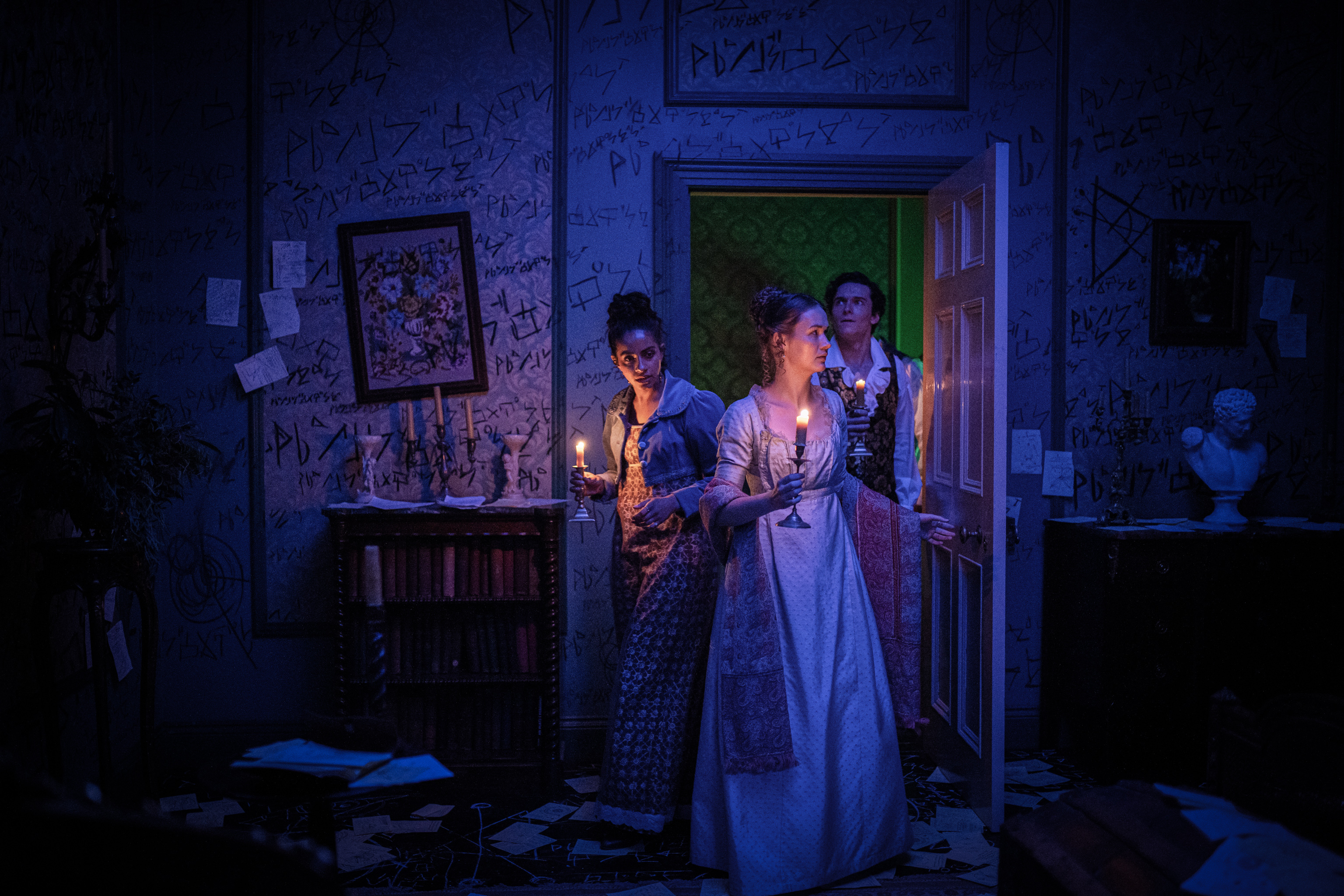
Then the rooms in the "Villa Didorati" start rearranging themselves and "Lord Byron" suggests its the villa's known ghost, but "The Doctor" suggests otherwise.

Then "William" disappears and a strange apparition is seen on the lawn.



Next, in typical "Dr. Who" form, the apparition turns out to be a time traveling "Cyberman" and he becomes the real inspiration for Mary's "Frankenstein Monster".
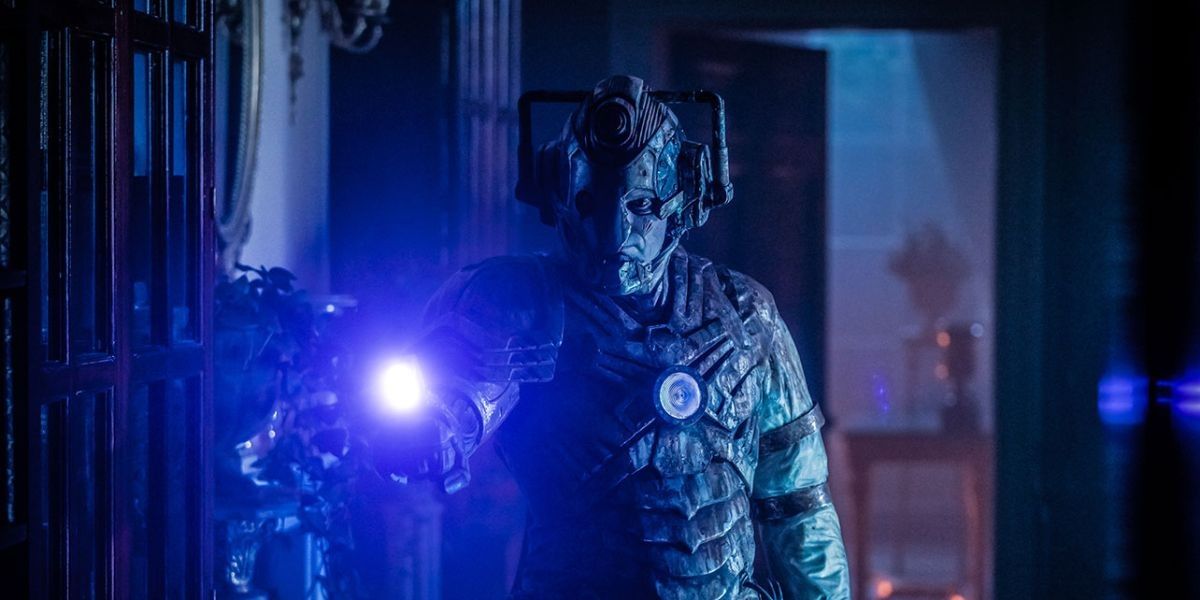

This is an excellent episode of the series that started on November 23, 1963. The day after President John Fitzgerald Kennedy was assassinated in Dallas, Texas. It is also a fitting ending for this article.














